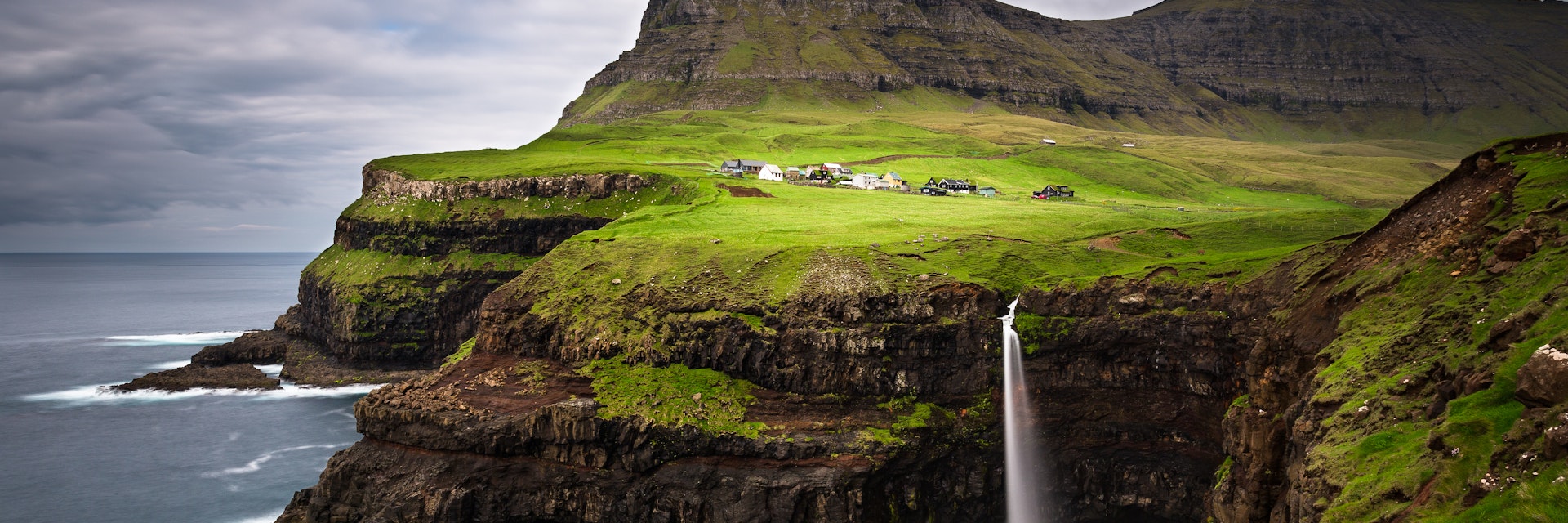
Faroe Islands
The forgotten Faroes are just a short flight from the UK, yet they’re way off the standard traveller’s radar. Adrift in the frothing swells of the north Atlantic, this mysterious 18-piece jigsaw puzzle of islands is at once ancient and very modern. Multicoloured cottages and grass-roofed wooden churches add focus to the grandly stark, treeless moorlands. Timeless networks of cairn-marked footpaths crisscross craggy layer-cake mountains. But even the tiniest once-inaccessible hamlets are now linked by a remarkable series of road-tunnels. And even as you bob around the dramatic fjords on a 70-year-old wooden sloop, your mobile phone is never likely to lose its signal.

Best Time to Visit
Best places to visit, attractions, must-see attractions.
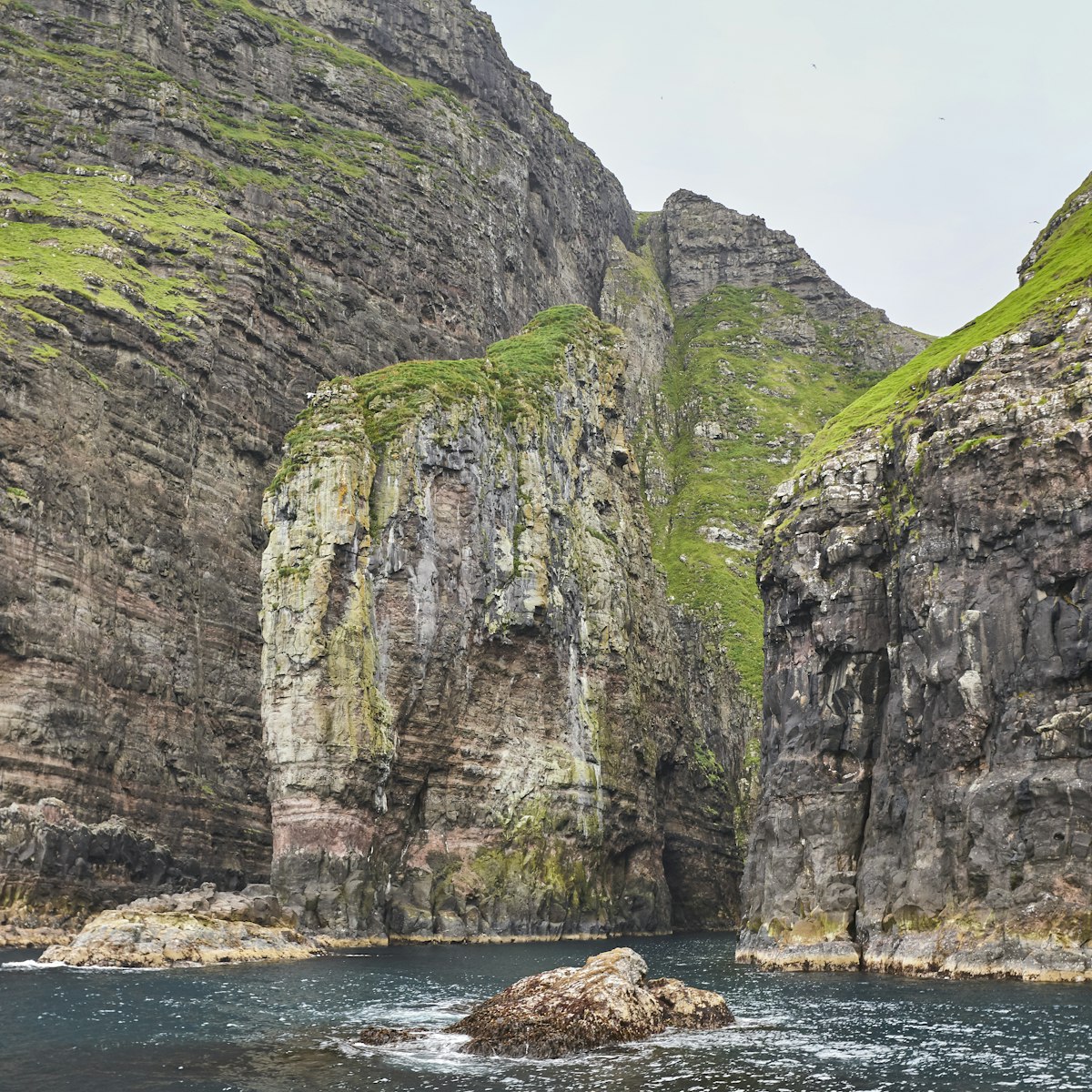
Vestmanna Bird Cliffs
The magnificent boat tours to the wild Vestmanna bird cliffs of northwestern Streymoy are probably the highlight of a visit to the Faroe Islands. When the…

Føroya Fornminnissavn
The excellent Føroya Fornminnissavn is split between two sites in the Hoyvík suburb, 3km north of centre. The main site at Brekkutún 6 beautifully…

Føroya Fornminissavn
The excellent Føroya Fornminnissavn (Historical Museum) is split between two sites in the Hoyvík suburb, 3km(1.86mi) north of central Tórshavn. The main…

Kirkjubøur was the episcopal centre of the island in medieval times. Today it's just a scattering of chalet-like wood-and-stone houses. St Olav's Church,…

Listasavn Føroya
Viðarlundin, a wonderfully wild park where trees and sculptures mingle, leads to the bright and airy Listasavn Føroya. Its excellent collection of Faroese…

Nólsoy Island
On Nólsoy Island, carless Nólsoy village isn't especially picturesque but makes a strikingly peaceful contrast to bustling Tórshavn, whose Tinganes…

The city's tiny but charming historical core is Tinganes, a little peninsula delightfully jumbled with pretty turf-roofed cottages and historic red…

Skansin Fort
Beyond the desert of asphalt that surrounds the modern transport terminal lie the turf-softened bastions of the ruined Skansin Fort. It's topped by a…
Top picks from our travel experts
10 of the best things to do in the faroe islands, planning tools, expert guidance to help you plan your trip.
Best Things to Do
Planning a trip to the Faroe Islands? Start with our ten must-do activities from at-home dining to hiking trails.
Things to Know
From packing to health care, we’ve got your most common Faroe Islands questions covered.
Transportation
From ferries and scenic drives to undersea roundabouts and helicopter rides, here’s how to get around in the Faroe Islands.
Money and Costs
Heading to the Faroe Islands? Here are some handy tips to help make your money go further.
Traveling with Kids
The Faroe Islands are perfect for families who love fresh air, outdoor fun and freedom. Here are the best things to do with kids on the archipelago.
Latest stories from Faroe Islands
Filter by interest:
- All Interests
- Adventure Travel
- Art & Culture
- Beaches, Coasts & Islands
- Food & Drink
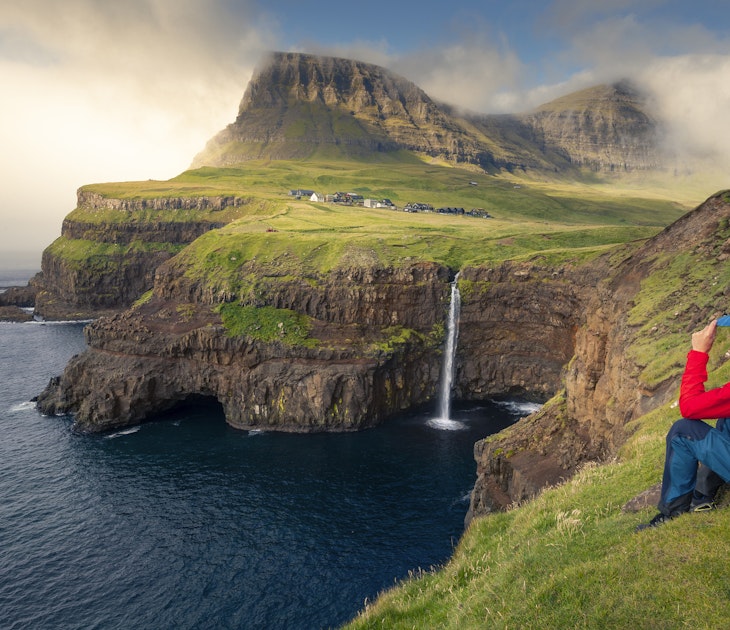
Destination Practicalities
Mar 7, 2024 • 6 min read
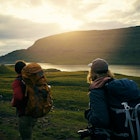
Mar 4, 2024 • 5 min read
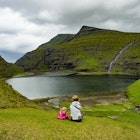
Mar 3, 2024 • 6 min read
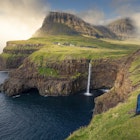
Mar 1, 2024 • 6 min read
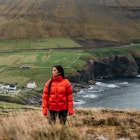
Sep 2, 2022 • 19 min read

Oct 29, 2021 • 6 min read

Dec 9, 2020 • 2 min read
in partnership with getyourguide
Book popular activities in Faroe Islands
Faroe islands and beyond.
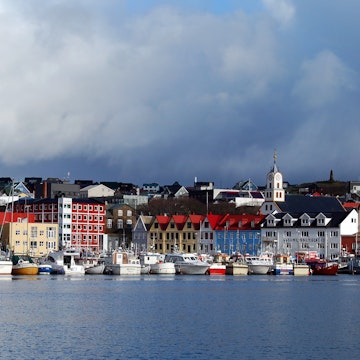
Faroe Islands
Arguably best known for their dramatic appearance in the BBC shipping forecast, the Faroe Islands are still one of Europe’s best-kept secrets. James Proctor , author of Faroe Islands: the Bradt Guide
Wild, wet and windy, these 18 volcanic islands, far out in the North Atlantic, are a different world – a realm of austere beauty where crystal-clear mountain streams cascade down verdant hillsides dotted with turfroofed homes, their timber walls painted a mêlée of reds, yellows and blues; a world where sea cliffs, teeming with birdlife, plummet precipitously into the churning Atlantic below; a world where the sea is all-powerful, giving and taking away.
This geographically isolated land of towering layer-cake mountains and deep rounded valleys, sparkling fell-top tarns and shorelines gnawed into countless craggy inlets is of such elemental wonder that first-time visitors soon become ardent devotees, returning time and again to the Faroes, one of Europe’s last places.
Agreed, the weather can be unreliable, even downright inclement at times – but the good news is that conditions in the middle of the Atlantic change fast, so you’ll never have long to wait for a glimpse of the sun. There’s sound logic behind the Faroese saying: ‘If you don’t like the weather, wait five minutes!’
The quality of the light in the northern sky, which attracts countless artists to the islands, and the purity of the air are perhaps two of the most difficult things about the Faroes to qualify on paper – visit, though, and you’ll soon appreciate this most alluring side of island life.
Thanks to regular air links to several European countries and a well-appointed ferry plying the waters of the North Atlantic, it has never been easier to reach the Faroe Islands.
Whether you’re looking to hike across tussocky moorland landscapes to imposing lighthouses perched on rocky promontories, watch seabirds in their natural habitat atop vertical cliff faces or simply island-hop around the Faroes exploring traditional villages and hamlets as you go, you’re sure to find an itinerary to please.
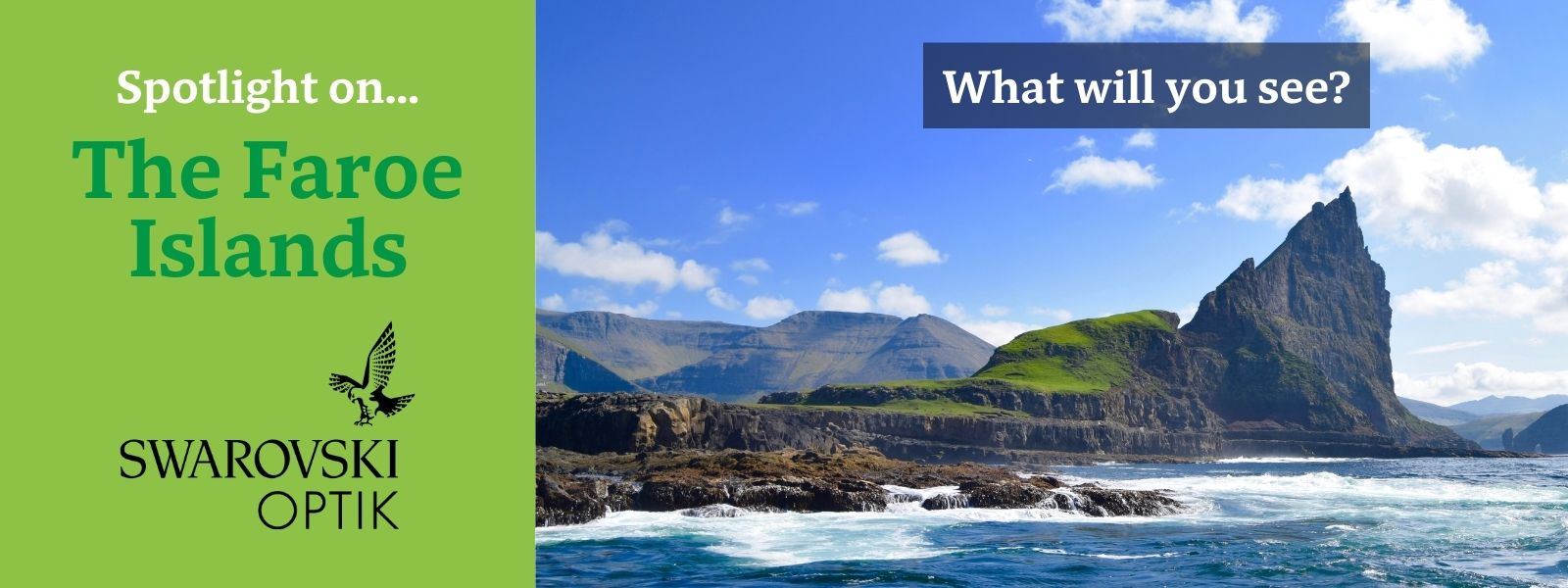
Food and drink on the Faroe Islands
Similarly to accommodation, the greatest choice of eating and drinking establishments can be found in Tórshavn where you will find everything from Burger King to sumptuous smorgasbord spreads of every Faroese and Nordic delicacy you care to imagine, generally served in the hotels.
In the smaller villages, though, it can often be difficult, if not impossible, to find somewhere to eat and you may well find yourself backtracking to the nearest main village to get some food. While out in the sticks, you can always rely on filling stations to hold a small selection of sandwiches and to serve up hotdogs with mustard (always very good and not nearly as tasteless as you may think) and sometimes chips.
If the worst comes to the worst, look for a supermarket and go self-catering (remember, though, most supermarkets are closed on Sunday); there’s generally some kind of food store in all but the smallest of villages. On board the larger ferries (operating on the routes Tórshavn–Suðuroy and Gamlarætt–Skopun), there are cafeterias serving snacks and coffee. For a more personal dining experience, ask the tourist office about Dining with the locals or heimablídni as it’s known in Faroese, an opportunity to meet local people and eat with them at home. Naturally, times and locations are subject to change but you can find more details at visitfaroeislands.com/see-do/dining/heimablidni and the tourist office will have the latest information.
Faroese breakfast , as served in the hotels in Tórshavn, and less extravagantly elsewhere in the country, is a Scandinavian-style cold table of hams, cheeses, herring, cereals, yoghurts, fruit and sometimes Danish pastries. It’s a help-yourself affair and you’re permitted to take as much as you like and visit the table as many times as you like. There are also limitless supplies of coffee, tea and juice.
The main meal of the day in the Faroe Islands is lunch , which, in Tórshavn at least, throws up a variety of options. Once again, an extremely good-value help-yourself buffet where you can eat your fill for around 150kr is a decent option. Lunchtime in the Faroes is any time between about 11.00 and 14.00, though most people tend to eat around noon or 13.00. If you’re looking to save money while in the Faroes, switch your main meal of the day to lunchtime and you’ll save a packet – have a snack in the evening instead, bought from the supermarket or bakery, and you’ll make your money go much further.
Dinner can be expensive for what you get – meals are often heavily meatorientated (rather than fish-based) with an accompaniment of (more often than not) overcooked vegetables and masses of potatoes. Sadly, due to the lack of fresh vegetables in the islands, many eateries serve veggies straight out of a can. Frustratingly for a country so influenced by the sea, it can be hard to find fresh fish on the menu. You should count on around 250–350kr for an upmarket two-course restaurant dinner, though of course you can eat in the pizzerias and cafés of Tórshavn for around half of that.
While in the Faroes it’s worth searching out and sampling some of the islands’ traditional foods . A particular favourite is wind-dried sheep’s meat, skerpikjøt , prepared around Christmas time and then nibbled throughout the year; virtually every home in the islands has its own hjallur or meat-drying outhouse. Pilot whale meat and blubber is occasionally also available on the menu (particularly at a Faroese evening or sometimes on the Faroese smorgasbord served up during the summer at Hotel Hafnia in Tórshavn) though it is somewhat of an acquired taste. Look out too for roast lamb and boiled wind-dried fish, ræstur fiskur – two other delicacies. Popular fish dishes (should you be able to find them on the menu) include haddock, halibut, plaice and salmon.
What will push the bill up is alcohol; a bottle of wine is roughly around 250kr, a draught beer usually starts at 60kr. It’s much cheaper to do your drinking at home – which is what many of the Faroese do.
Buying alcohol
Owing to a strong temperance movement (and religious objections), alcohol has only been (relatively) freely available in the islands since 1992. Before then the Faroes practised a system of public prohibition and every bottle of the hard stuff (including wine) had to be shipped in from Denmark and was doled out in rations.
Mercifully, the Faroes have now entered the modern age and alcohol is more readily available – albeit restricted by some bizarre legislation. Forget any notion of nipping into the nearest supermarket to buy a bottle of wine for dinner because alcohol is not available in the shops. The only place to buy any form of alcohol, be it strong beer, wine or spirits, is Rúsdrekkasøla Landsins (known colloquially as rúsan ) a state-run monolith responsible for all-things alcoholic.
Opening times are limited and you’ll find only six of these liquor stores in the entire country; they’re located in Klaksvík, Miðvágur, Saltangará, Skálavík, Tórshavn and Drelnes. In short, if you’re heading out into the wilds, stock up before you leave town or you’ll be left with the pathetically weak fizzy beverage sold in supermarkets, ljóst pilsnar , purporting to be beer yet with an alcohol content of barely 2.8%.
Health and safety on the Faroe Islands
The health risks while travelling in the Faroe Islands are minimal and healthcare is of an excellent standard. Language is rarely a problem and health workers are generally proficient in English. However, should you encounter any communication problems, the local tourist office should be able to point you in the direction of a doctor or dentist who does speak English.
Under Faroese law, a national of any country is entitled to emergency healthcare in the case of an accident; it is the responsibility of the individual doctor treating you to decide just what ‘emergency care’ consists of. If, however, you suffer from a medical condition requiring regular treatment or medication, this is not free and you will have to pay for all treatment received. It is necessary to present your passport at the hospital to receive any form of emergency care. It goes without saying that you should have comprehensive travel insurance.
As far as safety is concerned, the main risks are the Faroese landscapes – vertical sea cliffs that drop into the sea from heights of up to 900m should obviously be approached with great care. It’s also important to remember that when you’re out in the countryside the weather can change at any moment and hiking conditions can very quickly become hazardous; however, with common sense, it’s unlikely you’ll encounter serious danger. In relation to crime, the Faroes are one of the safest parts of the world you will ever visit: police figures put the yearly number of break-ins and cases of theft at barely 500 for the entire country.
Travel clinics and health information
A full list of current travel clinic websites worldwide is available on www.istm.org . For other journey preparation information, consult www.travelhealthpro.org.uk (UK) or http://wwwnc.cdc.gov/travel/ (US). Information about various medications may be found on www.netdoctor.co.uk/travel . All advice found online should be used in conjunction with expert advice received prior to or during travel.
Female travellers
Women travelling alone are unlikely to encounter any problems. Faroese males are generally well mannered and far too shy to create trouble. On Friday and Saturday nights in Tórshavn, when the beer starts to flow, it’s obviously sensible to keep your wits about you but, once again, you’re unlikely to become the target of abusive behaviour.
LGBT Faroes
Quite remarkably for a country where religion is still widely respected (and feared), there has been a sea change in attitudes towards homosexuality. In 2006 it became illegal to discriminate on the grounds of sexual orientation following a change in the law.
The new legislation was prompted by a well-publicised gay-bashing incident on a well-known musician in a pub in Tórshavn which appalled the public. More recently, in 2012, a staggering 5,000 people (10% of the population) marched through the streets of Tórshavn during Faroe Pride, calling for gay marriage to be legalised in the islands, in line with the law in Denmark.
Faroe Pride is now an annual event and is undoubtedly the best time for any gay traveller to visit the islands; it’s held on 27 July, the day before Olavsøka. For more information about the Faroese gay scene, check out lgbt.fo or its Facebook page .
The islands’ first out gay MP, Sonja Jógvansdóttir, was elected to parliament in September 2015 and same-sex marriage was finally made legal in July 2017 following several failed attempts a few years earlier. A public opinion poll conducted ahead of the change in the law showed around two-thirds of the population in favour; as expected, support was strongest in the area around Tórshavn and among the younger generation in general.
Travel and visas on the Faroe Islands
Getting there and away.
The quickest and easiest way to reach the Faroe Islands is by the Faroese national airline, Atlantic Airways , which operates all but one route to the islands. The international airline code for Atlantic Airways is RC and the airport code for the Faroes is FAE. Scandinavian Airlines also operates from Copenhagen to the Faroe Islands, making connections to the Faroes from across its network possible via the Danish capital.
The airport is located on the island of Vágar, just outside the town of Sørvágur, and is connected to Tórshavn by bus and taxi. Presently, it contains a café, ATM, tourist information desk and car-hire outlets before security, and a café and duty-free airside. The airport is also used as the departure point for the Atlantic Airways helicopter service , which serves the islands.
From the United Kingdom
Atlantic Airways operates directly from Edinburgh (EDI) to the Faroes twice a week (on Thursdays and Mondays) all year round, although services are reduced during the winter months. Flying time is in the region of 1 hour. When there is no flight from Edinburgh, connections can be made via Copenhagen.
From mainland Europe
An option that suits travellers coming from mainland Europe is to travel via Denmark with either Atlantic or SAS, which both offer daily flights from Copenhagen; connections to the Danish capital are available with most major European airlines. CPH–FAE return fares start at around 1,250 Danish kroner. Book early for the cheapest fares.
From the United States
The best way to reach the Faroes from the USA is to travel via Reykjavík with Icelandair (airline code FI) or via Copenhagen with SAS. Flying with Icelandair, you’ll sometimes need to change airports in Iceland; Icelandair flights arrive at the main international airport, Keflavík (KEF), and onward Atlantic Airways flights to the Faroes (1hr) usually leave from Reykjavík city airport (RKV); both airports are linked by transfer bus.
From Canada
Icelandair operates from several Canadian gateways (check the Icelandair website for the latest details) to Reykjavík, or pick up a flight to one of Icelandair’s US gateways and transfer there for Iceland and then on to the Faroes. Alternatively, fly with Air Canada to Copenhagen and then up to the Faroes.
From the rest of the world
Getting to the Faroes from the rest of the world naturally involves first reaching either London or Copenhagen, from where connections are available as described above. It’s worth checking online travel websites, such as Kayak or Momondo , for any special deals that might include the final leg with either SAS or Atlantic Airways up to the Faroes.
The Faroese-operated Smyril Line connects the islands with Hirtshals in Denmark (32hrs), and Seyðisfjörður in Iceland (16hrs). Sailing patterns are complicated but essentially the Norröna sails twice weekly to the Faroes from Denmark and once weekly from Iceland between June and late August; once weekly from both destinations at other times of the year.
Although there can be no doubt that sailing the North Atlantic to the Faroes in the wake of the Vikings is a wonderfully romantic notion, it’s really only sensible for those who want to take a vehicle with them on holiday – and for those with plenty of time. Smyril Line’s ports are rather remote: Hirtshals is just 50km southwest of Skagen, the northernmost tip of Denmark, while Seyðisfjörður is located on the southeast coast of Iceland, a full 700km from Reykjavík.
Getting around
Travel around the Faroe Islands is a doddle. All 17 inhabited islands are connected by bus, ferry or helicopter – and in a couple of instances by all three. You’ll often find that if your journey involves changing from bus to ferry or vice versa, departures are timed to correspond perfectly making travel a dream. Remember, though, that it’s rare to find any kind of shelter at bus stops, harbours and heliports so have your rain gear to hand in case the heavens open.
Getting around by car has become much easier in recent years thanks to a plethora of tunnels which have been bored through the islands, reducing the need to navigate twisting mountain roads. Nearly all roads are sealed and wide enough to allow two lanes of traffic.
Tunnels, however, are often single-lane with passing places; priority is always in one direction, making it the responsibility of drivers coming in the opposite direction to pull in and stop until they can safely drive on against the direction of priority. An undersea tunnel connects the islands of Vágar and Streymoy in the west of the country and Eysturoy and Borðoy in the north.
If you’re planning on travelling around the islands under your own steam, you may want to consider hiring a car, which will cost around 570kr per day (around 100kr less per day Oct–Mar).
By bus and ferry
The long-distance bus services on the main routes are frequent and reliable. Full timetables are available on the website; long-distance buses are blue in colour.
Of the ferries, only the services to Suðuroy, Sandoy and Kalsoy take vehicles. It’s not possible to book a space for a car on a ferry; you simply turn up at the quay in good time and the chances are you’ll get on board. Note, too, that you only pay in one direction for a return journey; either the outbound or return journey is free. Only the ferry journey to and from Mykines is payable in both directions. Pensioners are entitled to half-price fares on buses and the helicopter, though not on the Travel Card.
By helicopter
The helicopter service, operated by Atlantic Airways, is incredibly good value – short hops between islands can cost as little as 85kr and the single fare from the most northerly islands to the other end of the country is a mere 360kr; government subsidies are responsible and a full list of fares is available on the Atlantic website under the helicopter link.
When to visit the Faroe Islands
Undoubtedly the best time to be in the Faroes is during the long days of summer . From May to the end of July, when the evenings are light and the weather is at its most stable, the islands show their best side: wild flowers grow amid the deep-green tussocky grass of the valley slopes, the waterfalls glisten against the patchwork of whites and blues of the northern sky and everywhere the air is heavy with the scent of freshly mown hay and full of the calls of thousands of birds.
August and September, too, are delightful months to be in the islands; the days are still long and can be pleasantly warm. September, in particular, can be a great time to have the islands to yourself; most other tourists have left and you can hike without seeing a soul and experience the unsullied Faroese nature totally undisturbed. However, the weather now is on the change and the first of the winter storms is never far away.
Although autumn , and especially winter , are not ideally suited to tourism in the Faroes, there is nevertheless a certain masochistic pleasure to be gained from being buffeted by winds and rain, the intensity of which you will probably never have experienced before. The downside, of course, is that daylight is scarce at this time of year, and in December and January, it’s already starting to get dark around 14.00–14.30 – it’s black by 14.30–15.00.
Under a fresh fall of snow, the elemental beauty of the Faroese landscapes of mountain peaks and deep valleys is certainly breathtaking, but it’s worth remembering that many attractions are closed or inaccessible during the long winter months.
Spring brings a new lease of life to the islands, and daffodils and snowdrops are in full bloom in the Faroes way before they even start to peek out of the ground in Iceland, for example, barely an hour’s flight to the north. March and April are incredibly satisfying months to visit the country – not only can you appreciate the fresh leaves on the trees and the newly opened flowers, but the birds are starting to return, a sure sign that spring has arrived.
Events calendar
Faroese flag day.
Faroese flag day (25 April) revolves around recognition of the Faroese flag (announced on the BBC during wartime) which is a sign of national pride and independence.
Festival of Classical and Contemporary Music, Summartónar
Every year from June to August the Festival of Classical and Contemporary Music, Summartónar, is held around the Faroe Islands in different churches, museums and other public places.
Faroe Islands Regatta
In early July experience the unique Faroese Wooden Sail Ships in a regatta voyage from the north to the south of the Faroe Islands. You can participate in the Faroe Islands Regatta by taking the whole trip or doing parts of the trip.
National Day, Ólavsøka, is celebrated on 29 July with lots of sport, music and cultural events in Tórshavn including a march through the capital, terminating at parliament.
Gay Pride is held at the same time as Ólavsøka and is undoubtedly the best time for a gay visit to the islands. An all-inclusive march through town with much merriment and flag waving at a time when the gay community is finally getting its voice heard.
Also in late July is G! Festival. The festival brings leading international and local musicians together for a musical extravaganza against the splendid scenery of the ancient, seaside village of Gøta.
The Tour de Faroes
The Tour de Faroes in early August is by far the biggest cycling event in the Faroe Islands. It is a good opportunity to experience the Faroe Islands and its changing landscape. The only thing you need is a racing bike, though watch out for sheep crossing at seemingly any moment!
The Summer Festival is a unique music event held in early August in the centre of the town Klaksvík. It is the biggest music event in the Faroe Islands, and acts like Brian McFadden, Roger Hodgson, Ken Hensley, Shakin’ Stevens and others have all played at the festival.
Ovastevna is a regional festival on the island of Nólsoy in mid-August. The ferry shuttles across from Tórshavn during the day and into the night. The festival is held in honour of Ove Joensen who rowed single-handedly from the Faroes to the Little Mermaid statue in Copenhagen.
Tórshavn Marathon
You can participate in the 11th Atlantic Airways Tórshavn Marathon in early September. In addition to the full Marathon the races will include a half marathon, a 5.5 km Health run and a 2.2 km Health run.
The annual sheep slaughter takes place in September. Farmers bring in their sheep from the hills and choose which ones will be slaughtered ahead of winter. This is an intrinsic part of the sheep-rearing culture in the Faroes and is an important part of the annual calendar which has been practised since Viking times. Much celebration and merriment in the villages and in the countryside surrounds the event.
What to see and do on the Faroe Islands
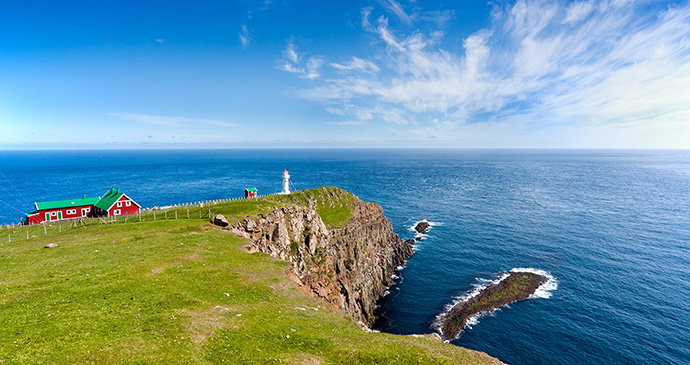
From Sumba, it’s barely another 2km along the road which climbs up out of the village to Akraberg and the most southerly point of the Faroe Islands. This wonderfully remote rocky promontory, which juts out proudly into the churning waves of the North Atlantic, is a suitably enigmatic spot. At the end of the road there’s a viewpoint.
During World War II, British soldiers were regularly here, maintaining the lighthouse and a radar station that scanned the sea and skies south of the Faroes; some of the pillboxes they built as part of anti-invasion preparations are still standing.
It’s thought that the original inhabitants of Akraberg were heathen Frisians who began settling here in around 800 – there are legends about them in Faroese folklore based on oral accounts which were later written down in the late 1700s. Between 700–800 they were driven north by Frankish expansion and began settling on the territories of what’s now Germany, Holland and Jutland in Denmark.
However, it’s assumed some sailed further north as old legends tell of an island north of the British Isles known as Frislandia – quite possibly Suðuroy. At its peak, there were 13 houses occupied by Frisians at Akraberg, while their (pirate) ships were moored at Sumba.
The best known of the Frisians was Hergeir, who infamously burned down Bishop Erlendur’s residence at Kirkjubøur. The Frisian population finally succumbed to the Black Death in 1350, when the last two remaining inhabitants moved to Sumba and married there. The original settlement was located down on the shoreline but has long since vanished into the sea.
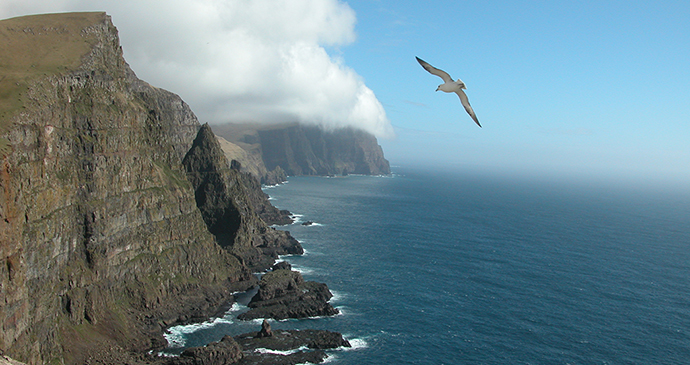
Beinisvørð cliffs
Just before the tunnel at Lopra, take the right turn signed for Víkarbyrgi to reach one of the real highlights of Suðuroy: the breathtaking, 470m-high Beinisvørð cliffs, which are the Faroes’s second-highest vertical sea cliffs.
On their eastern, landward side, the cliffs are denoted by an unbelievably steep grassy slope that soars skywards to the tip of the craggy triangular peak that marks the very highest point of Beinisvørð. From here, the cliffs plummet on their seaward side vertically into the North Atlantic below and can be seen for miles around, totally dominating any view from Lopra and Sumba (and can even be seen from the Smyril ferry as she swings in towards Tvøroyri).
Risking life and limb, generations of local men from Sumba have abseiled down the sheer cliff face in search of seabirds and their eggs, which once were an important source of food – tragically, many paid the ultimate price. Over the years, the dramatic nature of Beinisvørð has even inspired several poets, who have used the cliffs as a potent symbol of independence in their work; today they proudly feature on the Faroese 50kr banknote.
ou can get close to the cliffs on the old Lopra–Sumba road at a spot known as Hesturin (the location of a radio mast at a sharp bend in the road), from where, with care, it’s possible to walk to the cliff edge. From Beinisvørð the road then descends gradually towards the junction for Akraberg and Sumba itself.
On the western side of Sumba, there are good views of the verdant slopes of Beinisvørð from just before the tunnel entrance. Alternatively, you can view the cliffs from a distance at Eggjarnar, near Vágur.
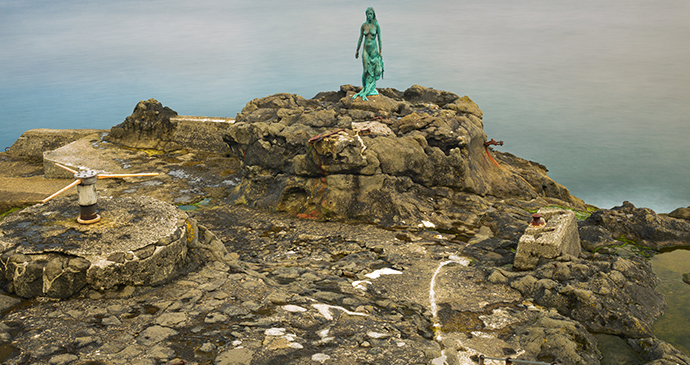
The most westerly of all the northern islands, Kalsoy, weighing in at just 31km², is not only one of the easiest in the group to reach but it is also one of the most beguiling. This long slender finger of an island has the benefit of regular ferry connections to Klaksvík and some great hiking, making it a popular day-trip destination.
Like its easterly neighbour, Kunoy, this island is also composed of a single ridge of mountains, which run north to south down its centre. The peaks plummet, often perpendicularly, to the sea along the west coast, rendering it entirely inaccessible, whereas the gentler east coast, where Kalsoy’s four settlements are to be found, is characterised by a number of botnar , whose deep, rounded nature has allowed some agricultural activity to take place.
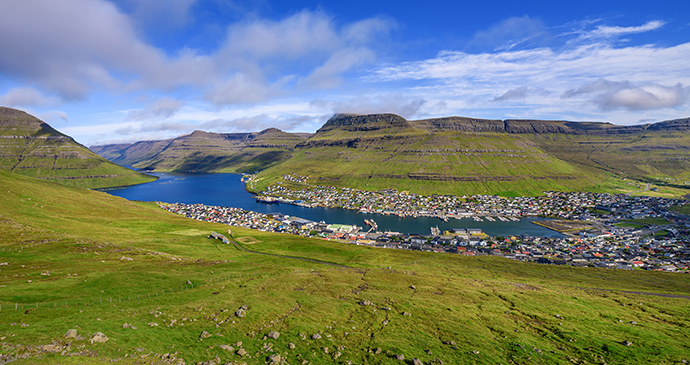
Sitting snugly around a tight U-shaped inlet crammed with state-of-the-art ocean-going fishing trawlers, Klaksvík, with a population of around 4,700, is the second-largest settlement in the Faroes and the economic and administrative centre for the northern islands. It’s here that the entire population of the six surrounding islands comes to shop and go about their everyday chores, be it going to the bank, popping into the library or sorting things out at the district council.
Klaksvík owes its pre-eminence to its superbly sheltered harbour, which, ever since the town was granted municipal status in 1908, has continued to grow steadily and today is the site of one of the Faroes’s largest and most successful fish-processing plants, served by the town’s sizeable fishing fleet. Remarkably there’s also a brewery in Klaksvík: Föroya Bjór was originally established by a local farmer and has since grown into the country’s biggest and best beer producer, brewing and selling from its store classic European-style lager from imported hops from southern Denmark; the use of the ö in the spelling of the word föroya is an older version of today’s Danicised føroyar .
Although Klaksvík can trace its history back to Viking times when a ting was held here to pronounce upon all things administrative, today’s town effectively grew out of the four farms which were well established by the time a trading station was established here in 1838 during the Danish Trade Monopoly.
It wasn’t until the end of the 19th century that Klaksvík made the transition from farming to fishing and acquired the modern harbour which today provides the town with its window on the world: one-fifth of the the Faroes’s fish exports originate here.
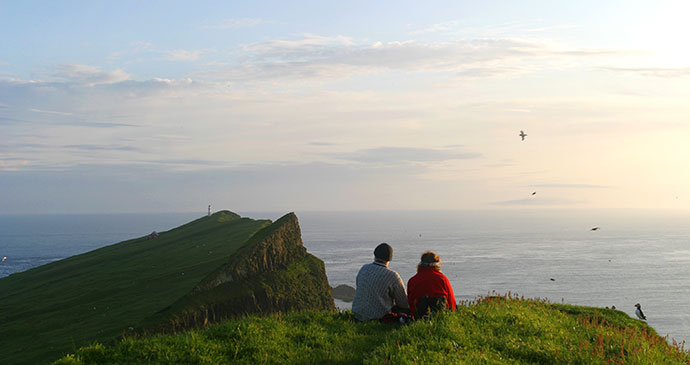
Mykines really is something special. Geographically the Faroes’s most westerly (and driest) outpost, this rugged isle, barely 10km², is certainly the most enigmatic of the 18 Faroe Islands and the one that ranks, time and again, as the absolute favourite among Faroese and visitors alike.
Looking down the fjord from Sørvágur its craggy cliffs and hills rise precipitously out of the sea in a wall of lush green, turquoise and steely grey, the winds hurrying the clouds across the sky, changing the island’s aspect as frequently as the light.
Depending on the prevailing weather conditions, Mykines can seem bright and inviting or, at other times, sombre and threatening. Approaching across the turbulent waters of the Mykinesfjørður , which separates the island from Vágar, Mykines can appear totally inaccessible, the south coast a remarkable series of unapproachable sheer cliffs and rocky clefts. High above this wall of rock, the peak, Knúkur (560m), bears down over the eastern end of the island, from where two rocky valleys, Borgardalur and Kálvadalur, tumble down to the sea drained by several serpentine rivers.
As the land falls away to the west of the mountain, the rocky outcrops of the interior give way to a luxuriant valley of the deepest green that leads down gently to the island’s only settlement .
Some 150m below the village, hemmed into an alarmingly narrow cleft full of jagged reefs, the landing stage is regularly battered by the crashing Atlantic surf and surging waves; arrival in Mykines is not only an adventure but also something of an unpredictability, since, with southwesterly winds, the ferry may not be able to steer into the tiny harbour despite having sailed from Sørvágur with that very intention. It’s not unknown for the island to be cut off for days, even a week or so, during particularly stormy weather.
Charming though Mykines village is, it’s the tremendous profusion of summer birdlife that is the real draw here. Seemingly everywhere you look there are birds: in the air, on the cliffs and hiding in nesting burrows on the hillsides. Indeed, the western point of the island beyond the harbour, known as Lambi , is a favourite location for puffin who gather here in uncountable numbers between mid-April and mid- to late August to hatch and rear their young – Mykines is the only place in the Faroes where they are protected and cannot be hunted.
Beyond here, a narrow footbridge leads across to the neighbouring rectangular islet, Mykineshólmur , where the rock stacks, Píkarsdrangur and Flatidrangur, and surrounding cliffs are home to the Faroes’s only colony of gannets. The gannets are present between late January and October, after when the young birds migrate to Morocco for the winter, the older ones preferring to winter out at sea closer to the Faroes.
Incidentally, the correct pronunciation of the island’s name is ‘mitchiness’ and not ‘mikiness’; armed with this fact you’re bound to impress the locals.
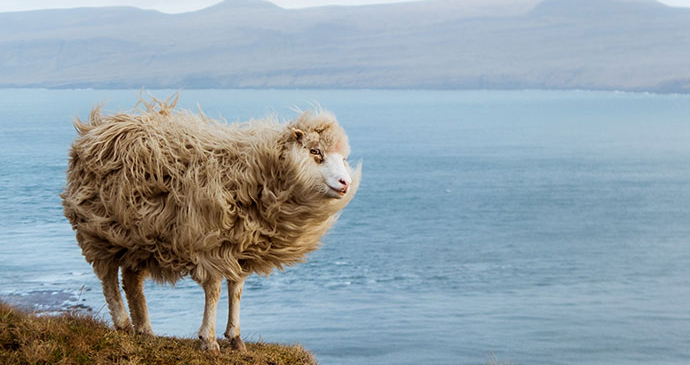
A day trip to the island of is one of the most enjoyable things to do whilst visiting Tórshavn. Not only do you get a superb view of the Faroese capital from the water as the tiny ferry that sails to the island steadily chugs out of the harbour, but it’s also a chance to explore the floating humpbacked finger of land that you’ll have become distantly familiar with while in Tórshavn, as it’s an integral part of the view out to sea from all over town. Nólsoy also has the advantage of being just about the right size to tackle in a day: between ferries there’s enough time to explore the village, visit the Faroes’s most famous taxidermist to admire his stuffings and hike out through unspoilt nature to the stunningly located lighthouse on the island’s southern tip. However, should you choose to stay overnight, there’s also a chance to visit the largest colony of storm petrels anywhere in the world.
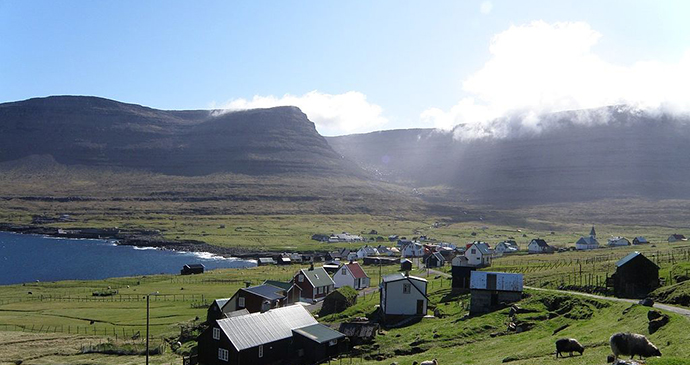
Svínoy and Fugloy
The journey that everyone who comes to the Faroe Islands wants to make is the combination of bus and ferry that leads to the country’s two most remote islands: Svínoy and Fugloy. Indeed, much of the attraction of these two last places far out in the North Atlantic lies in the getting there.
The weather in this exposed northeastern corner of the country often plays havoc with timetables and arriving here at all is a major achievement. A journey out here is not something to be undertaken on a whim; it requires careful planning, perseverance and, not least, a large amount of luck.
In a strong tide, the roughest parts of the journey will be when the boat turns out of the sheltered Hvannasund sound to pass through the narrow stretch of water, Svínoyarfjørður, between Bergið on southern Viðoy and Tangarnir on Svínoy, and particularly the final stretch across the open water of Fugloyarfjørður between Svínoy and Fugloy when the boat, quite literally, bobs like a cork.
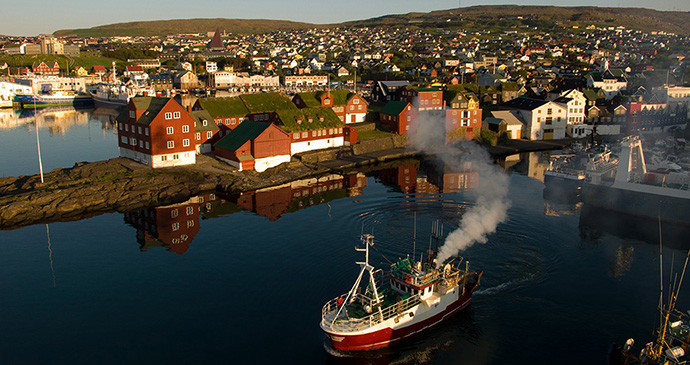
Proudly named after the Norse god of war, Tórshavn (literally ‘Thor’s Harbour’) is curiously built around one of the worst natural harbours in the entire country, dangerously exposed to the gales and accompanying heavy swells of the North Atlantic.
Yet it was here, around AD900, on the rocky promontory, Tinganes, that the ting or Viking parliament first began meeting every summer to chew over matters of national importance, doing so uninterrupted until 1816; today this promontory is still the seat of the Faroese government. An annual market was also held here to coincide with the assembly, developing in the Middle Ages – with the introduction of the Trade Monopoly in 1579 – into a permanent trading place with warehouses for the importing and exporting of goods.
Although Tórshavn’s future was confirmed, population growth was slow due to restrictive land ownership laws that made farming difficult; by the beginning of the 17th century, barely 100 people lived in the settlement. In 1673 there was a further setback when a devastating fire raged across Tinganes, destroying all but two of the warehouses there.
Over the ensuing centuries growth gradually increased, helped in large part by reform of land ownership rights, and by 1900 Tórshavn’s population had soared to 15,000, tripling in just 100 years. Today, Tórshavn has finally come of age, blossoming into a self-confident, bustling medium-sized town with a population of around 19,800 people and all the trappings of a national, if diminutive, capital: government offices, parliament and foreign consulates are all here and the town is home to two out of five Faroe Islanders. Incidentally, you pronounce Tórshavn toe-ush-hown .
For orientation, take the harbour as your point of reference: from here, Tórshavn stretches in three directions: west up the steep hillsides behind the town centre that act as the capital’s backdrop, as well as both north and south curving around the waterfront. However, it is the all-important harbour, through which the country maintains contact with the rest of the world, which remains the town’s focal point and is arguably the most attractive part of town.
Here a long row of converted warehouses, with façades ranging in colour from a rich yellow ochre to bright reds and blues, reflect in the crystal-clear waters of the harbour bursting with small wooden fishing vessels; during the long summer days, the couple of cafés on the waterfront here are full of people enjoying a cup of coffee, watching the boats bob on the Atlantic swell – the classic picture-postcard view of Tórshavn.
From here a warren of narrow streets and lanes leads up and over the hill on to Tinganes, winding past tiny black-tarred houses with white window frames and green turfed roofs to the grander former merchants’ houses. Today, these are home to the various departments of the Faroese Home Rule government; they stand on the very tip of the promontory looking over to Skansin fort which once protected Tórshavn harbour from marauding pirates.
However, it is in and around the compact grid of modern streets north of Tinganes, dominated by the pedestrianised main drag, Niels Finsens gøta , where you’re likely to spend most of your time. It’s here that most of the town’s facilities are located: shops, restaurants and a bank are all to be found within a central area measuring no more than 1km² or so – Tórshavn is, after all, the smallest national capital in the world.
From the centre of town, Tinghúsvegur streaks north, past the Faroese parliament, to the SMS shopping centre and on to the forested Viðarlundin Park, one of the few plantations in the country and a favourite place for a stroll.
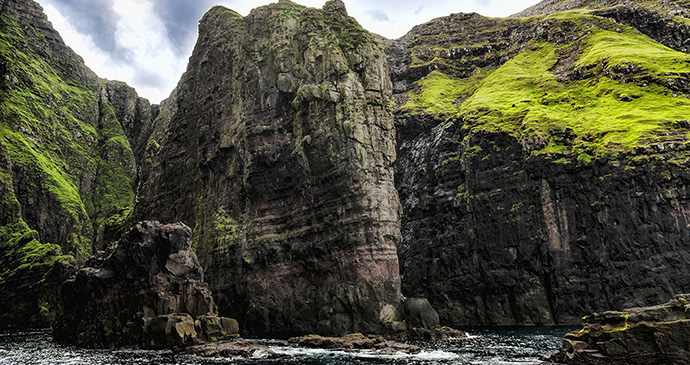
Vestmanna bird cliffs
One of the best excursions anywhere in the Faroes is a boat trip to the Vestmanna bird cliffs and grottoes. Known as the Vestmannabjørgini in Faroese, these soaring cliffs, roughly halfway between Vestmanna and Saksun to the north, provide safe nesting places during the summer months (roughly May until late August) for thousands upon thousands of seabirds, attracted by the vast shoals of fish that gather here in the plankton-rich waters of the North Atlantic.
Rising up to 600m above the turquoise hues of the churning sea below, the cliffs are characterised by their numerous clefts and green blankets of luxuriant grass and mosses.
The boats that sail out here give you an unparalleled view of the cliffs and the birds – notably puffins, razorbills and guillemots – as they weave in between the numerous sea stacks and in and out of narrow straits bound by sheer rock walls (look up and you may well see sheep grazing quite undisturbed on the clifftops) and dark echoing grottoes where the sound of the squawking birds and dripping water is amplified to unnerving proportions.
Related books
For more information, see our guide to the Faroe Islands :
Related articles
A self-drive tour of the Faroes
Discover the best way to see these islands while driving yourself
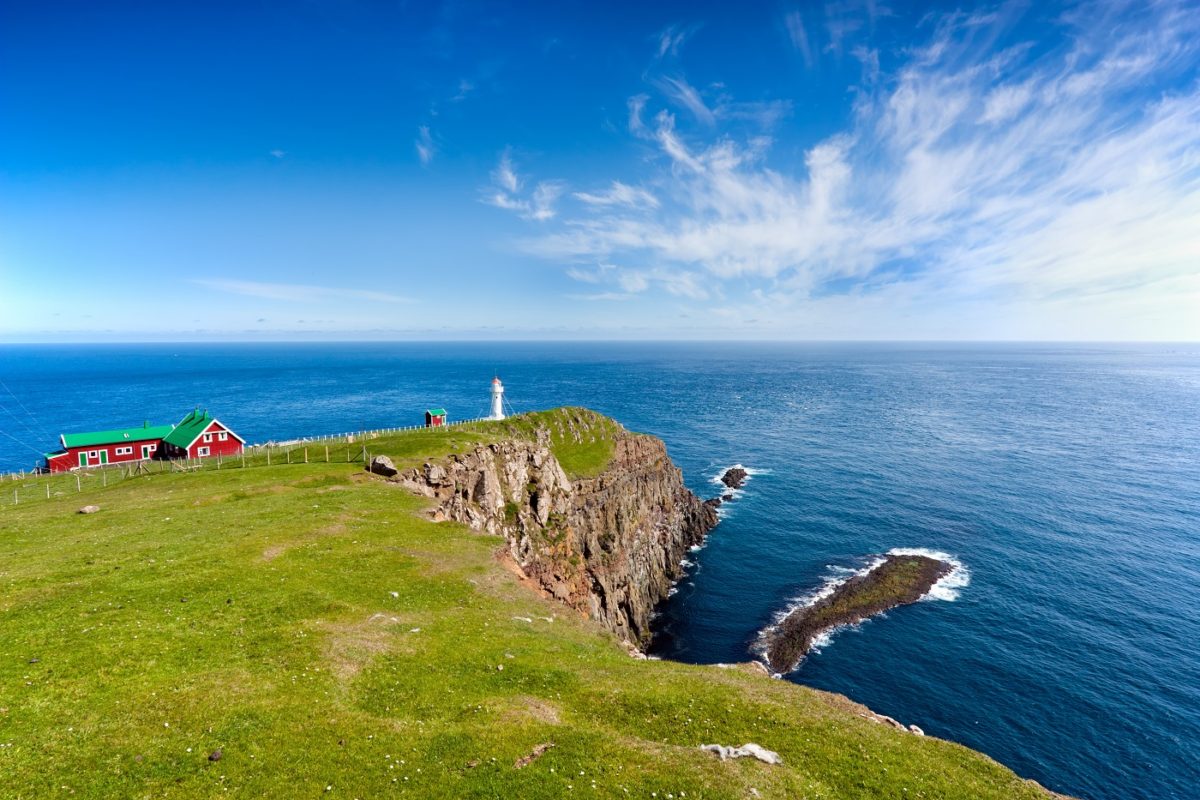
The remotest of the remote: getting off-grid in the Faroe Islands
If you like your holidays really remote, then these are the islands for you.
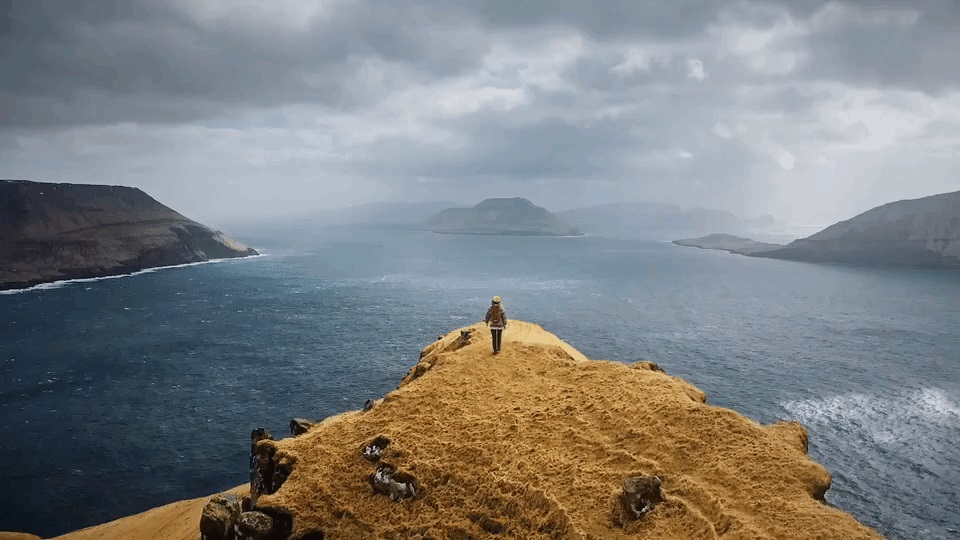
Remote tourism in the Faroe Islands
Their initiative allows visitors to explore their dramatic landscapes through the eyes of a local.
Faroe Islands Travel Guide: the ultimate 10 recommendations
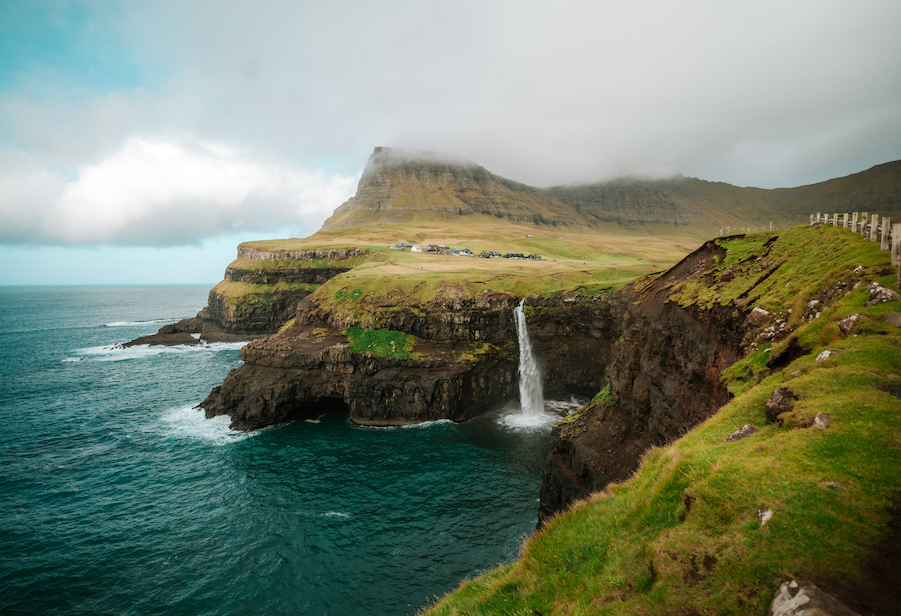
Welcome to the ultimate travel guide to the Faroe Islands, a destination of rugged beauty and unspoiled landscapes that beckon travelers seeking an extraordinary adventure. If you’ve ever dreamed of exploring a remote and breathtakingly scenic destination, you’re in for a treat. My mission in this blog post is to equip you with the most practical and comprehensive information on how to plan your perfect Faroe Islands getaway. I’ll take you on a journey through the essential details, from understanding the unique geography and location of these North Atlantic gems to providing expert insights on booking the best trip.
In this travel guide, I aim to demystify the Faroe Islands, helping you navigate the logistics and create a memorable travel experience. You’ll discover the where, when, and how of visiting this remote archipelago, as well as invaluable tips on making the most of your time there. Whether you’re a nature enthusiast, an adventure seeker, or a photographer looking for the perfect shot, this post is your one-stop resource for everything Faroe Islands.
So, fasten your seatbelts and get ready to embark on an unforgettable journey. By the time you’ve finished reading, you’ll have all the practical information you need to book the best trip to the Faroe Islands and create memories that will last a lifetime. Let’s dive into this remote and captivating destination together, step by step.
Where are the Faroe Islands located?
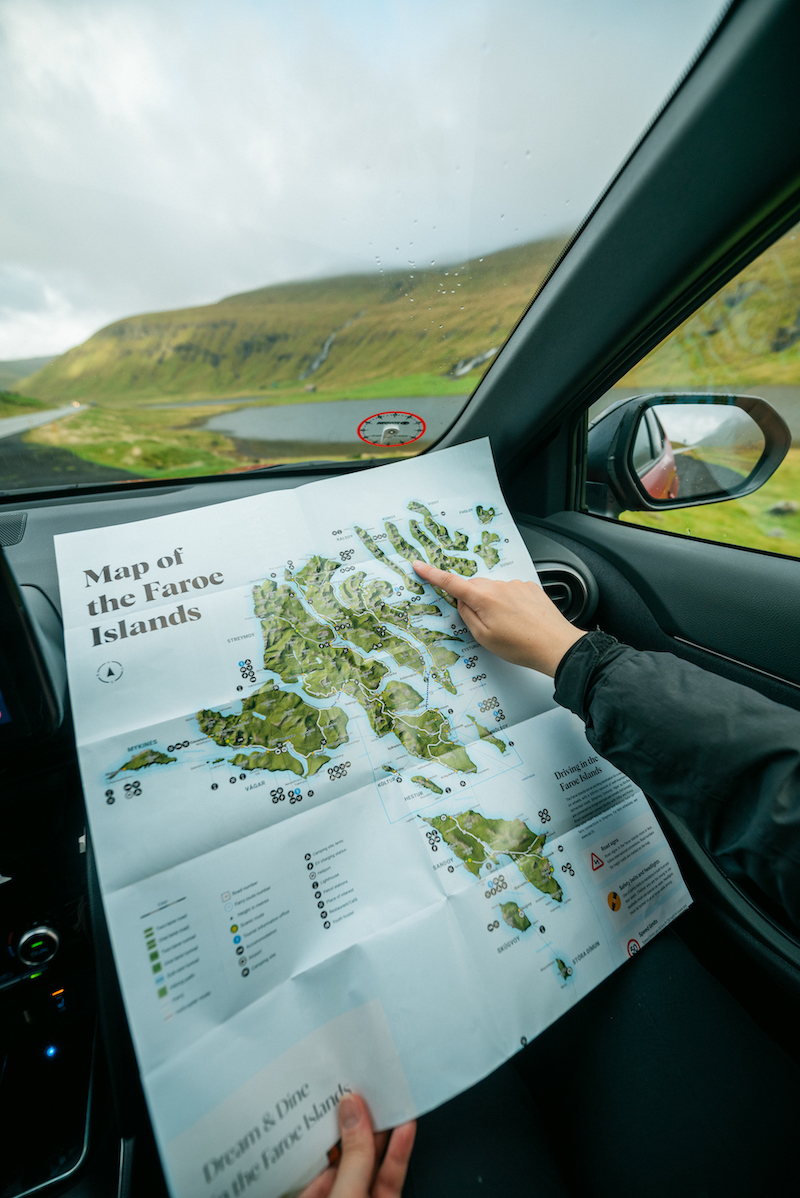
The Faroe Islands are nestled in the North Atlantic Ocean, situated approximately halfway between Iceland and Norway. Geographically, they are located about 320 kilometers (200 miles) northwest of Scotland. This remote and rugged destination, often described as a hidden gem of the North Atlantic, is an autonomous territory within the Kingdom of Denmark. Comprising 18 main islands and several smaller islets, the Faroe Islands offer a breathtaking landscape of dramatic cliffs, lush valleys, and pristine fjords. Its unique location, characterized by the cool North Atlantic waters and the influence of the Gulf Stream, results in a mild maritime climate, making it an attractive destination for travelers seeking natural beauty and outdoor adventures. The Faroe Islands, with their distinctive location and captivating scenery, beckon explorers and nature enthusiasts to discover their remote charm and extraordinary landscapes, truly living up to the dream of an off-the-beaten-path travel destination.
Faroe Islands: how to get there?
Getting to the Faroe Islands is more convenient than ever, thanks to the new direct routes offered by Atlantic Airways, the national airline of the Faroe Islands. This company has a rich history dating back to its establishment in 1987. Originally founded as a helicopter company, it quickly expanded to include fixed-wing aircraft, becoming a pivotal player in connecting these remote islands to the world.
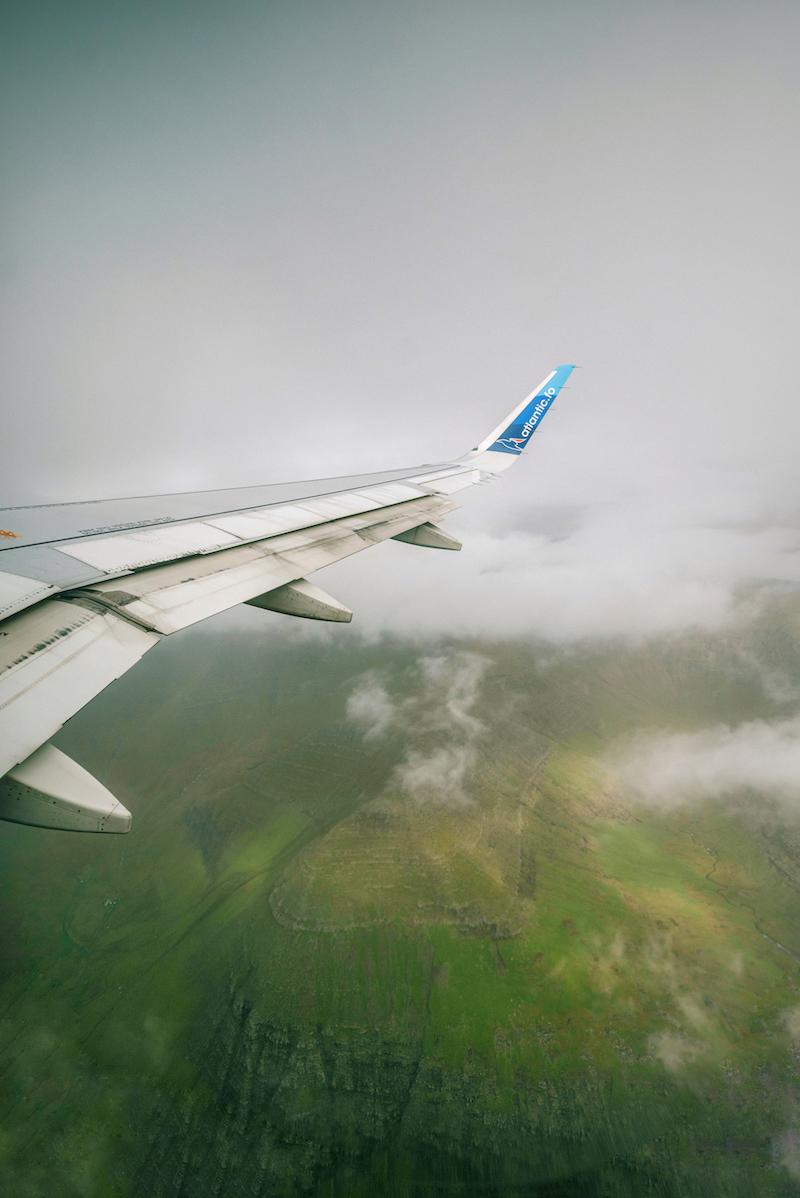
If you’re traveling from Europe , you’re in for a real treat. Atlantic Airways has recently launched a direct route from Paris ( France ) to the Faroe Islands, making the journey smoother and more accessible than ever before.
This direct flight from Paris to Vágar Airport significantly cuts down travel time, allowing you to dive right into the Faroese experience. But that’s not all – Atlantic Airways also offers direct routes from other major European cities, including Copenhagen (Denmark), Reykjavik (Iceland) and Edinburgh (Scotland). With a well-connected network and these direct routes, reaching this remote paradise in the North Atlantic has never been easier. So wherever you’re flying from, Atlantic Airways has you covered, ensuring a convenient and comfortable journey to the Faroe Islands.
Travelers coming from North America or other international destinations may consider flying into one of these major European cities. So, whether you’re flying from Paris, Copenhagen, Reykjavik, or Edinburgh, Atlantic Airways, with its strong history and commitment to exceptional service, has you covered, ensuring a convenient and comfortable journey to the Faroe Islands.
Book your flight here!
If you prefer sea travel, you can explore the possibility of taking a ferry from Iceland, which offers a scenic maritime adventure with breathtaking views of the Faroese landscape. Regardless of your choice, these options ensure that your adventure to the Faroe Islands is not only accessible but also a memorable part of your overall travel experience.
Faroe Islands: travel tips
- Language: Faroese is the official language, but most Faroese people also speak Danish and often English. English is commonly used in the tourism industry.
- Weather Preparedness: Be ready for unpredictable weather. Pack layers, a waterproof jacket, and sturdy, waterproof footwear. Regardless of the season, rain is always a possibility.
- Transportation: Public transportation is limited, so consider renting a car to explore the islands independently. Roads are well-maintained but can be narrow and winding, so drive with caution. Rent a car here.
- Respect the Environment: The Faroe Islands’ natural beauty is pristine. Respect the environment by staying on marked paths, not disturbing wildlife, and properly disposing of your waste.
- Camping: Wild camping is not allowed, but campsites are available for a fee.
- Alcohol: The Faroe Islands have strict alcohol regulations. You can only buy alcohol at government-operated stores, and it can be quite expensive. Consider purchasing alcohol at duty-free shops in the airport upon arrival.
- Safety: The Faroe Islands are considered very safe. However, be cautious when hiking, as the terrain can be challenging and the weather unpredictable.
- Cultural Etiquette: While the Faroe Islands are fairly relaxed, it’s important to be respectful of local customs and traditions. Greet locals with a smile and a nod when passing on the street.
- Internet and Mobile Coverage: Internet and mobile coverage are generally good, but be aware that in very remote areas, you may experience limited connectivity.
- Photography: The Faroe Islands offer countless photo opportunities. However, always ask for permission before taking pictures of local residents, and respect any restricted areas or “no photography” signs. Drone photography is allowed in the Faroe Islands and offers unparalleled perspectives of the dramatic landscapes. While it’s a fantastic way to capture the rugged beauty, there are strict regulations. Ensure you familiarize yourself with the specific rules and limitations, including no-fly zones and privacy considerations.
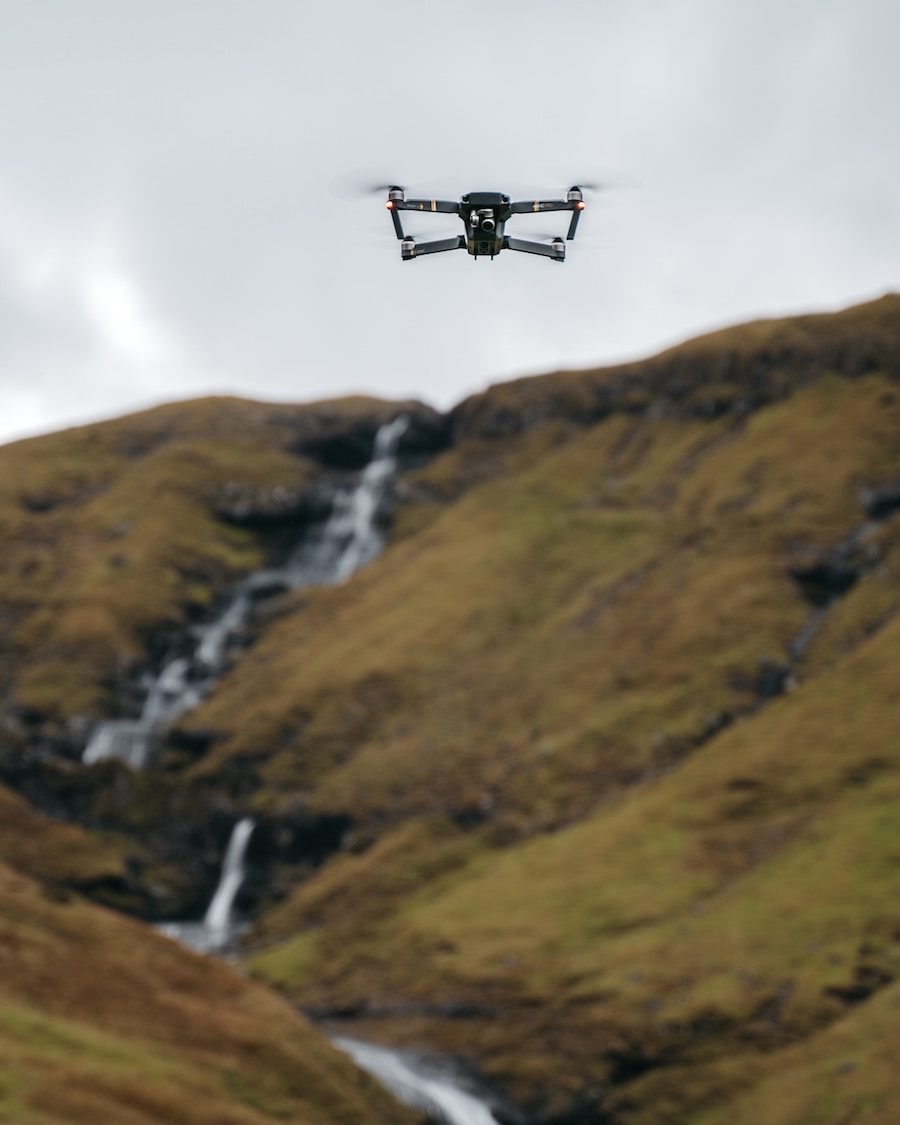
Faroe Islands Currency
In the Faroe Islands, the official currency is the Danish Krone (DKK), and in addition to the DKK, the Faroese Króna (FKR) is also in circulation. While credit and debit cards are widely accepted in most places, it’s advisable to carry some cash, especially for smaller purchases and in more remote areas where card facilities might be limited. You’ll find ATMs available in towns and larger villages, and both Danish Krone (DKK) and Faroese Króna (FKR) are widely accepted, making it convenient for travelers as you can use either currency for your transactions in most places across the Faroe Islands. Keep in mind that the Faroe Islands are part of the Kingdom of Denmark, and the currency used here includes both DKK and FKR, with the exchange rate being 1 DKK = 1 FKR.
Faroe Islands Weather
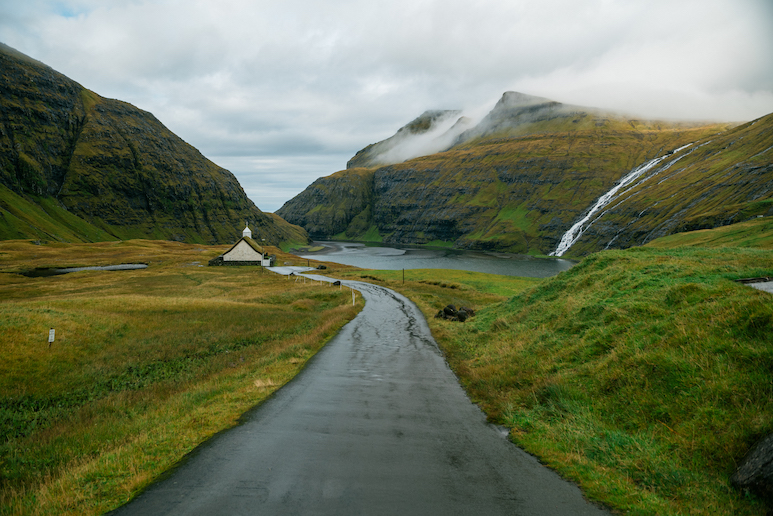
Understanding the Faroe Islands’ ever-changing weather is not just practical; it’s essential for planning a successful trip to this enchanting archipelago. The Faroe Islands’ climate is characterized by its maritime influences and dramatic seasonal shifts, each offering a unique atmosphere and set of experiences for travelers. In this section, I’ll take you on a journey through the seasons, delving into what you can expect in terms of weather and how it can impact your travel plans. From the vibrant awakening of spring to the tranquility of winter’s solitude, I’ll provide you with the insights you need to choose the perfect time to explore the Faroe Islands and pack accordingly. So, let’s dive into the ever-shifting skies and discover the captivating weather patterns that shape this remote and breathtaking destination.
Spring in the Faroe Islands
Spring in the Faroe Islands, which typically spans from March to May, is a season of awakening. The islands burst into life as the winter frost recedes, and nature reclaims its vibrancy. While temperatures remain on the cool side, ranging from 5°C to 10°C (41°F to 50°F), the Faroes come alive with colorful flora and lush green landscapes. It’s an excellent time for birdwatching, with countless seabirds returning to their nesting grounds. Be prepared for frequent rain showers and ever-changing weather, so packing layers and waterproof gear is essential.
Summer in the Faroe Islands
Summer in the Faroe Islands, from June to August, is the most popular time to visit. With temperatures ranging from 10°C to 15°C (50°F to 59°F), this is the warmest season, and the days are long, often with nearly 24 hours of daylight. It’s an ideal time for hiking, wildlife exploration, and outdoor activities. The landscapes are at their most picturesque, with vibrant green valleys, wildflowers in bloom, and abundant birdlife. But don’t forget your raincoat, as the islands are still subject to frequent rainfall, even in summer.
Autumn in the Faroe Islands
Autumn, from September to November, ushers in a season of dramatic landscapes and fewer tourists. The temperatures start to drop, ranging from 8°C to 12°C (46°F to 54°F). This season offers a unique blend of fading summer colors and the emergence of stunning fall foliage. It’s an excellent time for photography, as the changing light and weather patterns create captivating scenes. Be prepared for more unpredictable weather and shorter days as the Faroe Islands transition into winter.
Winter in the Faroe Islands
Winter in the Faroe Islands, from December to February, is a time of stark beauty and tranquility. Daylight hours are limited, with only a few hours of dim sunlight each day, and temperatures range from 3°C to 7°C (37°F to 45°F). While it’s the coldest and darkest season, it has its own charm. It’s the best time to witness the Northern Lights, and if you’re a fan of cozy atmospheres and solitude, this is the season for you. Be ready for wet and windy weather, as winter storms can be quite powerful.
Understanding the distinct characteristics of each season in the Faroe Islands is vital for planning the timing of your trip and packing appropriate clothing and gear. Whether you’re seeking the vibrant life of summer or the serene solitude of winter, the Faroes offer unique experiences throughout the year.
Faroe Islands Map: how to travel within the country
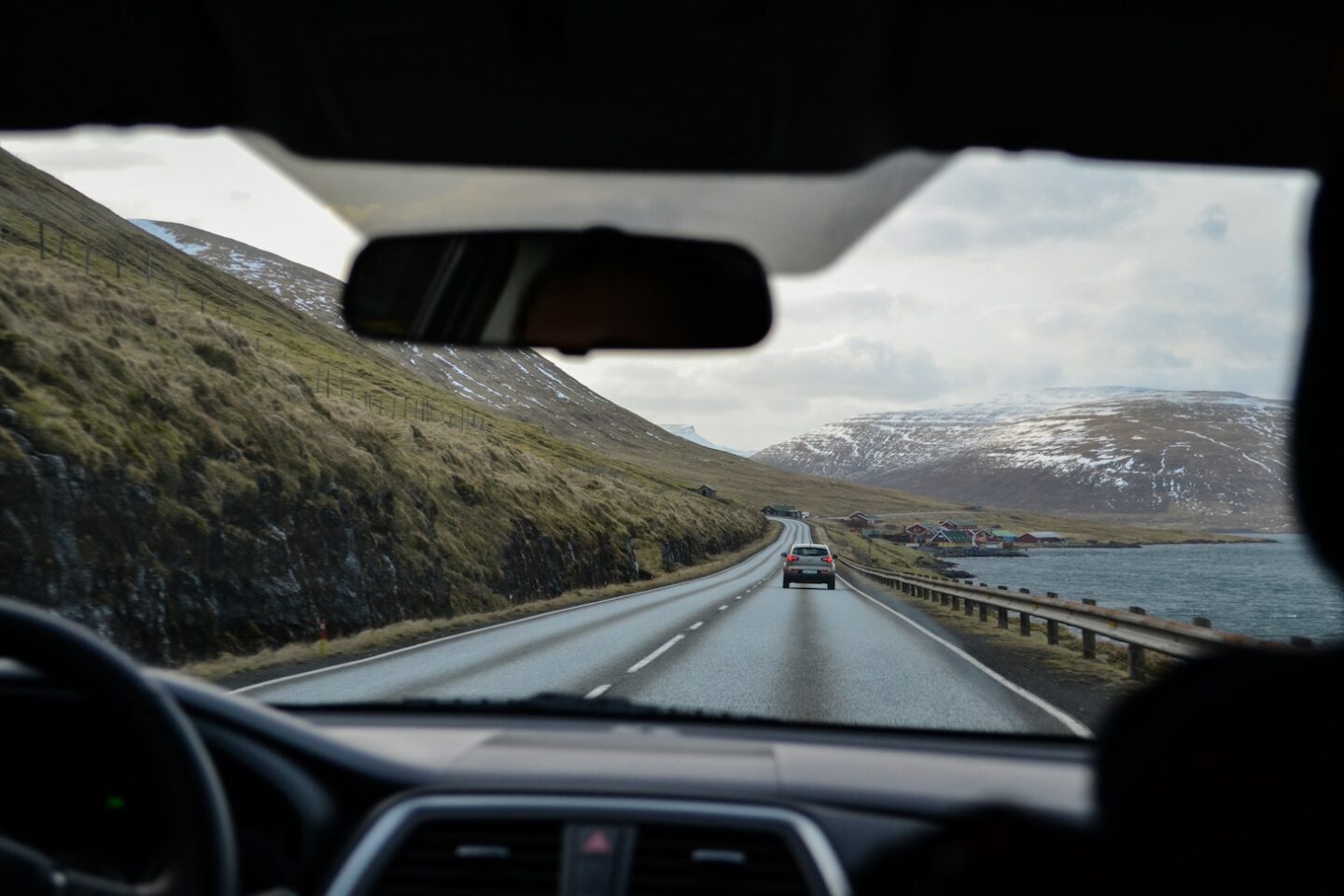
Navigating the Faroe Islands is an adventure in itself, offering diverse modes of transport for exploration. Renting a car is a popular choice, providing flexibility to traverse the islands at your own pace, taking in the scenic routes and stopping at various viewpoints. Ferries play a crucial role in connecting some of the more remote islands, offering a picturesque maritime journey between these stunning landscapes. During the high season, helicopter services further enhance accessibility, providing a unique and efficient way to hop between islands, granting awe-inspiring aerial views of the archipelago. Each mode of travel in the Faroe Islands contributes to the overall experience, allowing visitors to immerse themselves in the unique beauty and varied landscapes of this remote destination.
Driving in the Faroe Islands offers an excellent way to explore the breathtaking landscapes, but it comes with its own set of considerations. The network of roads includes some incredible engineering feats like underwater tunnels, connecting various islands. Tolls are applicable for these tunnels, usually ranging from 100 to 250 DKK (Danish Krone) depending on the tunnel and vehicle size. As for road conditions, the Faroes’ serpentine routes can be narrow and winding, so drivers should exercise caution, especially in unpredictable weather.
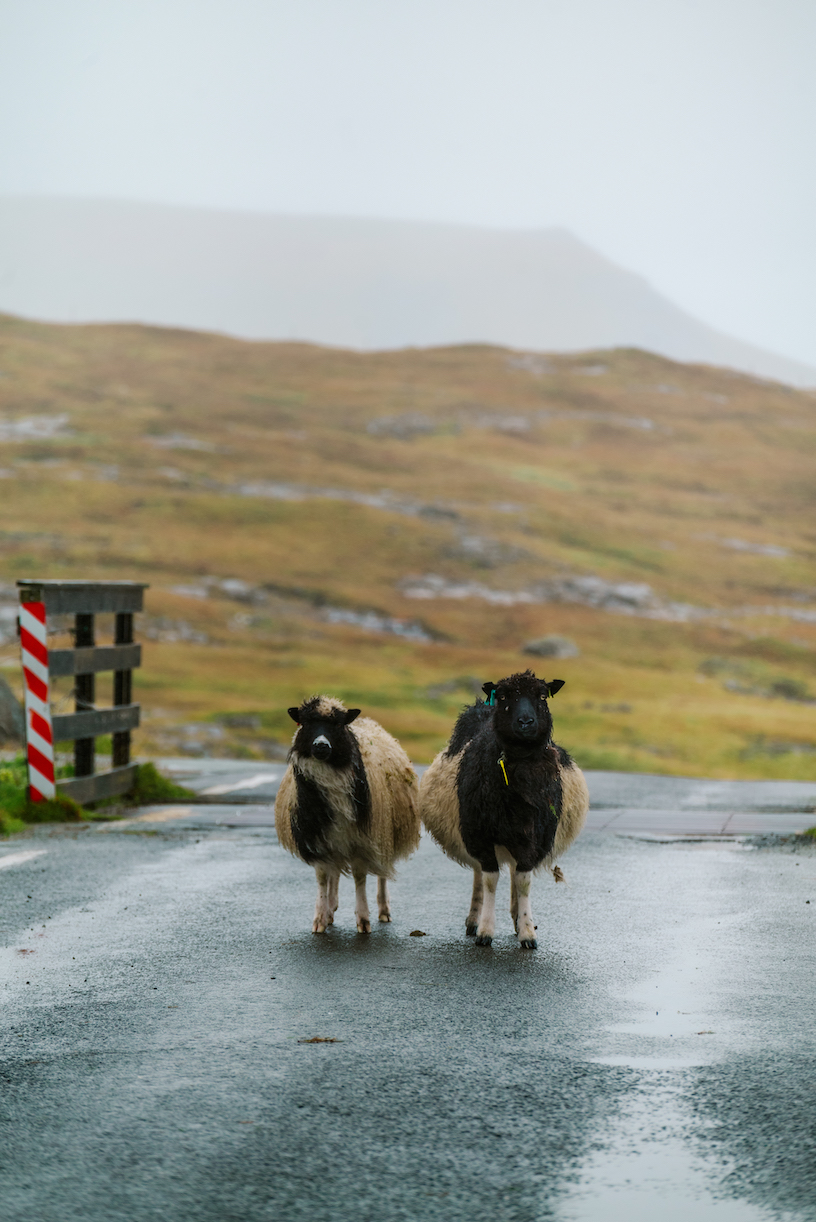
Wildlife, such as sheep and birds, freely roam, so keeping an eye out for them is crucial to prevent accidents. Speed limits are typically around 50-60 km/h in towns and 80 km/h on rural roads. Renting a car from a reliable company can enhance your travel experience, providing well-maintained vehicles and local expertise. Rent your car here!
Ferries in the Faroe Islands form a vital link between several islands, facilitating exploration and travel. Routes typically connect Torshavn, the capital, with outlying islands like Nólsoy, Hestur, Koltur, and Sandoy. The pricing and schedules for these ferries can vary depending on the season, so it’s advisable to check the official website of the Strandfaraskip Landsins (SSL), the national ferry company, for up-to-date information. Generally, tickets for foot passengers are reasonably priced, while costs for bringing vehicles aboard differ based on size and destination. Schedules are usually accommodating, providing multiple daily trips, especially during the high season, but it’s recommended to plan ahead, considering that weather conditions can occasionally impact the ferry services. The SSL website typically provides comprehensive details on schedules, ticket prices, and any additional information necessary for a smooth ferry experience across the Faroe Islands.
Helicopter rides
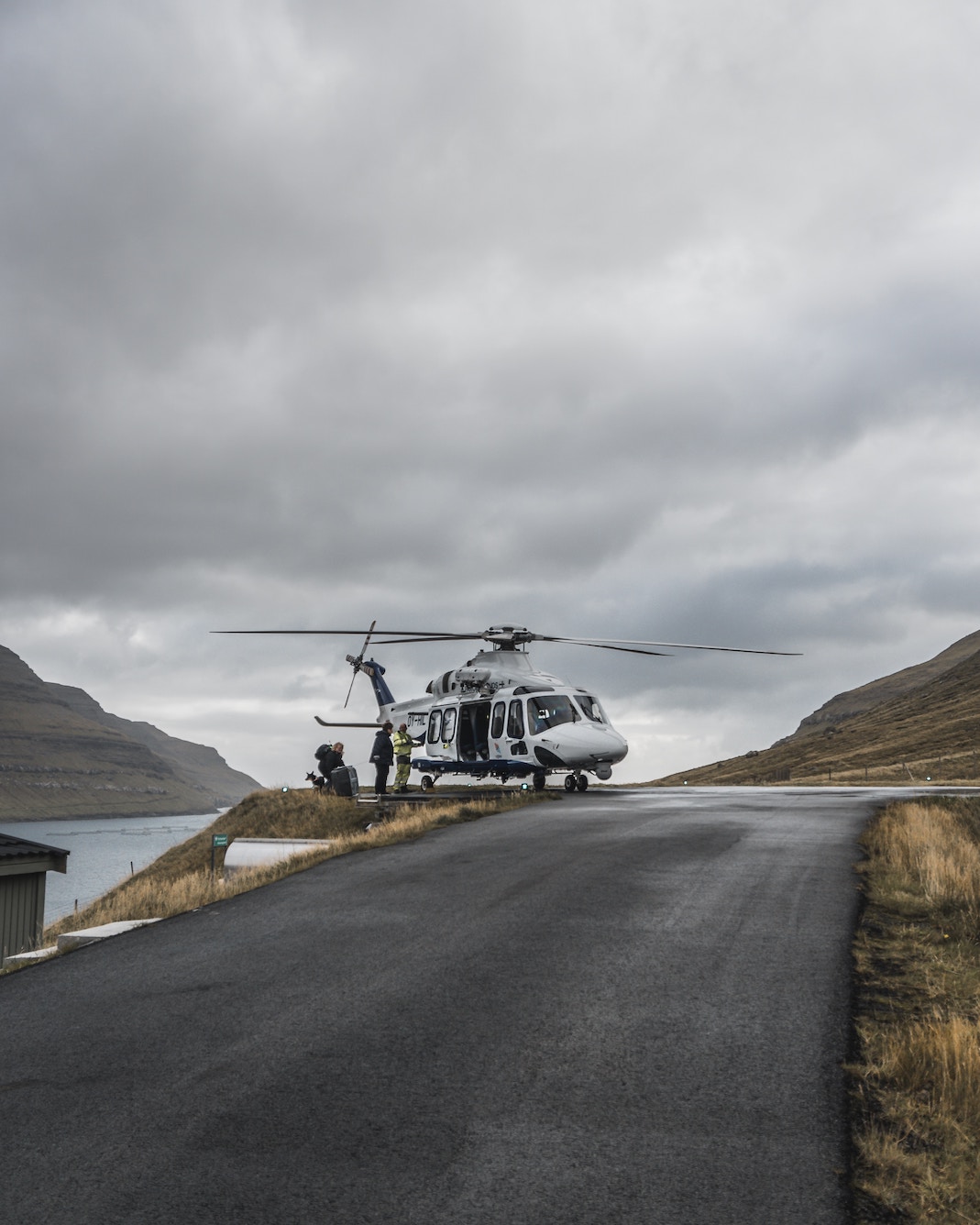
Helicopter services in the Faroe Islands offer an exceptional and scenic mode of travel, particularly during the high season. Operated by Atlantic Airways, the helicopter routes typically function from May to August, catering to both locals and tourists. These services connect the islands of Torshavn, Vágar, Mykines, and other smaller isles. Prices for helicopter rides can vary based on the specific route and the season, with costs typically higher during the peak summer months. It’s recommended to book these flights in advance due to their popularity, and also to account for potential weather-related disruptions, as the Faroe Islands’ climate can influence flight schedules. These helicopter journeys not only provide a quick and efficient way to access more remote or smaller islands but also offer breathtaking aerial views of the rugged landscapes, making the travel experience an adventure in itself. For updated information on schedules, prices, and routes, it’s advisable to check the Atlantic Airways website or contact their customer service for any additional details necessary for planning helicopter rides within the Faroe Islands.
Faroe Islands: high season vs low season
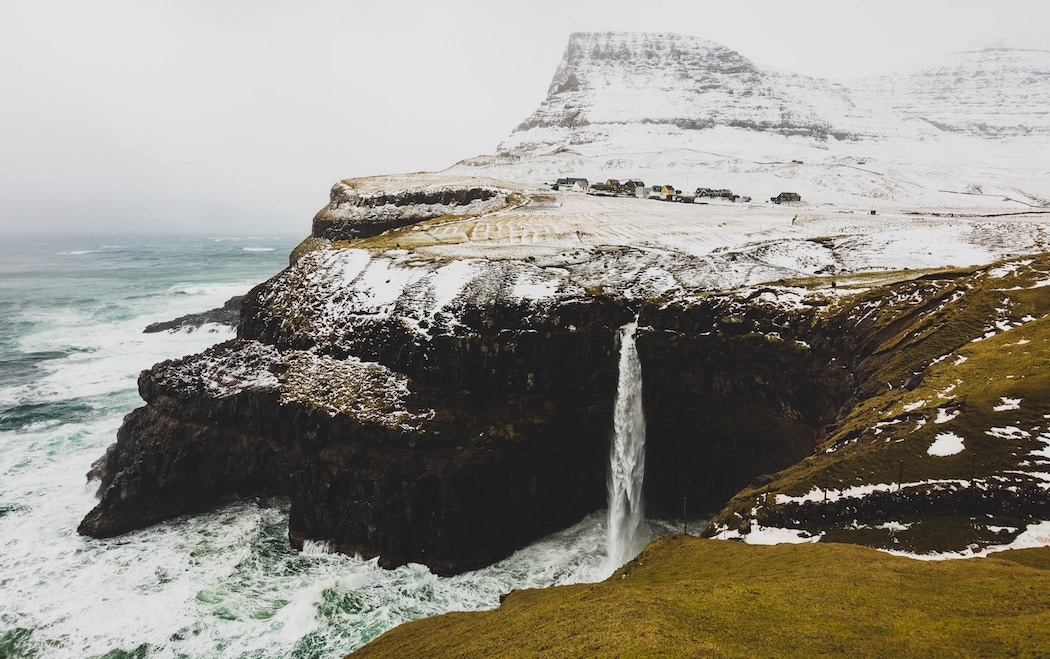
The Faroe Islands experience distinct high and low seasons, each offering unique experiences for visitors. The high season typically spans from May to August, drawing in travelers eager to explore the islands during the milder, more accommodating weather. These months see longer days, making it perfect for outdoor activities, including hiking, birdwatching, and enjoying the stunning landscapes. As for the low season, which begins in September and lasts through April, it introduces a different ambiance. With the changing weather, shorter days, and often inclement conditions, it’s a time when the islands adopt a quieter rhythm. Notably, from October 1st, many tourist facilities, including restaurants and some accommodations, start to wind down or even close for the season. While this might limit certain amenities, the low season offers the opportunity for a more serene and authentic experience, often appreciated by those seeking solitude and a closer connection with the Faroes’ raw beauty.
Where to stay in the Faroe Islands?
Strategic accommodation in the Faroe Islands often centers around Tórshavn, the capital, due to its central location and range of amenities. This puts visitors within reach of most of the archipelago’s attractions. The city offers various hotel options, from boutique stays to larger chains, catering to different preferences and budgets.
Some noteworthy hotels offering a comfortable and convenient base for exploration in Tórshavn include:
- Hilton Garden Inn Faroe Islands
- Hotel Føroyar
- Havgrim Seaside Hotel 1948
- Hotel Brandan
- Hotel Hafnia
For those seeking a more remote experience, options extend to the outer islands, offering a chance to immerse in the untouched landscapes and smaller communities. These remote stays might include guesthouses or smaller hotels in areas like Klaksvík, Gjógv, or even Mykines.
Staying with locals via platforms like Airbnb also provides an intimate experience, allowing visitors to embrace the local way of life, gain insider tips, and savor the unique Faroese hospitality in homes scattered across the islands.
One of my favorites is a farm located in Æðuvík . It is owned by Harriet, a female farmer who also sell her pictures. She takes gorgeous photographs of her animals and is currently really invested into saving the Faroese horses breed (there are only 89 left in the world at the time of writing)
Where to eat and drink in the Faroe Islands?
Here’s a list of some exceptional dining spots that offer a taste of the local flavors and global cuisines:
- Koks: Located in Kirkjubøur, this two Michelin stars restaurant is renowned for its innovative take on traditional Faroese dishes, providing an exquisite dining experience.
- Áarstova: Situated in Tórshavn, Áarstova serves up authentic Faroese cuisine, specializing in dishes like skerpikjøt (wind-dried mutton) and ræst kjøt (fermented mutton).
- Ræst: Another Michelin restaurant. Situated in Tórshavn, Ræst offers a unique dining experience where traditional Faroese ingredients are fermented and transformed into delectable dishes.
- Barbara Fish House: Located in Tórshavn, Barbara Fish House offers a casual and cozy atmosphere, with a focus on locally sourced and beautifully crafted seafood delicacies.
- Katrina Christiansen: In Tórshavn, Katrina Christiansen’s restaurant presents a fusion of local ingredients in tapas style dishes.
- Suppugarðurin : Found in Tórshavn, Suppugarðurin is a Japanese restaurant known for its authentic and meticulously prepared dishes, offering a taste of Japan in the heart of the Faroe Islands.

The best way to really experience a culture is to integrate with the locals. And in the Faroes, you can dine in the homes of Faroese people. This is called “ Heimablídni “, which translates directly as “home hospitality”. You can enjoy authentic and intimate dining experiences in people’s homes all across the islands. Find the list of places that offers Heimablídni here .
If you are craving a typical nordic cinnamon bun, or any pastry, check out Breyðvirkið Bakery. Located in Tórshavn, Breyðvirkið Bakery is known for its delightful array of baked goods, offering a variety of freshly made bread and pastries, adding a touch of local flavors to Tórshavn’s culinary scene.
The Faroe Islands also offer a range of spots to unwind and enjoy a drink. Here’s a list of places where you can savor your favorite beverage while soaking in the local ambiance:
- Sirkus Bar – Located in Tórshavn, this trendy bar offers a lively atmosphere and a wide selection of drinks, often hosting live music and events.
- Mikkeller Tórshavn – A craft beer bar situated in Tórshavn, offering an array of unique and flavorful beers, perfect for beer enthusiasts.
- Paname Café: In Tórshavn, Paname Café offers a cozy ambiance and a range of delicious pastries and light meals, providing a taste of French-inspired cuisine in the heart of the Faroe Islands.
- Fríða Kaffihús: Situated in Klaksvík, Fríða Kaffihús offers a cozy and welcoming atmosphere, known for its delightful selection of coffee and light bites, creating a charming spot for a relaxing break in Klaksvík.
- Kaffihúsið Tórshavn – A cozy café in Tórshavn serving various beverages, including coffee, tea, and a selection of wines and spirits.
Faroe Islands: Best things to do
The Faroe Islands offer a myriad of experiences for every traveler. From hiking the scenic trails that reveal breathtaking vistas to exploring charming villages steeped in history, there’s something for everyone. Nature enthusiasts can revel in birdwatching along the stunning cliffs, while photographers can capture the ethereal landscapes at every turn. Whether it’s savoring traditional Faroese cuisine, delving into the local culture, or embarking on exhilarating outdoor adventures, the Faroes promise an unforgettable journey. For a deeper dive into the best activities this captivating destination has to offer check out my dedicated blog post on the best things to do in the Faroe Islands .
You may also enjoy:
The 15 best things to do in the ….
Wild camping is actualy not allowed in the Faroe Islands. Tourist are generally expected to stay at camp sites. It is though possible to get permission from the farmers to set up a tent on their land, but that option is restricted due to sheeps and other farming considerations and is often not an option.
Thanks for letting me know. I’ve corrected the article 🙂
Great article about the lovely Faroe Islands, with loads of helpful information. I just have one correction regarding camping, it is NOT allowed to do wild camping, camping is exclusively allowed at camping sites. If you want to do wild camping, you need to contact the landowner in the area you want to camp and ask for permission, since all the land in the outfield is privately owned, and primarily for sheep to graze on. 🙂
Thank you for letting me know. I’ve corrected it!
Leave a Reply Cancel reply
Your email address will not be published. Required fields are marked *
Website URL
The Faroe Islands Travel Guide
Book your individual trip , stress-free with local travel experts
Select Month
- roughguides.com
- faroe-islands
- Travel guide
- Travel Advice
- Accommodation
Plan your tailor-made trip with a local expert
Book securely with money-back guarantee
Travel stress-free with local assistance and 24/7 support
Accessible only via plane or ferry, the remote and otherworldly Faroe Islands comprise an archipelago of eighteen wild, green and steeply pitching isles buffeted by North Atlantic winds, making for days of unforgettable adventure and some fascinating insight into Denmark’s former colonial territories (though islanders prefer the term “autonomous region”).
The islands are characterized by Denmark’s most dramatic scenery and an abundance of sheep – which, incidentally, outnumber humans and have fuelled the trade in Faroese woollen products since being worn by the cast in the iconic Danish TV series The Killing . Krone is the currency, and Danish and English are understood.
To learn more about the Faroe Islands, check out our first-timer's guide to the Faroe Islands .
Discover more places in Denmark

- Travel Guide Morocco
- Travel Guide Namibia
- Travel Guide South Africa
- Travel Guide China
- Travel Guide India
- Travel Guide Indonesia
- Travel Guide Japan
- Travel Guide Laos
- Travel Guide Malaysia
- Travel Guide Myanmar (Burma)
- Travel Guide Nepal
- Travel Guide Philippines
- Travel Guide Singapore
- Travel Guide South Korea
- Travel Guide Sri Lanka
- Travel Guide Taiwan
- Travel Guide Thailand
- Travel Guide Australia
- Travel Guide Fiji
- Travel Guide New Zealand
- Travel Guide Belize
- Costa Rica Travel Guide
- Travel Guide Cuba
- Travel Guide Guatemala
- Travel Guide Honduras
- Travel Guide Jamaica
- Travel Guide Nicaragua
- Travel Guide Panama
- Travel Guide Puerto Rico
- Travel Guide Trinidad and Tobago
- Travel Guide Albania
- Travel Guide Austria
- Travel Guide Belgium
- Travel Guide Bosnia-Herzegovina
- Travel Guide Bulgaria
- Travel Guide Cyprus
- Travel Guide Czechia (Czech Republic)
- Travel Guide Denmark
- Travel Guide England
- Travel Guide Estonia
- Travel Guide Finland
- Travel Guide France
- Travel Guide Germany
- Travel Guide Greece
- Travel Guide Hungary
- Iceland Travel Guide
The Rough Guides to Denmark and related travel guides
In-depth, easy-to-use travel guides filled with expert advice.
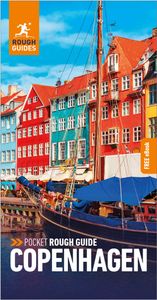
Find even more inspiration here

Planning your own trip? Prepare for your trip
Use Rough Guides' trusted partners for great rates
written by Rough Guides Editors
updated 05.05.2021
Ready to travel and discover Denmark?
Get support from our local experts for stress-free planning & worry-free travels.
- Where to stay
- Travel advice
- GAMES & PUZZLES

Faroe Islands
By: James Proctor
Paperback | 24 January 2024 | Edition Number 6
At a Glance
or 4 interest-free payments of $11.38 with
Aims to ship in 30 to 35 business days
ISBN : 9781804691373
ISBN-10 : 1804691372
Series : Bradt Travel Guide. Faroe Islands
Published : 24th January 2024
Format : Paperback
Language : English
Number of Pages : 192
Audience : General Adult
Publisher : Bradt Travel Guides
Country of Publication : GB
Edition Number : 6
Edition Type : Revised
Dimensions (cm) : 21.6 x 13.5 x 0.9
Weight (kg) : 0.22
Orders over $99.00 qualify for free shipping.
How to return your order
At Booktopia, we offer hassle-free returns in accordance with our returns policy . If you wish to return an item, please get in touch with Booktopia Customer Care.
Additional postage charges may be applicable.
Defective items
If there is a problem with any of the items received for your order then the Booktopia Customer Care team is ready to assist you.
For more info please visit our Help Centre .
You Can Find This Book In
More in travel guides.
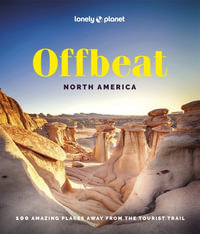
Offbeat North America
Lonely planet.
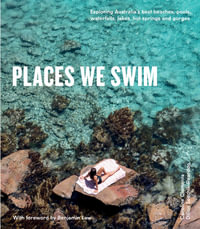
Places We Swim
Exploring australia's best beaches, pools, waterfalls, lakes, hot springs and gorges.
Flexi Bound Book

British Columbia & the Canadian Rockies
Lonely planet travel guide : 10th edition.

Lonely Planet Travel Guide : 15th Edition
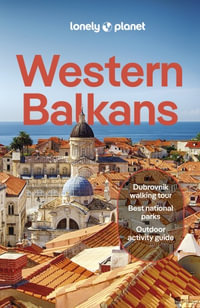
Western Balkans
Lonely planet travel guide : 4th edition.

Lonely Planet Travel Guide : 11th Edition

Lonely Planet Travel Guide : 13th Edition
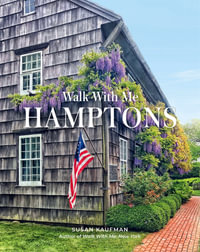
Walk With Me: Hamptons
Photographs.

Atlantic Canada
Lonely planet travel guide : 7th edition.
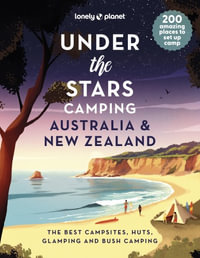
Under the Stars Camping Australia and New Zealand

Lonely Planet Travel Guide : 16th Edition
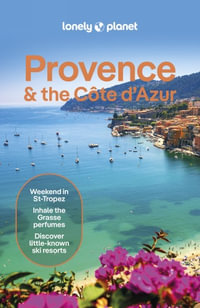
Lonely Planet Provence & the Cote d'Azur
Travel guide.
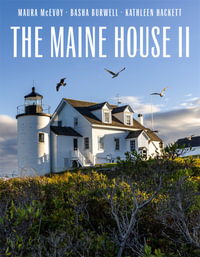
The Maine House II
Inland, inshore and on islands.
RRP $100.00

Lonely Planet Travel Guide : 18th Edition

Hidden Japan
A guidebook to tokyo & beyond.
Not Supplied By Publisher

Pocket Paris
Lonely planet travel guide : 8th edition.

Camps 12 - Free & Budget Campsites - Australia Wide (A4)
1000s of campsites * 3300+ pet friendly.
Spiral Ringed Book

Southern Italy

Best Road Trips Ireland
Lonely planet travel guide: 4th edition.

Scandinavia
Lonely planet travel guide : 14th edition.

Experience Tasmania
Lonely planet travel guide : 1st edition, this product is categorised by.
- Non-Fiction Travel & Holidays Travel Guides
- Destinations
Wild Junket

Travel Faroe Islands: A Detailed Guide and Itinerary
Last Updated on March 18, 2024
Are you planning to travel Faroe Islands? Here’s my complete Faroe Islands travel guide and itinerary with details on the best places to explore, eat and sleep in 4 days.
In the depths of the Atlantic Ocean, tiny islands with jagged peaks and vertiginous cliff faces jut out from the sea, piercing into the sky like giant daggers. Sea stacks, craggy bird cliffs and black sandy beaches dot the coast, while steep snowcapped mountains stretch across the length of the islands.
This archipelago of 18 islands lies in the intersection point of three popular destinations: Iceland, Scotland and Norway. Just like its neighbors, the Faroe Islands has it all. The Northern Lights, world-class hiking trails, an abundance of nature, wildlife and Scandinavian traditions. But few people know about them, and the Faroese prefer to keep it that way.
What makes the Faroe Islands so special to me is that it’s so rugged, wild and small. It truly feels like you’re in the middle of the ocean here. No matter where you go on the Faroe Islands, you are never more than 5 km from the coast. The country is largely covered by wilderness and even the largest towns on the island have populations in their hundreds.

Table of Contents
History of the Faroe Islands
When to travel faroe islands, by car rental, by helicopter, day tours on the faroe islands, hotel føroyar, hotel vagar, hotel gjáargarður in gjogv, where to eat on the faroe islands, how much does it cost to travel faroe islands, what to pack for faroe islands.
- Day 1: Explore Gásadalur and Sørvágsvatn
Day 2: Visit Mykines and Gjógv
Day 3: drive to kalsoy, tjørnuvík and saksun , day 4: get to know torshavn, day 5: fly home, ready to travel to the faroe islands, travel faroe islands.
The first people to settle here were Irish monks, who arrived in the 6th century. Norsemen then settled the Faroe Islands in the 9th century and the islands became a part of the Kingdom of Norway in 1035. Norwegian rule on the islands continued until 1380, when the islands became part of the dual Denmark–Norway kingdom.
The Faroe Islands came under the administration of Denmark following the 1814 Treaty of Kiel that ended the dual Denmark–Norway kingdom. After an independence referendum in 1946 (unrecognized by Denmark), the Faroe Islands were given extended self-governance with the Danish Realm in 1948.
The Faroes may be a part of the Kingdom of Denmark (just like Greenland is), but they have a cultural identity of their own and they are extremely proud of it. They have been self-governing since 1948, they have their own language (that is closer to Icelandic than Danish), traditions and customs. Ask any Faroese how they feel and they would reply, “We are not Danes — we are Faroese.”

Summer is also the best time to see puffins on Mykines island as that is their nesting season. Each summer, they gather on the slopes of the island, burrowing holes to build their nests. I saw hundreds of them on Mykines even in May during my visit – so try to time your trip to this time of the year if you want to see them.
In my opinion, you can also visit during the shoulder season (May-June and September-October) if you’re looking to travel on a budget and have the place to yourself. Whenever you choose to visit, be aware that weather in the Faroe Islands is a fickle beast at any time of year so come prepared for all eventualities.

How to Get to the Faroe Islands
As wild and remote as the Faroe Islands are, they aren’t really that difficult or expensive to get to from mainland Europe. Don’t expect to pay prices that you would for a standard flight in mainland Europe, but they are actually affordable considering what a special place the Faroe Islands is. The most common way is of course on a plane but it is also possible to get there by boat from Denmark and Iceland. Here’s a detailed look at how to get to Faroe Islands.
Flying is an easy and convenient way to get to the Faroe Islands, PLUS the views of the Faroe Islands from the air are just mindblowing. I flew there from Copenhagen and got some great aerial shots when we were about to land in Sorvagur. There are currently 2 airlines that fly to the Faroe Islands:
Atlantic Airways: the national carrier, has 2 flights per day from Copenhagen, Billund, Aalborg, Bergen and Reykjavik. A return flight from Copenhagen to Sorvagur in summer costs around US$300.
Scandinavian Airline s: this well-known carrier now runs daily flights to the Faroe Islands from Copenhagen. It also has direct flights from London, Reykjavik and Copenhagen to Sorvagur.
Search for flights to Faroe Islands
Smyril Line’s ferry, M/S Norröna, sails to the Faroe Islands from Hirtshals in the north of Denmark and from Seyðisfjørður in Iceland. It doesn’t sail frequently though, so make sure to check by its website for the scheduled departures. The best thing is that the ferry acts as a car ferry so you are allowed to transport your vehicle on it (at an extra cost).
This can make it quite a good deal if you rented a car in Iceland or Denmark and want to drive it here to save money on accommodation. The only thing to be aware of is that under rough seas the ferry may not be able to dock.
How to Get Around the Faroe Islands
Seeing that the Faroe Islands are so wild and rugged, they are surprisingly accessible by various modes of transport: car, ferry, helicopter and bus. Of all them, car and ferry are the best way to get around the Faroe Islands. Much of the Faroe Islands are covered by wilderness and many of the most beautiful and interesting sights are only accessible by small roads that zigzag through steep mountains.
There is a good public bus network that runs all over the islands, but buses don’t go to many of these remote but essential sights. Helicopters are surprisingly cheap, as they are subsidised by the government, so consider booking a helicopter flight if you are short on time.
I would highly recommend renting a car even if you are on a budget. I booked my car rental from Guide to Faroe Islands and the total cost of a 4-day rental was around 3,500 DKK (US$550). Get a friend to come along or find a travel partner online to split the car rental cost. I didn’t get a 4WD, but it might be useful if you intend to drive off road. A 4×4 cost around US$113 per day, while a compact car cost $90 per day to rent. Check here for car rental options!
When driving around the Faroe Islands, pay attention to the driving conditions and rules. Most roads are single lane, and it’s not allowed to overtake other vehicles on most highways. As the Faroe Islands are relatively mountainous, you’ll find yourself going up and down slopes and winding along fjords. Don’t be too distracted by the scenic landscapes when driving and only pull up when there is a road shoulder or parking space!
Book your Car Rental here!

To cross from one island to another, the ferry is the easiest, cheapest and most convenient choice. You can go to the island’s municipal website to check the ferry schedule. Most of them don’t need an advanced booking, except for the Mykines ferry that gets booked up easily (go here to book it in advance). You won’t make any payment when booking in advance — make sure you have cash to pay when you’re boarding the ferry.
Some towns (e.g. Sorgavur where you pick up the ferry to Mykines) do not have ATMs. Many islands are also served by car ferries — such as Kalsoy — and they usually don’t take advanced booking. So be sure to get there 30 minutes early to get in line.
If you’re looking to go to Skuvoy or another lesser-visited island during the low-season, you are best off giving a call to order that ferry. The fare isn’t extra, but they simply don’t run it otherwise. Be sure to check the ferry schedule always ahead of time.
For more information, including ferry schedules, head to Strandfaraskip Landsins website .

Atlantic Airways , the national carrier, also has a network of helicopter services to connect the islands. The service is subsidized by the government so it’s quite cheap and almost the same price as the ferry. For instance, you can fly from the main airport at Vagar to Mykines and the capital Torshavn. As you’d expect they save you time and offer some spectacular aerial views of the islands. I was going to book a helicopter ride to Mykines but it was fully booked at the time, so be sure to reserve a seat in advance.
Book your domestic flights here!

The main inter-town bus that they have is called Bygdaleiðir, w hich are easy to spot as they are dark blue. Check here for the complete timetable of the buses. It helps to note, however, that public transportation is expensive in the Faroe Islands, so it’s best to buy a travel (multiple-ride) card beforehand with Strandfaraskip Landsins at the airport or at the main bus terminal in Torshavn. This travel card covers busses and ferries around the islands (except to Mykines Island) and can cost 500 DKK (USD78) for 4-days.
Within the Torshavn municipality, the bus lines are free and there are six lines that operate in the area. In addition, these buses also will transport passengers out to the historic city of Kirkjubøur, a must-see for anyone interested in learning more about the history of the Faroe Islands and the people that inhabit them.
For solo travelers who cannot or prefer not to drive, it is possible to explore the Faroe Islands by booking day tours. These day tours are also great for those who are seeking adventure in the form of kayaking trips or horse-riding excursions. Day tours in the Faroe Islands are not cheap, but they tend to be about the same price as a day of car rental. I recommend booking your day tours on Guide to Faroe Islands, which has the most options to choose from. Here are some day tours I recommend:
- Kayaking to Dranganir — Row to the famous sea-stacks Drangarnir and further to the Tindhólm or Gásadal where you can feel the spray from the free-falling waterfall Múlafossur.
- Guided tour of Mykines — Visit Mykines with a local, see puffins and hike all about the island.
- Vestmanna Sea Cliffs — Hop on a boat trip along the base of Vestmanna Sea Cliffs.
- Horseriding around Torshavn — Horseback riding is a unique opportunity to explore the rough landscape around the capital Tórshavn.
- Home dining experience — Enjoy an authentic Faroese dinner in a private home called Hanusarstova, originally built in 1898 and totally renovated in 2014.

Where to Stay on the Faroe Islands
There’s a good variety of accommodation providers on the Faroe Islands, with at least one guest house in every town (not village though). I found that even remote areas like Gjogv and Mykines had very good accommodation standards. Every single guest house and hotel I stayed at was comfortable and excellent.
Camping in the Faroe Islands, sadly, is only permitted at designated campsites. It is not permitted to stay overnight in your campervans along the road, at rest stops, lay-bys or view areas. Because of the unpredictable weather even in summer, it is advisable to have sturdy, waterproof and windproof camping equipment.
This is easily the best hotel in the Faroe Islands. The stylish four-star hotel is perched on the hilltop of Torshavn, overlooking the city from above. It’s very modern and elegant, perfect for the last stretch of your trip. The setting is dramatic and the atmosphere here even more so. Plus there’s a spectacular view of the capital city and bay right from your room window (pictured below). Check the rates.

Located right next to the airport, this simple hotel makes you feel like you’re in the countryside surrounded by sheeps and plains. Love the black exterior and Scandinavian design. Great base to explore the Bøur, Gasadalur and Sorgasvatn areas. It’s also perfect for those who land late or have an early morning flight the next day as it’s within walking distance from the airport. Book here!

Possibly my favorite hotel in the Faroe Islands, this quaint guesthouse has an old-world charm and stunning views of Gjogv. The main building is a typical Nordic wooden cottage (pictured below) painted in black with turf grass on its A-frame roof. It also has several new rooms which are separate from the main building. They are very tastefully designed and spacious. Book here!

This is one aspect of the Faroe Islands that I sadly failed to experience. Since I mostly bought food at the supermarket (to save money), I didn’t try much of Faroese food. A meal on the Faroe Islands can set you back at least 20-35 euros, even for a simple guesthouse meal.
My guide in Torshavn explained that the most popular local food in the Faroes is fermented lamb meat which is made in everyone’s home. After slaughtering the sheep in their own homes, their meat – still warm – will be hung in a special drying hut and left to dry with the natural saltiness of the air.
That said, dining choices on the Faroe Islands are actually quite limited. You won’t find any restaurants or cafes in villages (and there are only around three towns in the Faroes besides the capital). If you’re lucky, you might find a guesthouse that serves coffee and some simple snacks in the more visited areas.
The best restaurants on Faroe Islands are all located in the capital city of Torshavn. The habit of dining out only started 25 years ago in the Faroes. As a result the dining scene is still in its infant years. However, there are quite a few of upscale restaurants in Torshavn that are highly recommended by my guide.
- Barbara Fish House: a traditional seafood restaurant in the historical quarter of Torshavn, best known for its Barbara fish soup and set menu.
- Aarstova: another long-time fixture in the local dining scene, serves up the best roast lamb in town.
- Etika: a modern and stylish bistro that offers interesting takes on Japanese-Faroese fusion cuisine.

In my opinion, the Faroe Islands only has one big flaw: it’s expensive. Anyone who’s been to Nordic countries will know how pricey things can be in this part of the world. Prices in the Faroe Islands are comparable to that in Norway. Accommodation prices start from 35 euros per person for a hostel bed and 100 euros for a three-star hotel. Restaurant prices are around 20 euros for a meal and ferries cost around 15 euros return.
However, there are ways to keep your budget down. I bought food from the supermarket and made my own sandwiches for lunch and soups for dinner. I also met a few American travelers who had rented a jeep with a tent on the top-bunk to save money on accommodation. Another traveler I met saved money on car rental and instead traveled around the islands by public transport.

If you’re traveling Faroe Islands between May and September, you should pack for chilly weather. 2-3 layers should do: a wool bottom, a fleece, and a thin water and windproof outer layer. For those traveling in fall and winter (September to December), you’ll need 4-5 layers: the above mentioned, plus a thermal layer at the bottom and a down jacket or thick winter parka.
I’m a strong believer in ‘less is more’. The less you travel with, the more convenient it will be to move around. If you can’t see yourself using something daily, you probably don’t need it.
Here are some of the essentials to pack for a trip to Faroe Islands:
1. Long Sleeve Moisture Wicking Tees : The key to staying warm on the Faroe Islands is layering. Bring some long sleeve t-shirts that are great for hiking, that you can easily remove throughout the day and night.
2. Fleece-lined Long Sleeve Thermal Underwear : Pack thermals even if you’re traveling in summer. Mine turned out to be very useful and I wore it several days in a row. Temperatures can dip below zero – and they’ll be particularly useful if you’re camping.
3. Fleece Base : This is my favorite gear for cold climates. It’s thick but lightweight, and keeps me warm even in sub-zero temperatures. Plus most fleece are cheap and easy to find everywhere. I usually get one that can be zipped all the way down, so I can easily remove layers when I’m warm.
4. Soft Shell Jacket : Pack a thin waterproof, soft shell jacket regardless of the weather you’re traveling. It’s particularly useful for the rain. This also acts as an extra layer between your shirt and down jacket or parka. I used this almost everyday on my trip.
5. Quick-Dry Pants : These are something I wear on almost every trip. They’re lightweight, thin, comfortable and waterproof. I can wear them in winter and summer, without feeling too warm or cold.
6. Fleece-lined Leggings : For ladies, these are brilliant to keep warm and comfortable, being looking too shabby. I usually wore them without any pants over them.
7. Hiking Boots : A pair of sturdy hiking boots that are waterproof and protective for hiking in mud, streams or snow. I’ve used mine for around 2 years now and they’ve been to many countries and different types of terrain with me. Instead of getting those high boots that are ridiculously heavy and thick, I think it’s better to travel with hiking boots like these. Mine were perfect for Iceland.

Travel Faroe Islands: 4-Day Itinerary
Day 1: explore gásadalur and sørvágsvatn.
14.05 Arrival with Atlantic Airways from Copenhagen. Pick up keys for rental car at the 62N desk in the arrival hall of the airport. Drive straight to Hotel Vagar , just a 5-minute drive from the airport. Check in and take a quick rest.
15:30 Drive to the villages of Bøur and Gásadalur , just 5 mins from the hotel. Both villages are absolutely stunning, but the Múlafossur waterfall in particular is the icon of the Faroe Islands. The whole assembly of the cascade tumbling down the cliff’s edge, backdropped by the imposing mountains behind the tiny village is a truly dramatic one.
This iconic picture has been featured in many publications including National Geographic. It’s one of the things that have put the country on the tourist map and appear in every Faroe Islands travel guide. When you emerge from the car tunnel (that was built recently, previously the village could only be accessed by foot), you’ll see this exact view.

18:00 Go on a leisurely 2-hour hike around the Sørvágsvatn lake right near the hotel.
You may not have heard of it — but I’m sure you’ve seen a photo of it. The biggest lake on Faroe Islands is famous for the optical illusion that appears where the lake flows into the Atlantic Ocean. In reality, it doesn’t look like an optical illusion at all; it only appears so in photos. But it’s still a scenic place for a hike. Walking along the water’s edge to the hilly top where the lake flows into the ocean is simple and easy and takes just two hours.

10.00 Drive to Sørvágur ferry terminal and take the boat to Mykines . Spend the day on the island, hike to the lighthouse and the puffin and gannet colonies. Remember again to book your ferry tickets or helicopter flight in advance. Alternatively, book a guided tour of Mykines to explore the island with a local and go deeper under the surface.
As the westernmost of the 18 main islands on the Faroes, Mykines is wild and rugged, with no roads and just hiking trails crisscrossing the isle. It’s famous for large numbers of puffins that inhabit the Mykineshólmur area. The Mykineshólmur hike takes around three hours return and well worth the effort as it takes you up ridges and down the vertiginous walls of the island to the northernmost tip of the island.
Before the trip, I was worried that a day on Mykines wouldn’t be enough to see the famous islands. But seven hours are actually more than enough to hike all over the island and even have a drink at a local cafe. Remember to bring a packed lunch so you can enjoy the hike as much as possible, but there are also small restaurants in town.
Book a Guided Tour of Mykines

17.05 Catch the boat back to Sørvágur and drive towards Gjógv. Check into the guesthouse Gjaargarður .
L ocated on the northeast tip of the island of Eysturoy, this remote village is only accessible by one road. You do kinda have to go out of your way to get there, but trust me, it’s worth every minute of the drive. The journey there is an experience on its own, weaving through mountains and in between fjords. The village itself has an extremely dramatic setting: with imposing snow-peaked mountains forming the backdrop and the rocky outcrops forming the foreground, being tormented by massive waves of the Atlantic Ocean.
You’ll probably get there pretty late, but daylight hours are very long in summer so you’ll still be driving when it’s light out.

09:00 Drive to Klaksvik and catch a car ferry to the island of Kalsoy . Alternatively, book a day tour departing from Torshavn which will bring you on a hike.
This island between Eysturoy and Kunoy is wild and remote, o nly accessible by car ferry. The narrow islet has just one road linking north to south. The road meanders along the coast at first, revealing clear views of the striated rock faces of the neighbouring island. I recommend driving all the way t o Trollanes in the northernmost tip of Kalsoy, where the road ends and hiking trail begins.
The steep hike leads you to the Kallur lighthouse that’s perched on a vertiginous slope. It takes around two hours to reach the lighthouse but it involves steep climbing in the initial part of the hike. From the lighthouse, you get a view of the back face of the mountain and the hollow cave on the underside. It’s home to huge kittiwake colonies.
Book your Day Trip!

13:00 On the way back visit the village of Mikladalur and see the new statute of the Seal woman. This 9 ft bronze and stainless steel statue of Kópakonan (The Seal Wife) was created by Hans Pauli Olsen and was installed in the Mikladalur Harbor on August 1st, 2014. The statue commemorates myths about selkies (seal women) and in particular two well known myths about the Seal Wife on the Faroe Islands.
One well known story is about a beautiful Selkie trapped by a fisherman on the island of Kalsoy, who hides her seal skin while she is on land one night. One day however, he goes fishing and she finds her seal skin hidden in a chest in their home. She escapes and leaves behind a message to not follow her and to not harm her Selkie family. The fishermen however ignore the warning and end up killing both her Selkie husband and Selkie children. In revenge she curses the men of the island to die in frequent accidents until as many have perished as can link arms around the whole island.

15.30 Catch the car ferry back to Klaksvík. From there, drive to the village of Tjørnuvík with view to the seastacks Risin and Kellingin, the Troll and the Witch. You’ll be driving along the large waterfall Fossá.
Tjørnuvík is known for its special hymn singing, the Kingo-songs, which is an ancient hymn tradition that originates from the Danish hymn writer Thomas Kingo. The village has a choir that performs Kingo hymns. Tjørnuvík also has a nice sandy beach and striking waves that attract many surfers.

18:00 Visit the village of Saksun where you can walk along the beach towards the ocean. Saksun has a beautiful lagoon surrounded by sand in the fjord. The tall mountains give the area an air of mystery, but not least unimaginable beauty. The fjord used to be a good natural harbour, but after a heavy storm in the 1600s, the fjord was blocked with sand.
20:00 Drive to Torshavn and check in at Hotel Føroyar , the best hotel on the Faroe Islands.

10.00 Go on a walk in the old part of Torshavn the capital city, Reyni,and Tinganes, where the Government sits. Its historic harbour area actually has one of the earliest governing meeting points in the world! The quaint town is an excellent place to just wander and get lost. Learn about the Faroese history and try some of its local food in the restaurants I recommended above.
Paintings, drawings, sculptures, and graphic design are on display at the National Museum of the Faroe Islands , on the edge of a small park close to Nordic House. The permanent collections of individual historic and modern artists, such as the 20th century painters Sámal Joensen-Mikines and Ruth Smith, have been assigned their own rooms.
Don’t miss the fish market that’s located right by the harbor next to downtown Torshavn. It’s a busy area with lots of people bidding for fish that have been just caught from the sea.

12:00 Drive to the nearby Kirkjubøur village. This is the site of the country’s most important historical site with the ruins of the Magnus Cathedral from around 1300 and a runestone found near it. The stone which is referred to as the Kirkjubøur stone dates back to the Viking Age.

13:00 Drive to the village of Vestmanna and join a boat tour along the Vestmanna Seacliffs. The Vestmanna boat trip costs around $45 and will bring you up close to the cliffs for a chance to see the rich birdlife.
There are many tours to choose from, the most popular however being the boat-tour to the renowned Birdcliffs and Grottos north of Vestmanna, the Vestmannabjørgini. This is one of the biggest tourist attractions in the Faroe Islands.
They’ll take you through narrow sounds, into deep grottoes, carved by the surf through ages, and close to the over 1500 feet high-rise cliffs where thousands of seabirds are nesting. I thought it was extremely impressive – just cruising under the sheer cliffs and seeing sheeps cling on to the edges was an experience on its own.
Book your Boat Trip here!

08:00 Departure from Vágar Airport with Atlantic Airways. Drop your car keys off at 62N/Information desk. Be at the airport by about 7:00 (drive from Tórshavn takes about 1 hour).
Bid farewell to the Faroe Islands!
Thank you for reading this far! Now, I wonder, are you planning a trip to the Faroe Islands soon?
I hope this Faroe Islands travel guide and itinerary, detailing the best places to explore will help you have an amazing time there, just as I did.
And I also want to hear from you: did you find this Faroe Islands travel guide helpful?
Feel free to leave any questions you may have in the comments below. I’ll be more than happy to answer them!
For those who are planning to travel more, check out some of these articles:
- Seeing Puffins in Mykines, Faroe Islands
- Greenland Travel Guide: All You Need to Know
- 13 Cool Things to Do in Ilulissat, Greenland
- My Complete Iceland Travel Guide
- Northern Lights in Iceland: A Guide on Where and How to Find them
- My Iceland Packing List: What to Pack for Iceland Any Time of the Year
- Iceland with Kids: How to Plan Your Iceland Family Vacation
My Iceland Ring Road Itinerary
- Review: Staying at Hotel Ranga, Iceland
- Renting a Car in Iceland: Planning an Iceland Road Trip
- Ice Climbing on the Solheimajokull Glacier, Iceland
Disclaimer: This post contains affiliate links i.e. if you book a stay through one of my links, I get a small commission at NO EXTRA COST to you. Thank you for your support!
Inspired? Pin it!

Disclaimer: Thanks to Visit Faroe Islands for assisting me with this trip! As always, my opinions expressed above are my own.
Nellie Huang
Nellie Huang is the founder of WildJunket. Originally from Singapore, Nellie has traveled to over 150 countries across 7 continents. She is a book author and Lonely Planet guidebook writer. As an adventure travel blogger, she has a special interest in unusual destinations and deep experiences. Follow her travels on her Facebook and Instagram .
Leave a Comment Cancel Comment
Save my name, email, and website in this browser for the next time I comment.
This site uses Akismet to reduce spam. Learn how your comment data is processed .
The Comments
Brittany from Boston
The Faroe Islands look so so lovely! I especially want to see the puffins!!!
Thank you! I’m in Kyrgyzstan at the moment and then Singapore in two weeks. How about you?
Your article is so helpful. Thank you for putting this together with such wonderful details and recommendation.
Thank you and glad you found it useful!
Hi Thank you for the guide. Do you think walking/hiking poles is necessary? Thanks
hi Wendy, thanks for the comment! It depends on how much hiking you intend to do. If you’re following my itinerary then no hiking poles are needed. I did mostly short hikes and they’re relatively easy. I only recommend hiking poles for multi-day hikes.
Thank you!! This guide is super-helpful in planning my trip there next year. Thanks for taking the time and even adding the links. Very excited!!
Thank you! Very helpful. :)
This is awesome! Thank you for sharing! Will be going to Faroe this coming September and this helps us a lot.
itinerary sounds great. could we work in some sea kayak rental, and where would be the best place to kayak
I didn’t rent a sea kayak there but I think it’s possible to sign up for a guided kayak tour.
Mona Keffer
I absolutely loved reading this article. Your article is very detailed and informative. Faroe Islands are on my bucket list now. Thanks to your fantastic article!
You’re welcome! Glad you’ve found it useful!
What a great article! We’re currently dreaming of going to Faroe islands again – we’ve been there before and we love, love love it! Here’s to a year with loads of travel plans and new experiences!
– Veronika
You May Also Like
Norway road trip: my 7-day norway itinerary, visit senegal: my detailed senegal travel guide & itinerary.
- Monthly Guides to the Faroe Islands
- Family-Friendly | The Complete Guide
- The people of Bøur | Village Guide
- 72-hour guide
- Adventure Sports
- Birdwatching
- Family-Friendly Faroes
Farmtourism
- Fishing & Angling
- Get Creative
- Guide to safe hiking
- Horse riding
- 24-hour guide
- CULTURE & ATTRACTIONS
- Get inspired before your visit
- Sightseeing in the Faroe Islands
- Christmas in the Faroe Islands
- Churches of the Faroe Islands
- Getting to the Faroe Islands
- Getting around
- Rent a bike
- Public transportation
- World first under sea roundabout
- Hiking Guidelines / Restrictions
- Safe Travel
- ACCOMMODATION
- Guesthouses & B&BS
- PRACTICAL INFORMATION
- Faroese tourism providers
- International DMCs
Regional Information Centres
- Maps of the Faroe Islands
- Hang- and paragliding
- Vegan guide to the Faroe Islands
- BEFORE YOU ARRIVE IN THE FAROE ISLANDS
- Accessibility for disabled
- Advice for LGBT travelers
- Electricity
- Electric cars
- Health & safety
- Passport and Visa
- Phones & internet services
- Postal service
- Public holidays
- Storm statefy in the Faroe Islands
- Tax-free shopping
- Useful numbers & service
- What to pack
- Tourism strategy 2030
- The Faroe Islands in a seashell
Sustainability
- Europe's best kept secret
- Quick facts
- Did you know?
- ART, CULTURE AND SPORTS
- Architecture
- HISTORY, GOVERNANCE & ECONOMY
- Government & Politics
- History of the Faroe Islands
- History of the Faroe Islands - timeline
- National symbols
- PEOPLE & SOCIETY
- A conversation with a Faroe Islander
- Faroese food
- Faroese Language
- Stóra Dímun
The people of the Faroe Islands
Restore Nature
- MYTHS & LEGENDS
- The giant and the witch
- The seal woman
- GUEST ARTICLES
- Tórshavn marathon
- The food culture of the Faroe Islands
- The Faroe Islands... through the eyes of a New Yorker
- Fog with a chance of hihing in the Faroe Islands
- G! festival: cue the music for nature lovers
- Sheep farming in the Faroe Islands
- Discovering the Faroe Islands by bicycle
- Suðuroy: A hikers's haven
- Uncovering a different side to the Faroe Islands
- MARKETING & DEVELOPMENT CAMPAIGNS
- SheepView360
- Faroe Islands translate
- Remote tourism
- #Færøernefindesfaktisk
- Imagine the Faroe Islands
TOURISM SITES
Professional sites, press & professionals, closed for maintenance, open for voluntourism, join the preservolution, faroe islands fam-shop, closed for maintenance føroyar, you haven’t got any favourites yet.
This is where you can collect inspiration, articles, events and places that interest you.
Click the icon on pages and they’ll appear here.
Your favourites
Inspiration & articles, events & tours, inspiration & articles, events, tours & hikes.
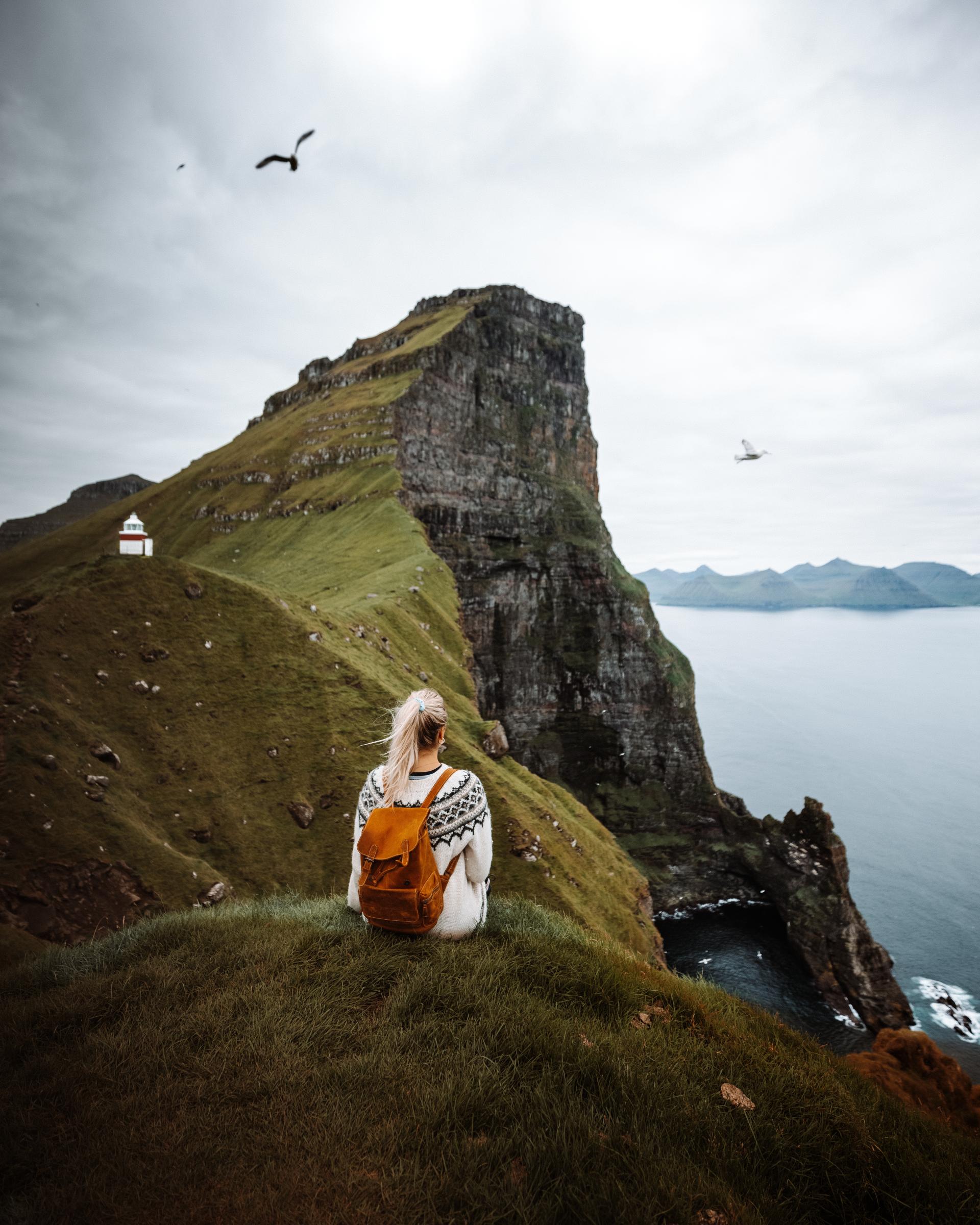
One of the many special features of the Faroe Islands is that you don’t have to go far to experience magnificent nature, with dramatic cliffs, rolling green hills, and hidden waterfalls close by, every trail offers stunning scenery and a sense of solitude. Look around you. Take a few steps. Take a deep breath and listen. It’s all right there!
We are located only 2-3 hours flight time from mainland Europe and have direct flights from various destinations depending on the season.
Although the Faroe Islands are one of the safest countries in the world, travelling in the Faroe Islands might be different to what you are used to. It is important you are well aware of things like weather extremes, narrow, windy roads and different road rules before you begin your journey.
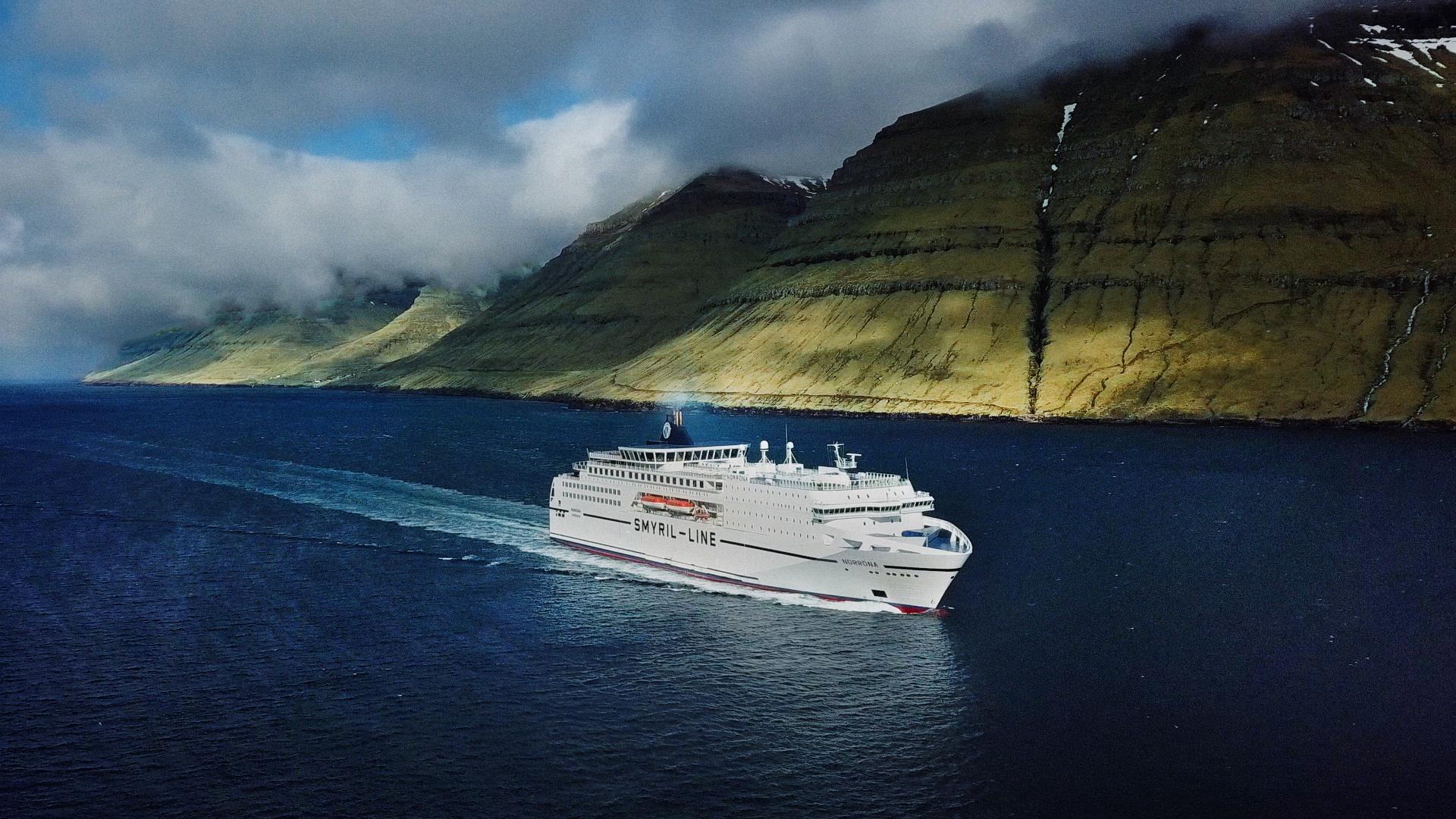
Start your journey on board the ferry, M/S Norröna – you’ll feel you’re on holiday as soon as you have the water beneath you. Direct link from Iceland and Denmark to the Faroe Islands
“Góðan dag”
Come and experience what the Faroe Islands have to offer
START YOUR FAROESE ADVENTURE HERE
Things to do in the Faroe Islands
How to travel during the strike
Heimablídni: Dining with locals
24hrs Guide
in the capital
Hiking Guidlines / Restrictions
Handball: A player's journey
Open for Voluntourism
Faroese Tourism Providers
Myths and Legends
How to get around
Plan your stay
Getting to the faroe islands.
Accommodation
Getting Around
Tour Operators
“Everything about the Faroe Islands is extreme and slightly bonkers” Jo Ellison, Finanical Times, 2022
#visitfaroeislands
We use cookies.
You can read more about our use of cookies and turn them of in the settings
Visit Faroe Islands
Personalize cookies
About Cookies
- Cookie Settings
- Privacy & Policy
Privacy and Policy

Faroe Islands Itinerary Suggestions for 3-9 Days (+Map & Practical Tips)
By Author Jurga
Posted on Last updated: January 23, 2024
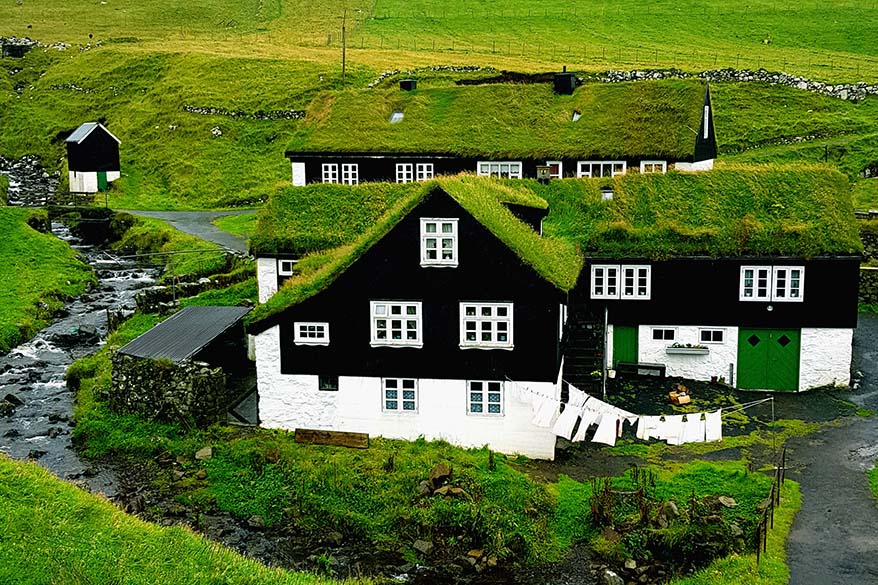
The Faroe Islands is a place of rugged landscapes, harsh weather, and unspoiled natural beauty. Europe’s best-kept secret, little known and unexplored, waiting to be discovered by those who know how to appreciate it.
We learned that the literal translation of the Faroe Islands actually means the Sheep Islands . This alone was enough to convince us to visit these remote islands with countless shades of green, millions of birds, and indeed, more sheep than people….
Do you also want to visit the Faroe Islands, but are not sure where to start? In this post, I’m sharing our complete Faroe Islands self-drive itinerary for 9 days . It covers all the most beautiful places that you shouldn’t miss in the Faroe Islands, as well as some less-visited locations and incredible hidden gems.
In addition, I’m also sharing the best Faroe Island itinerary suggestions for 3, 4, 5, 6, or 7 days . You can find those at the bottom of the article.
If you love the outdoors, adventure, and quiet places where time seems to have stood still, then you probably know how increasingly difficult and challenging it is to still find a travel destination that ticks all these boxes. Faroe Islands is such a place, and it’s closer and easier to visit than I always thought it was.
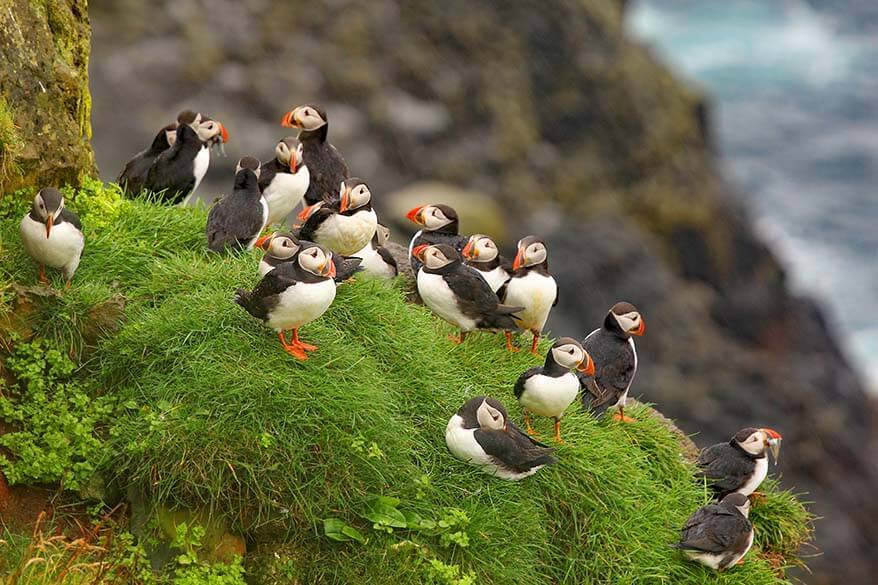

How much time do you need for the Faroe Islands?
While you can see the main highlights of the Faroe Islands in 4-7 days, staying a few days longer makes for a more relaxing trip and gives you an opportunity to visit remote islands and also do some hiking. As a minimum, I suggest you spend 4-5 full days in the Faroe Islands.
Many people travel to the Faroe Islands for just a few days, but we wanted to explore the main islands to the fullest, and so we spent 9 full days in the Faroe Islands 11 including travel days.
TIP: If you are visiting the Faroe Islands for the first time and are not sure where to start, you can also opt for organized tour packages . They include daily tours to the best places in the Faroe Islands and you can just stay in Torshavn during the whole trip.
The most popular option is this 6-day tour package that covers all the main highlights of the Faroe Islands. All you have to do is book your Torshavn accommodation and a tour package, and they’ll pick you up for a different tour every morning.
Another great option is this new all-in 8-day package that, in addition to all tours, also includes Torshavn accommodation, airport transfers, and more.
How to use this Faroe Islands itinerary
You can use our Faroe Islands travel itinerary for inspiration and make sure to also check our suggestions for any trip. But keep in mind that you’ll have to make your own trip itinerary as a lot depends on available accommodations and also on the ferry timetables .
To help you plan your trip, we included a handy MAP for searching all available hotels and Airbnbs for your travel dates . You can find it at the bottom of this article.
For more practical information , please check our first-timer’s guide to visiting the Faroe Islands .
I also created a map indicating all the places mentioned in this post. It should help you get a better idea of where everything is and plan your own Faroe Islands travel itinerary. See below.
How to use this map: Use your computer mouse (or fingers) to zoom in or out. Click on the icons to get more information about each place. Click the arrow on the top left corner for the index. Click the star next to the map’s title to add it to your Google Maps account. To view the saved map on your smartphone or PC, open Google Maps, click the menu and go to ‘Your Places’/’Maps’. If you want to print the map or see it in a bigger window, click on ‘View larger map’ in the top right corner.
TIP: The Faroe Islands are a paradise for hikers and some of the most beautiful places can only be reached on foot, so pack your hiking gear and explore. Here you can read more about 5 spectacular hikes that you shouldn’t miss in the Faroe Islands .
If you click on the hike icons indicated in the map above, you’ll see a number by each hike. Those numbers correspond to the numbering used in the ‘Hiking in the Faroe Islands’ brochure issued by Visit Faroe Islands. You’ll be able to find this hiking brochure at all tourism information points and some hotels on the Faroe Islands.
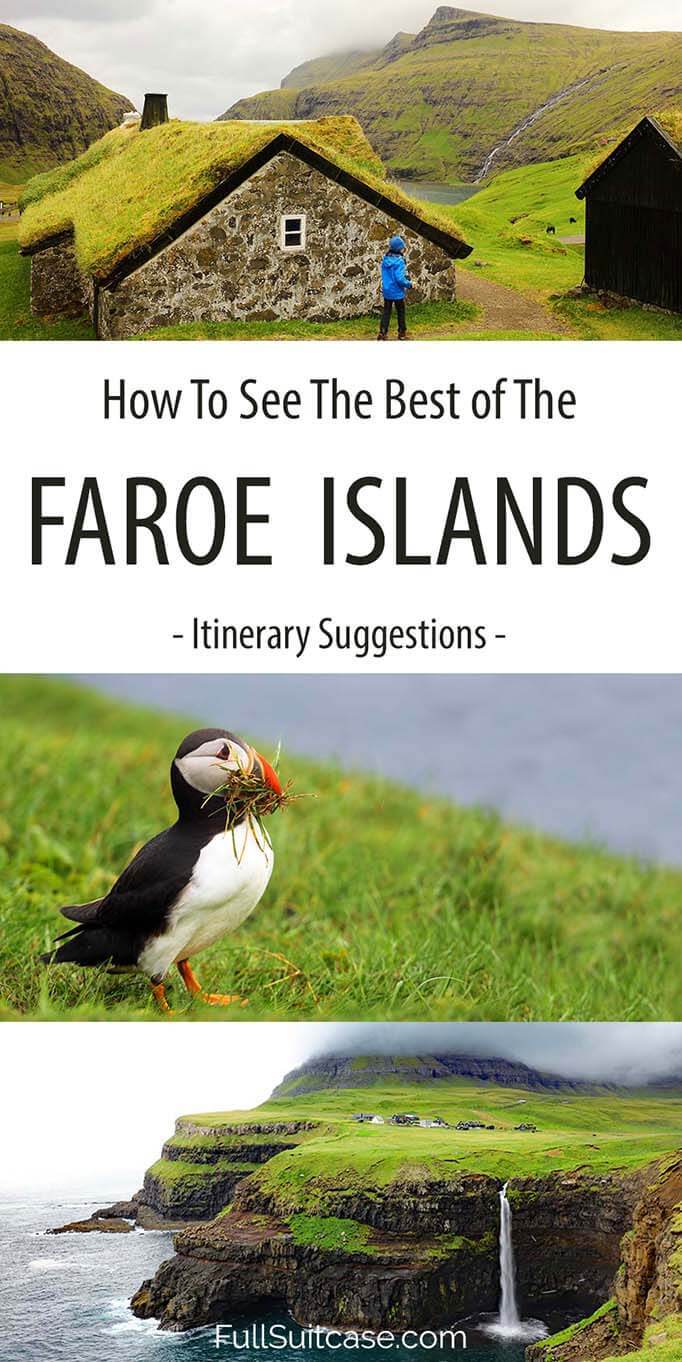
Day 1: Streymoy Island: Saksun, Tjornuvik, Vestmanna
Streymoy Island is the largest of the 18 Faroe Islands, home to the capital city of Torshavn and to almost half the population of the Faroe Islands. But don’t worry, even here it’s quite easy to escape the people and get a good feel of what the Faroe Islands are all about.

Oyggjarvegur Scenic Road
The scenic road Oyggjarvegur , over the mountains above Torshavn, is a road you must drive at least once. Green mountains, spectacular vistas, fjord valleys under your feet, countless waterfalls… The scenery here is truly beautiful and you can call yourself lucky if you can experience it without mist.
It’s very likely that you’ll run into some sheep, but also wild geese. Faroese geese are extraordinary birds – they live here the whole year round and are extremely well adapted to the harsh environment.
We saw so many geese that, at first, we thought they belonged to someone. But no, these birds are wild and roam freely all over the islands. Since they have no natural predators, they aren’t very shy, so you are bound to run into some geese during your trip.

The tiny village of Saksun is considered one of the nicest places in the Faroe Islands, and a must in any Faroe Islands itinerary. Saksun is situated at the end of the valley overlooking a magnificent bay that is surrounded by steep mountains. It looks like a natural shelter from the ocean, yet the wind is very strong here and it’s the coldest place we have been to in the Faroe Islands. Even in summer, don’t forget your gloves and a hat!
Saksun is best known for its little church overlooking the bay and picture-perfect turf houses of a 200-year-old farm Duvugardar, which is now a museum. It’s such a peaceful sleepy little village and the time seems to have stood still here.
TIP: If you want to have this place all to yourselves, best come here first thing in the morning or in the late afternoon. The museum opens around 2 PM and that is also the time when the tour buses arrive.
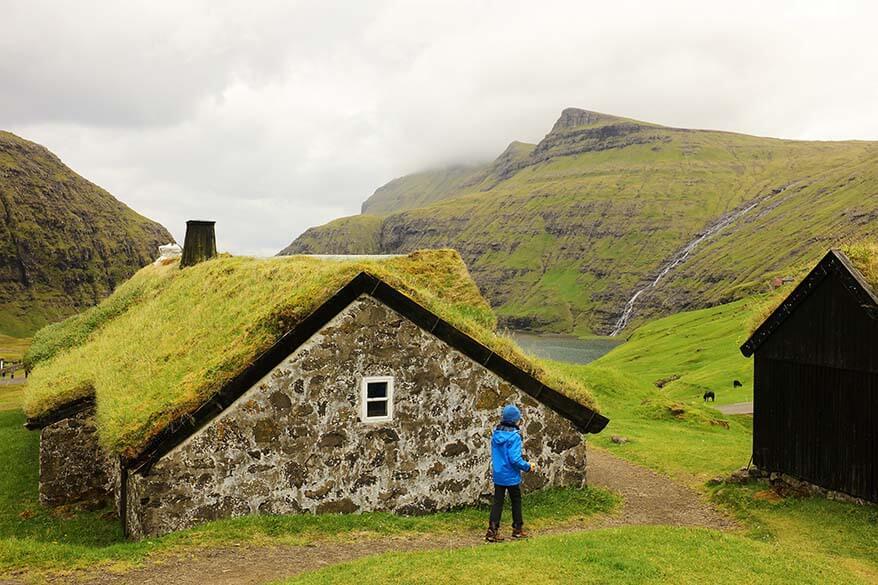
One of the popular hikes of the Faroe Islands, Saksun – Tjornuvik hike starts by the waterfall just behind the turf houses. However, it’s a long hike that involves a serious climb and will take at least 2-3 hours one way, so if you are planning to do it, start early and count the whole day for just this area.
Alternatively, make a shorter walk along the Western side of the river (you can read all about this hike in our Faroe hiking guide – hike no. 5 ) and drive to Tjornuvik by car.
Practical information: Saksun has some minimal facilities – a bathroom, a cafe that is open for a few hours in the afternoon, and a kiosk selling some small snacks (it’s located at the first parking area, not by the church where all the tourists come – go figure).
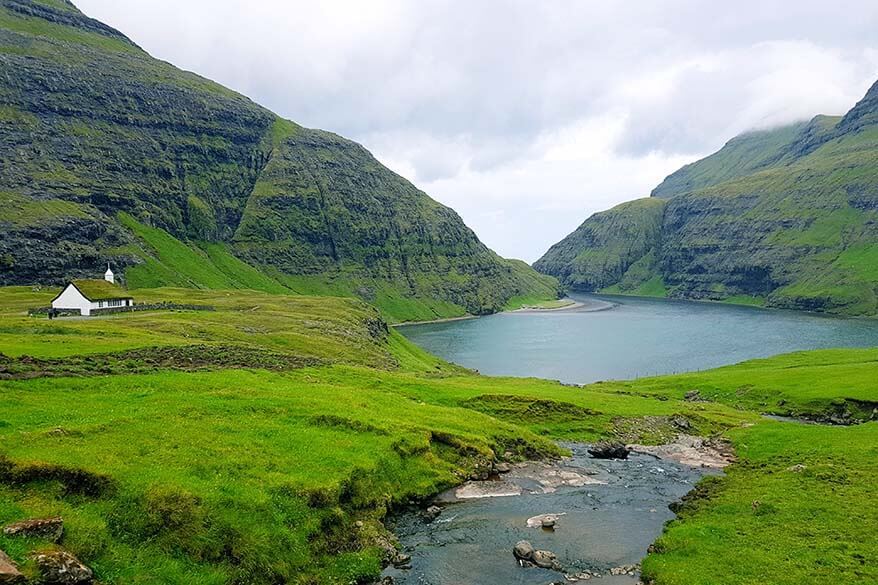
Fossa Waterfall
On the way to Tjornuvik, just before Haldarsvik, you will pass the highest waterfall of the Faroe Islands, Fossa . The 140m waterfall tumbles down over two levels and looks very impressive in the pictures.
However, in reality, it’s so close to the road that you can’t truly appreciate its beauty unless you own a drone. Anyway, it’s just a short stop that doesn’t require any effort, so don’t miss it.
The waterfall is even more impressive if you come here when it rains. Actually, it’s amazing to see how much and how quickly the waterfalls change when it starts to rain in the Faroe Islands.
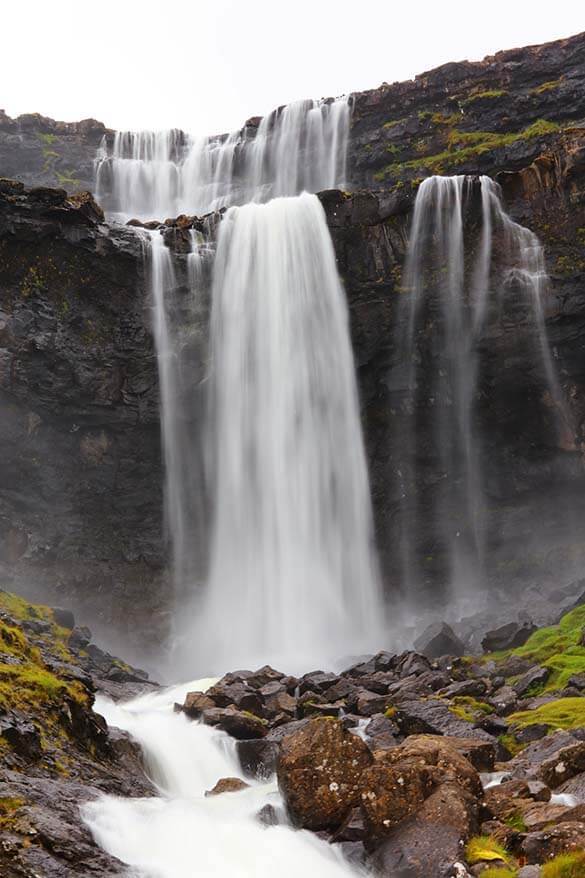
Tjørnuvík
The road to Tjornuvik is extremely narrow, but it’s really scenic, so you don’t want to drive fast here anyway.
The moment you turn the last corner, the picturesque little village appears in front of you – it’s a sight to behold!
There are many places in the Faroe Islands where you feel like you’ve reached the end of the world, Tjornuvik is one of them.
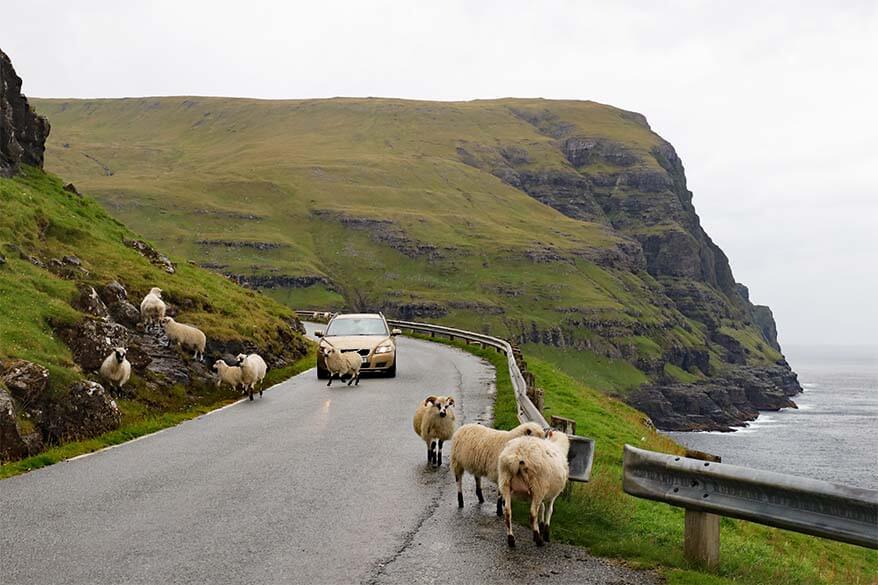
Tjornuvik is a somewhat bigger village than Saksun, and we were glad to see that there were more locals here than tourists (according to Wikipedia, there were 64 people living here 15 years ago, no idea how many people live there today).
The village has a beautiful beach that is supposedly a paradise for surfers. We didn’t see any surfers here but loved the peaceful beach overlooking two beautiful rocks along the coast of the nearby Eysturoy island.
The rocks are known as Risin and Kellingin , a giant and a witch. According to a local legend, they tried to drag the Faroe Islands to their home in Iceland, but the job appeared more demanding than they anticipated. While these night creatures were working hard, the sun came up and turned them to stone.
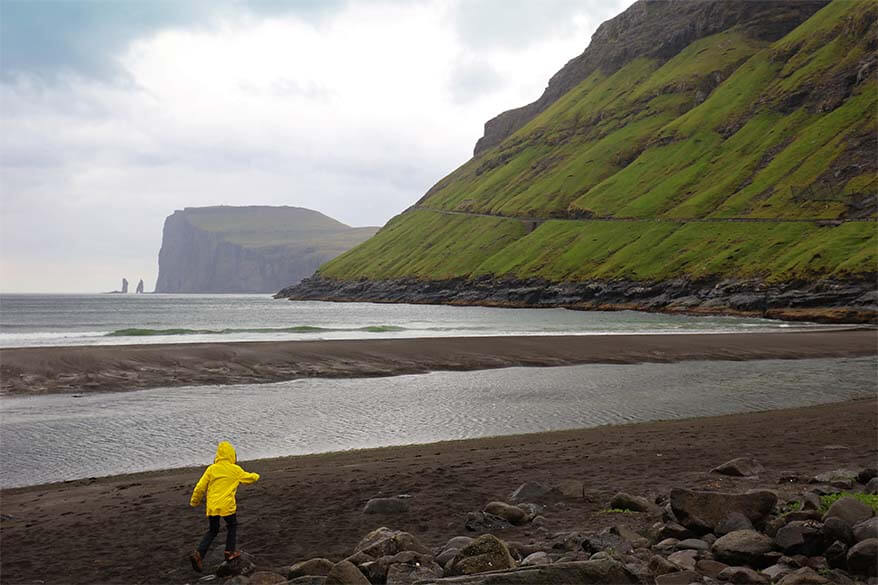
Practical information: Tjornuvik village itself is quaint and picturesque, but there is no tourist infrastructure here at all. The only restaurant in town has been permanently closed a week before our visit. Looking for a place to hide from the rain, we followed a sign for coffee and waffles and ended up in front of yet another closed door. The neighbors told us that the owner’s granddaughter was getting married that day.
The reason I mention this is so that you know what to expect when traveling around in the Faroe Islands. Adjust your expectations, travel well prepared, and you’ll have a wonderful time.
But if you forget to pack a picnic thinking that you’ll find something in these quaint little villages, keep in mind that the nearest cafe might be an hour’s drive away.
Vestmanna Bird Cliffs
Vestmanna bird cliffs is the most popular day trip on the Faroe Islands and takes you to the steep rocky coastline where thousands of birds nest in season. If the sea is calm, this is a great tour, and a possibility to see puffins.
Vestmanna boat trip only runs in high season, April to September, and usually just 2 or 3 times a day. In summer months, the boats are usually full, but even in the shoulder season, this is one of the most popular excursions that quickly sells out. So if you want to see the bird cliffs of Vestmanna, you have to book the boat in advance .
For the rest, there isn’t that much to do in Vestmanna, unless visit the Saga Museum, buy some souvenirs at the visitors center, or meet some of the cutest sheep of the Faroes…
Accommodation: Stay in Torshavn for the first 4 nights of this itinerary. We stayed at Hotel Føroyar , one of the best hotels on the Faroe Islands at the moment. Here you can find our complete updated guide to the Faroe Islands hotels .
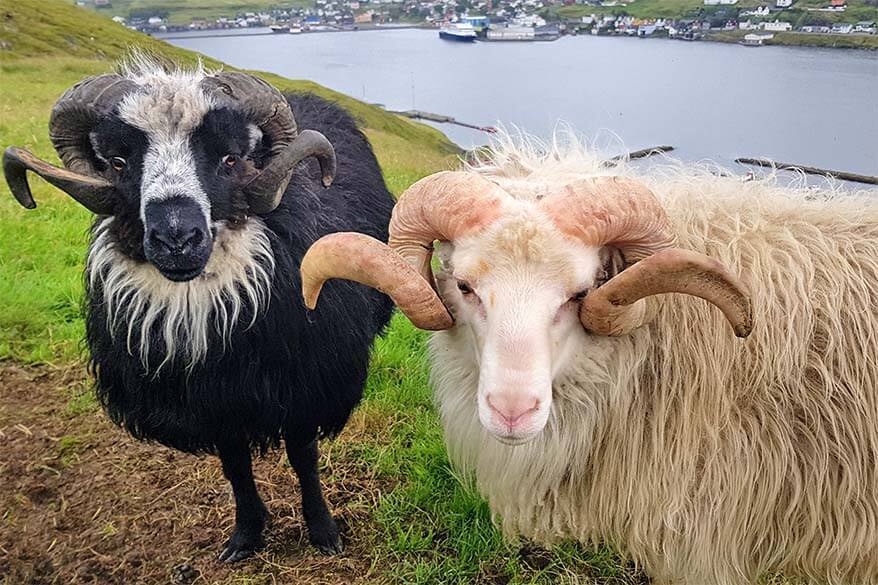
Day 2: Streymoy Island: RIB62 Tour to Hestur Island, Kirkjubøur, Torshavn
Our second day on the Faroe islands was the proof that you shouldn’t let the weather influence your travel plans. It was pouring the whole morning and we were reluctant to even leave our hotel.
While it kept raining pretty much the whole time in Torshavn, the weather was very different in other places. One moment we were driving in complete mist, and then just a mile further down the road we would find open blue skies and sunshine…
We’ve been to many places where the weather is known to be unpredictable, but we have never experienced such instant fluctuations as in the Faroe Islands.
Before the trip, I often asked myself what to do in the Faroe Islands when it rains . My best advice to you is to pack a good rain jacket and just do what you have planned. Alternatively, just drive till you find better weather; it can be surprisingly close by. Or visit the city – you’ll have it all to yourself.

RIB62 Tour to Hestur Island
One of the absolute highlights of our time in the Faroe Islands was a RIB62 speedboat tour to see the bird cliffs of Hestur island . I can’t compare the Vestmanna boat trip to the RIB62 speedboat tour, because we only did one. But at least at first view, the two tours seem to be quite similar in terms of what you get to see (even though the location is different).
There are several reasons why we chose the RIB62 tour. First, our kids love speedboat tours and none of us ever got seasick on them (as opposed to bigger boats). Second, a speedboat is small and can access areas inaccessible to bigger boats. And third, we just prefer the less touristy options and more off-the-beaten-path alternatives that are just as good or maybe even better than the most popular options chosen by big groups.
The tour lasts just 1,5 hours, so don’t miss it, even if you don’t have that much time in the Faroes. It’s a unique opportunity to visit the spectacular cliffs along the Hestur coastline, see puffins (in season), and admire some of the most unique landscapes you’ll ever see.

Kirkjubøur
Kirkjubøur , just a short drive or a 2-hr hike from Torshavn, is one of the oldest settlements of the Faroe Islands, dating from the Middle Ages. Kirkjubøur was the bishop’s residence for centuries and you can still see the ruins of the old cathedral, Muren, which was one of the finest churches of the Nordic countries back in the 14th-15th centuries.
What still stands is St Olav’s Church, built in 1111, and the King’s farmhouse (the oldest inhabited house in Europe); both can be visited. The church is actually still in use and has services on the first Sunday of the month.
Apart from admiring picturesque Faroes turf houses, you can also make a short walk along the coastline. Even in the rain, it’s a very enjoyable short visit.
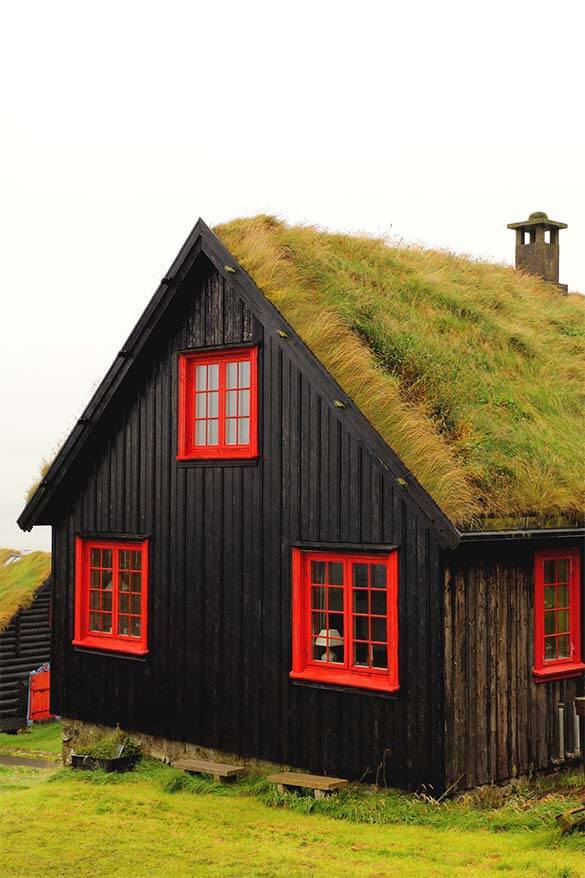
Tórshavn
End your day in Torshavn , the capital city of the Faroe Islands. Not to be missed is the oldest part of town called Reyn with narrow passages and a few turf houses. Don’t expect much of it though – it’s really just a few houses. The main landmark of Torshavn is the historic Tinganes area – one of the world’s oldest courts dating from the 9th century.
The Torshavn city center is rather small and compact, so you don’t need a lot of time to see it all. Other places of interest include the Skansin area by the harbor and the Torshavn Cathedral . It might not look like much from the outside, but you really have to see its wooden interior!
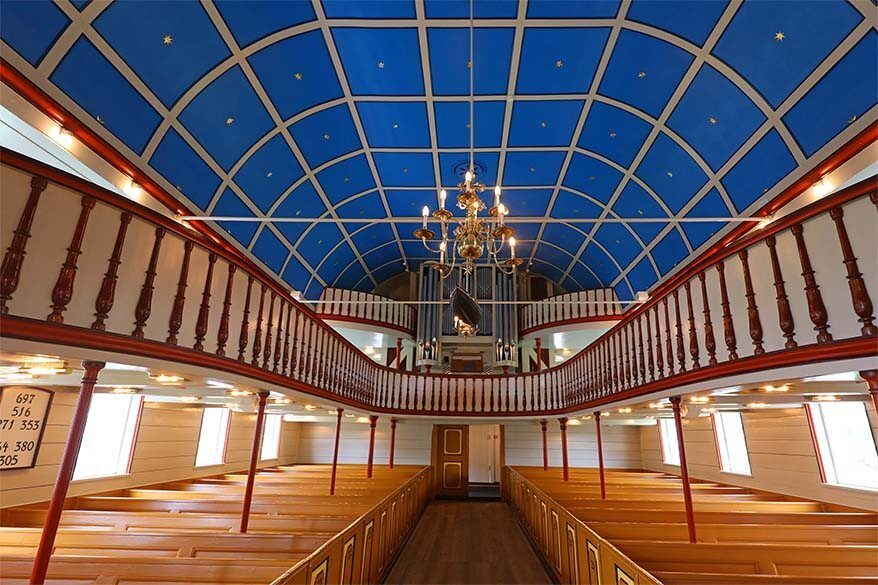
One of the liveliest locations in town is the little Vagsbotnur harbor with quaint colorful buildings and several cafes, pubs, and restaurants. This is probably the best place in the whole of the Faroe Islands for food, drinks, and a lively atmosphere. A great way to end your day.

Day 3: Nolsoy Island
Nolsoy Island , just off the coast from Streymoy Island, can be reached by ferry from Torshavn. The ferry ride takes just 20 minutes, but ferries run just a few times a day, so keep that in mind when planning your itinerary.
The island has just one tiny village, so you don’t need a car to visit Nolsoy. Leave the car at the hotel, or, if it’s too far to walk to the ferry, at the free car parking lot behind the ferry and bus terminals. The other car parking areas near the harbor have strict time limits, which you’ll probably not be able to adhere to when visiting Nolsoy.
If the weather is extraordinarily beautiful, you can hike all the way to Nolsoy Lighthouse. It’s a 5-6 hour walk (13-14 km total), so keep the ferry schedule in mind if you decide to go all the way to the end. Alternatively, do just the first part of the hike – the climb is steep, but the views are really nice.
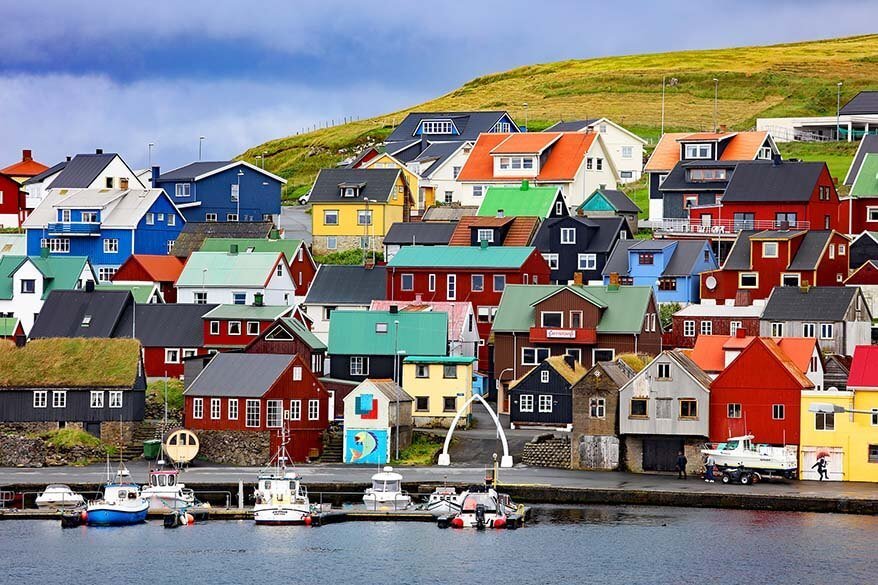
Nolsoy village itself is really picturesque, but apart from a short stroll between the colorful houses, there is not that much to do here for day visitors.
There is a tiny visitor center on Nolsoy Island. They can arrange a guided tour of the village, or some coffee and waffles. For guided tours, it’s best to call them in advance.
TIP: If you take an early ferry back to Torshavn, you could opt to do a horse riding tour close to town . You have to book it in advance, as people in the Faroe Islands don’t seem to like last-minute bookings, even if the tours aren’t full.
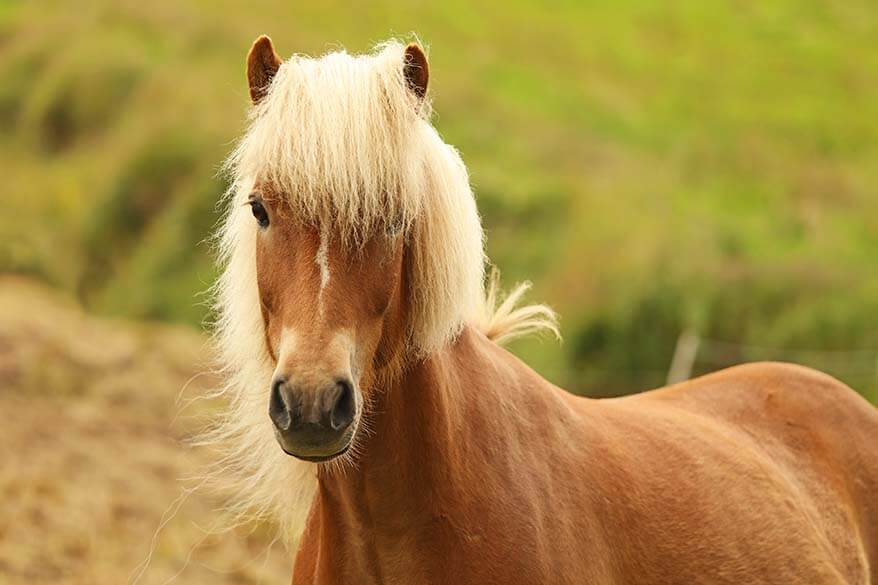
Day 4: Viðoy and Borðoy Islands
Time to explore the Northern islands of the Faroes! The furthest island that you can easily reach by car is Vidoy, about 1,5 hrs drive from Torshavn.
You could do it as a day trip, but I recommend staying in Klaksvik for one night and visiting Kalsoy Island the next day as well.
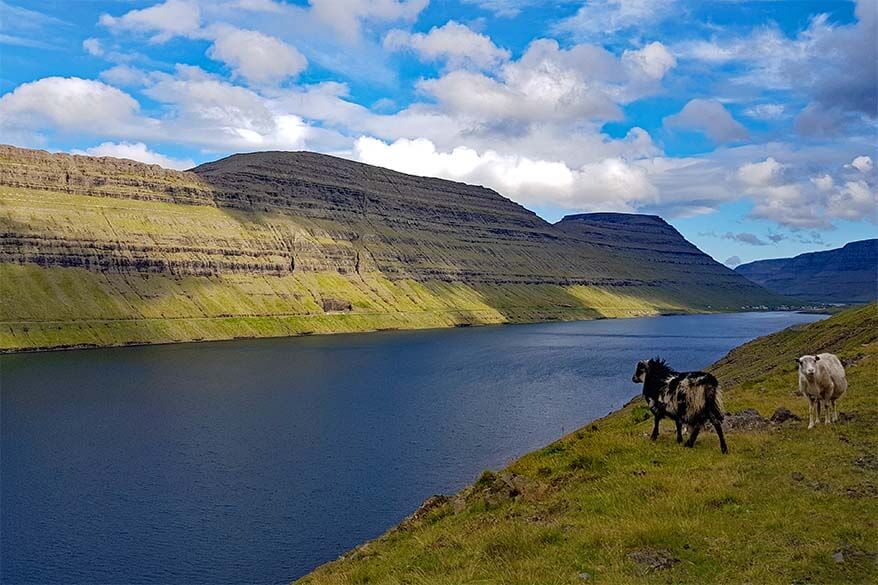
Viðoy Island – Villingardalsfjall/ Enniberg Hike
Villingardalsfjall hike on Viðoy island is probably the most spectacular hike of the Faroe Islands. From the trail, you have phenomenal views over all the Northern islands such as Fugloy, Svinoy, Bordoy, Kunoy, and Kalsoy. Not to be missed!
Practical information: This hike will take you a good part of the day (more information in our Faroe hiking guide – hike no.1 ), so make sure to pack a picnic.
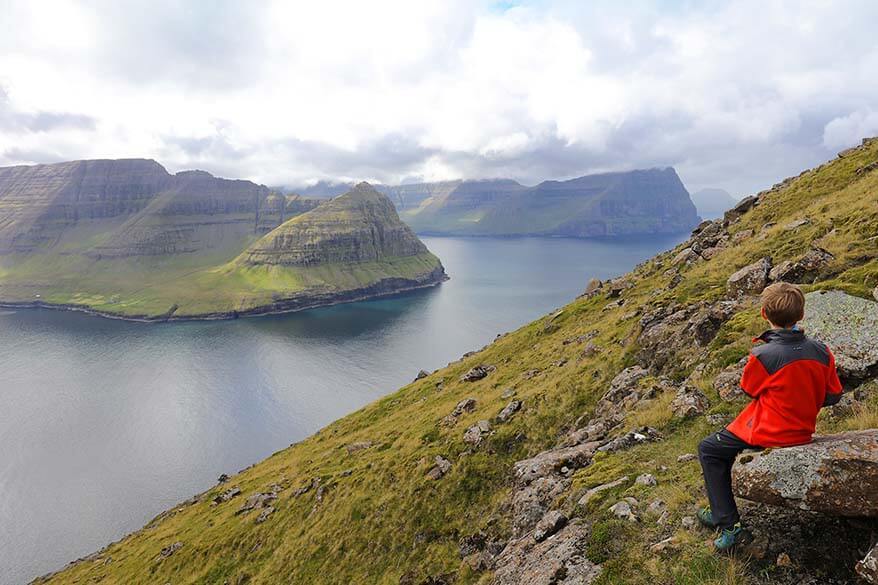
Borðoy Island – Muli and Klaksvik
There is just one road going through Bordoy island and if you drive all the way to the end of it, you reach a tiny village called Muli. The road is really scenic, so it’s a nice little detour.
Muli village itself is not more than a few houses dating from the early 19th century. The sign at the village says that it has been abandoned in 1992, so I guess the people that we met there were using them as vacation houses.
You can make a few very short walks here. One of them leads to the gorge, the other one to a sheepfold along the coast, where you have a nice view over the coastline.
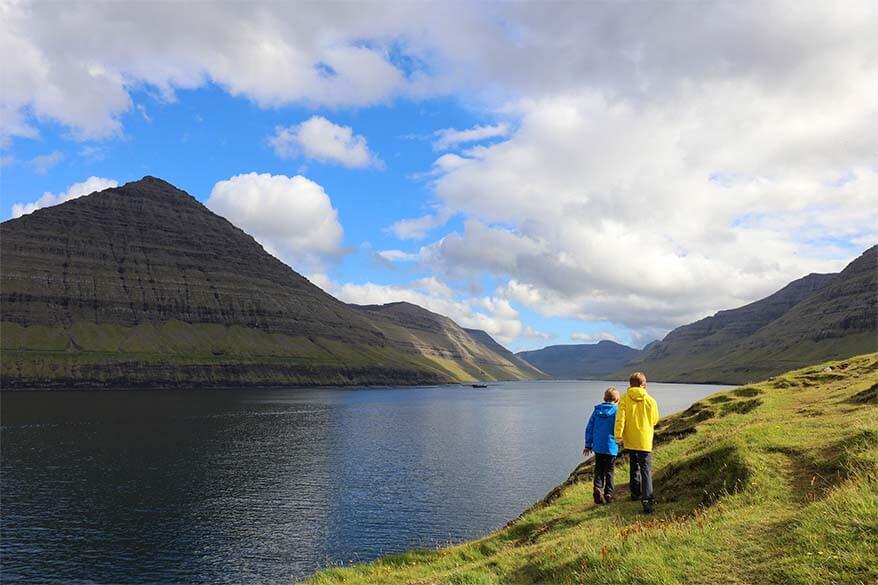
Klaksvik, the fishing capital of the Faroes, is the biggest town of the Northern islands. In addition to its famous brewery, it also has all the facilities that you may need, including shops, restaurants, and also a few accommodations. It’s the best place to stay for exploring the Northern Islands.
Accommodation: Stay in Klaksvik for 1 night. Accommodation here is very limited. We stayed at Eysturland Lodge .
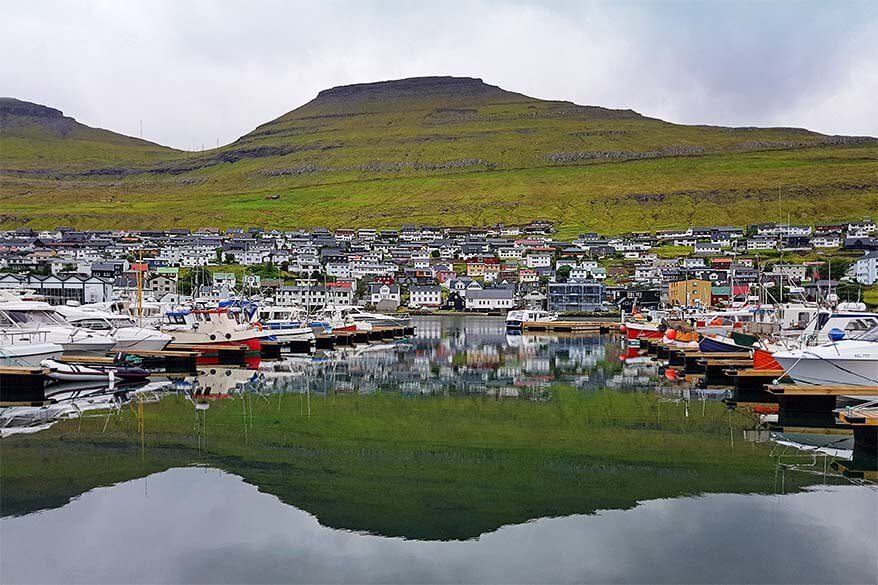
Day 5: Kalsoy Island
Kalsoy Island is not connected to the other islands and the best way to get there is by taking a car ferry from Klaksvik. Keep in mind that the ferry is tiny (it can squeeze 17 small cars at best). Furthermore, it only runs a few times a day.
In high season you really have to arrive at least an hour in advance (that’s why it’s best to stay in Klaksvik and not drive from Torshavn). We arrived about 50 minutes in advance and were the 16th car in the queue and so you can imagine our relief when we could board. The next ferry was 6 hours later…
Update: Recently, I saw that it was possible to prebook a spot on the ferry in advance. So be sure to check the official website of Faroe Islands ferries and if it’s possible, definitely book in advance!
Kallur Lighthouse
The main reason to come to Kalsoy Island is the spectacular scenery on the island’s most northerly point, Kallurin.
It requires some hiking to get to Kallur Lighthouse , but apart from the fact that it’s muddy and slippery, it’s not a very demanding hike (more info in our best hikes of the Faroe guide – hike no.2 ). The views here are rewarding and well worth all the effort that it takes to get here.
Good to know: There is now a fee that you’ll have to pay in order to hike to the lighthouse. More and more landowners in the Faroe Islands are now charging tourists for hiking through their land.
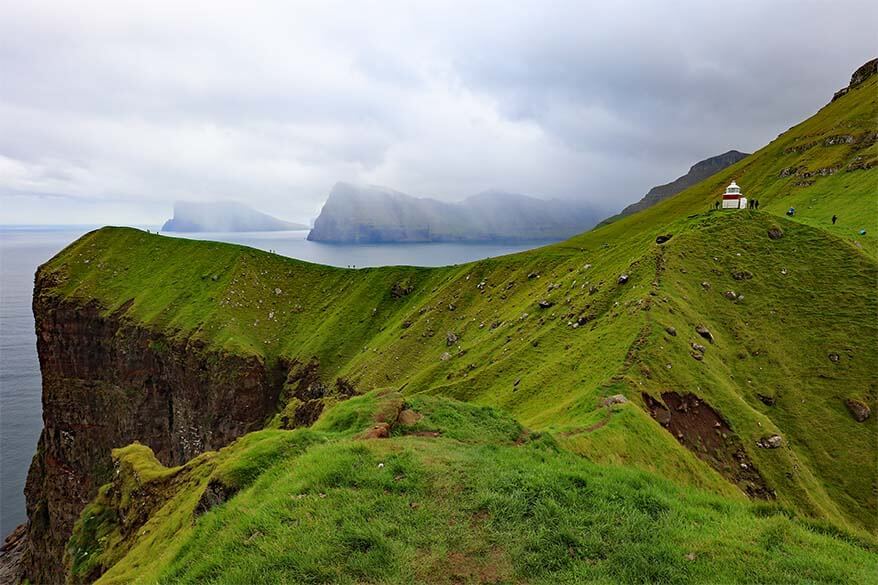
Mikladalur – Kópakonan
One more highlight you shouldn’t miss on Kalsoy island is the statue of a Seal Woman (Kópakonan) in Mikladalur village. The coastline here is stunning too.
My advice is not to linger on the island longer than necessary and get back to the harbor well in time for the ferry. It was so busy on the day we visited that despite arriving more than an hour before the ferry, we ended up waiting for the next one. Hours wasted sitting in the car… Luckily, we had some snacks and our e-readers.
TIP: Probably a better way to visit Kalsoy would be to leave your car in Klaksvik, take a ferry as a foot passenger, and then a small local bus that seems to follow the schedule of the boat. From what I understand, this bus drives all the way to Trollanes where the hike to Kallur Lighthouse starts. I’m not sure what happens if there are no places on this minivan, and I don’t know if it makes any other stops, like Mikladalur. But it’s definitely worth inquiring about this option at the visitor’s center.
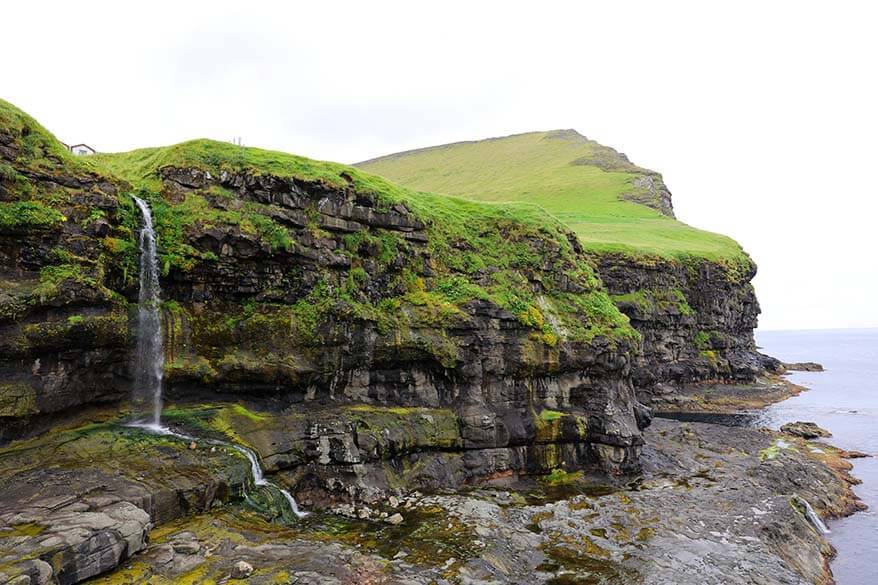
Depending on how much time you have on this day, you might be able to drive some of the scenic roads described in the itinerary on the next day. We spent so much time waiting for the ferry that we ran out of time and therefore drove straight to our accommodation in Gjogv.
Accommodation: You could either stay in Klaksvik one more night or drive to your next destination. We stayed in Gjaargardur Guesthouse in Gjogv – one of my favorite accommodations of this trip.
Day 6: Eysturoy Island: Gjogv, Slættaratindur, Oyndarfjørður, Elduvik
Gjogv is one of the places you shouldn’t miss in the Faroe Islands. It’s such a quaint little village in a beautiful setting.
There are hiking trails available here. As a minimum take a very short walk to and a bit around the gorge, it’s such wonderful scenery. In season, you’ll see puffins here, but they are usually quite far away.
TIP: If you’re in Gjogv around lunchtime, try some pancakes at the Gjaargaardur Guesthouse.

If you drive to Eiði from Gjogv, you’ll pass some of the highest roads of the Faroes. No wonder that this area is often covered in clouds, and it was also the case when we visited. If the weather is nice, you can hike to the top of Slættaratindur , the highest mountain of the Faroe Islands.
Eiði village itself isn’t really that interesting from a tourist point of view. We thought we might be able to see the beautiful rock formations Risin and Kellingin that are just off the coast near Eidi, but you can’t really get close to them or even see them from the village. They are best visible from Tjornuvik on Streymoy Island.
The nicest places on Eysturoy island, we found, are the roads leading to Gjogv, Elduvik, and Oyndarfjordur , so I suggest you drive them all. These scenic drives are not about the destination, but rather about the roads themselves. One exception – Elduvik village is actually quite scenic and worth a short visit.

In the afternoon we drove back to Torshavn where we took a ferry to Suduroy island (see the schedule here ). It’s a big car ferry and we were told that it’s never full. But just in case… we arrived well in advance, parked the car in line at the ferry terminal, and went for a short walk in the city.
Accommodation: We stayed 2 nights on Suduroy island . The accommodation we stayed at is not available at the moment and other options are extremely limited. So you’d have to see if there’s anything available on the private rental market if you plan to visit this island…
Day 7: Suðuroy Island
One of the best things to do on Suduroy Island is Hvannhagi hike near Tvøroyri. It’s a rather long hike, but one that gives you a true feeling of remoteness. The landscape around Hvannhagi is so special!
Don’t miss Akraberg Lighthouse , the southernmost point of the Faroe Islands. Just be careful here – the whole area is surrounded by steep cliffs with a sheer drop to the ocean deep below.
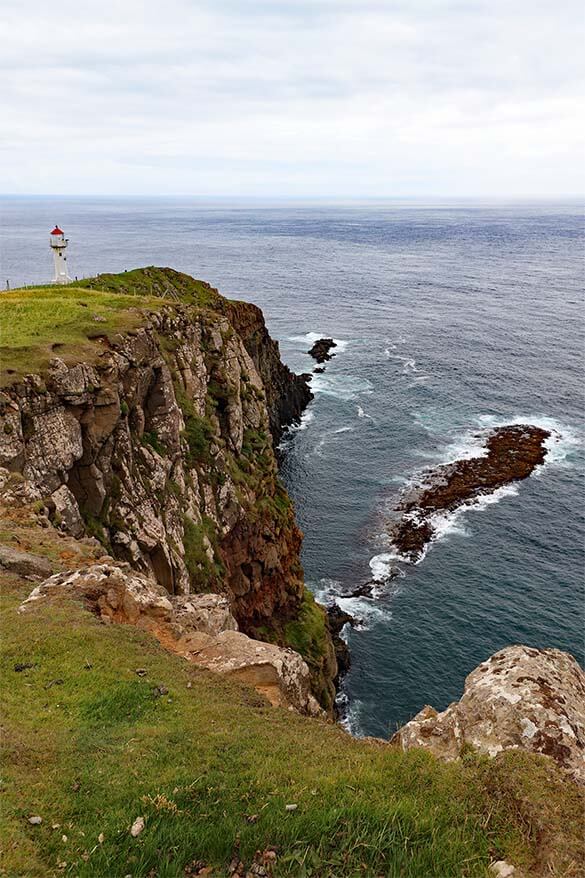
The area around Hvalba and also around Sandvik is really nice to see too.
One of the hidden gems of the Faroe Islands can be found near Sandvík. It’s a tiny nameless wooden bridge over a nameless gorge with incredible views. It’s not easy to find, but if you do – it’s definitely worth it!
Drive the bumpy road Heiðavegur in Sandvik all the way to the end. There is a fence on this road, but the locals told us that it’s ok to drive through it (don’t forget to close it, otherwise the sheep might run away). At the very end of the road, you can leave the car and climb the hill following white poles with a rope, then turn right where the poles end. Continue towards the ocean for 10-15min and you’ll find the little bridge.
TIP: The western coastline near Sandvik is the best place to be at sunset. Follow the Heiðavegur road as described above, but instead of driving all the way to the end, stop where the road is closest to the ocean. From there you can walk just a few steps for the most amazing views.
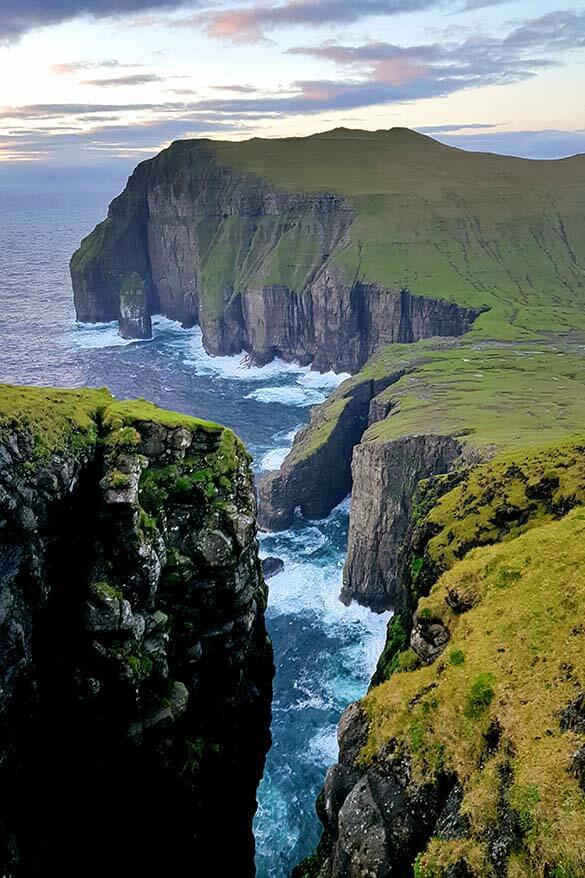
Alternative suggestion: Visit Sandvik and this beautiful sunset spot the evening when you arrive in Suduroy (day 6 of this itinerary). Stay just one night on Suduroy and head back to Torshavn in the evening. Don’t forget to check the ferry timetable. This will give you more time to explore Vagar island the next day.
Day 8: Vagar Island: Trælanípa Hike, Gasadalur, Mulafossur, Trøllkonufingur, The Nix
In the morning we took a ferry back to Torshavn and drove straight to Vagar island . We left this island for the very end of our trip, because it’s close to the airport. Also, there is a toll for driving the tunnel between Vagar and Streymoy, so it’s best not to drive through it too many times if not necessary.
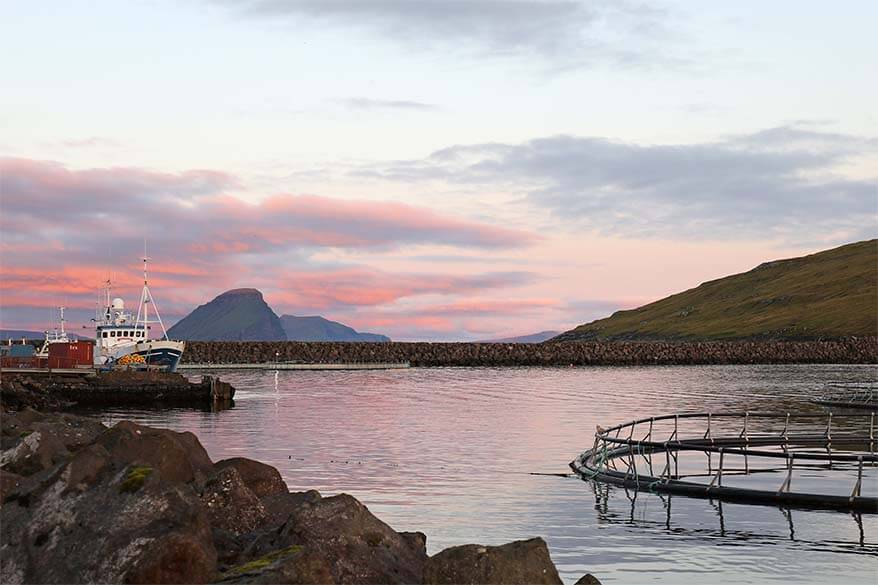
Trælanípa Hike
The hike from Miðvágur to Bøsdalafossur waterfall and Trælanípa mountain is one of the most beautiful and by far the most popular hike in the Faroe Islands. You can read all about it in our Faroe hiking guide, hike no.3 .
TIP: It’s best to come here late in the afternoon if you can – the light for photography is best at sunset and there will be fewer people.
Good to know: There is now a 200 DKK hiking fee that you have to pay (cash) in order to access this area.
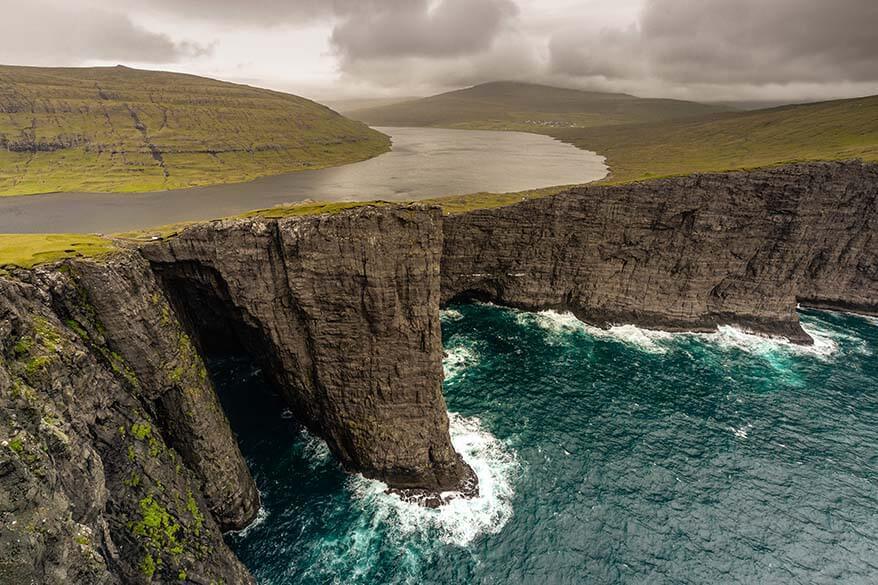
Trøllkonufingur
Trøllkonufingur – the Troll woman’s finger – is a big rock along the coast of Vagar island near Sandavágur. There is a sign to a viewpoint, so you can’t really miss it. It’s also well visible from the road at the trailhead of Trælanípa hike.

Gásadalur and Múlafossur
Gasadalur is a tiny village, just like many others on the Faroe Islands, stuck between the mountains on one side and steep cliffs and the ocean on the other. In the past you could only get there by boat, on foot, or by helicopter; now there is a tunnel connecting Gasadalur to the rest of Vagar island.
The main reason to visit is to see the beautiful waterfall Mulafossur , probably the most photographed waterfall of the Faroe Islands. Don’t miss it – the coastline here will take your breath away!
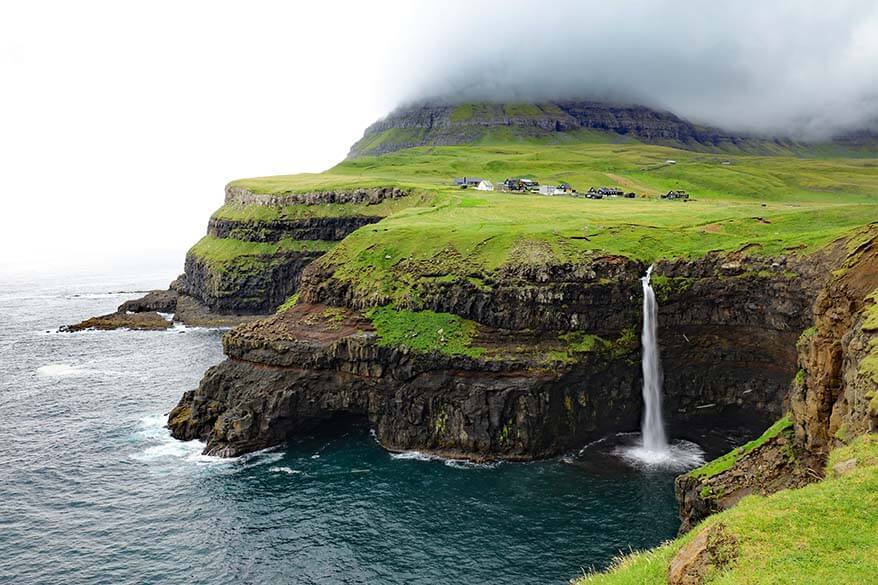
The Nix in Sørvágsvatn or Leitisvatn
On the way to the airport, you’ll notice an interesting piece of art – a horse in the middle of the lake Sørvágsvatn/ Leitisvatn. It’s called Nix and is a mythical water creature that wants to lure people into its underwater world.
There are several stories and legends surrounding Nix and locals could tell you more about it. But the statue is just next to the main road and worth a short stop anyway.
Accommodation: We stayed on Vagar island for the last two nights. It’s close to the airport and also the best location for a day trip to Mykines . There is just one hotel on this island and a few private accommodations. See the accommodation map here .
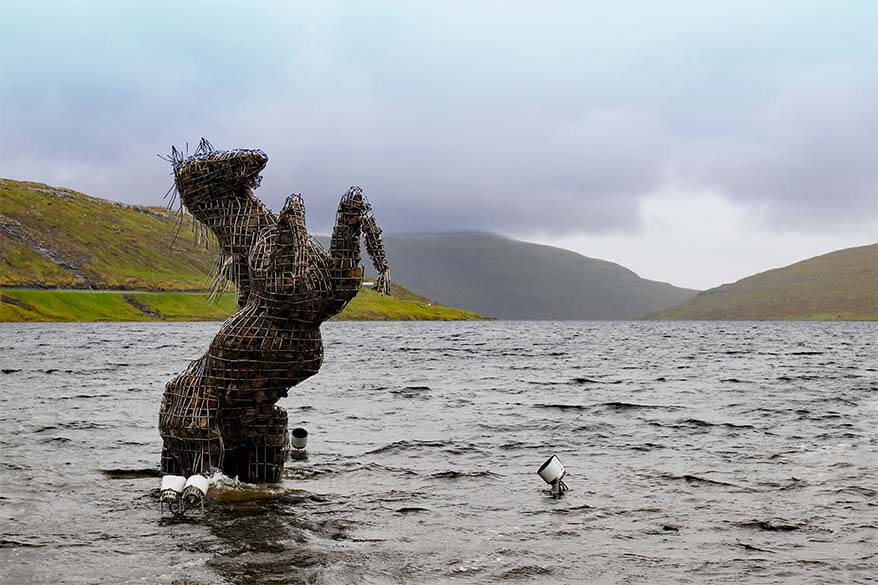
Day 9: Mykines Island
We left the very best for last. Mykines island is one of the most beautiful places of the Faroe Islands and it really should be included in any Faroe Islands itinerary.
We had really bad luck with the weather and visited Mykines in the pouring rain. Nevertheless, it’s one of the most unique and beautiful places I have ever been to. I can’t even imagine what it would look like on a sunny day with blue skies… I’d go all the way back to the Faroe Islands just to explore Mykines in good weather.
As if green hills, charming turf houses, and spectacular scenery are not enough, there is one more reason to visit Mykines Island. Puffins . Mykines is home to thousands and thousands of puffins that come to nest on the island every summer. It must be the best place to see puffins in the world!
One of the nicest things to do is hike Mykinesholmur all the way to Mykines lighthouse. This hike brings you past the puffin colony and has incredible views all the way. Unfortunately, a big part of the hike was closed when we visited (due to the weather and dangerous conditions), but even then it was worth it.
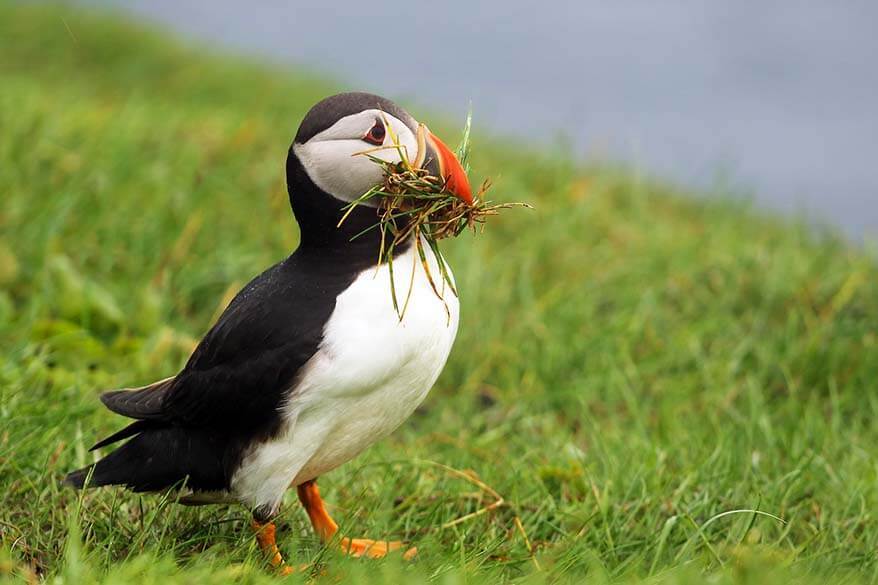
Keep in mind that Mykines is an extremely popular place to visit in the Faroe Islands, and Mykines ferry is also the only one of all official ferries that you can (and have to) book in advance. Nowadays, there is also a shuttle boat to Mykines , which makes it so much easier to visit!
TIP: The easiest way to get to Mykines without having to worry about practicalities is by booking a guided tour to Mykines . Most tours include the ferry, hiking fee, a local guide, and a packed lunch. Just note that some tours start from Sørvágur harbor, but some tours include transportation from Torshavn as well.
There aren’t many accommodations on the island, but it is possible to stay there if you really want to. In that case, inquire at Visit Faroe Islands for more information.
Most people come to Mykines for the day. The ferry schedule is such that it gives you about 5 hours on the island, which is enough if the weather is nice and much too long if it rains.
TIP: You can find more practical information for your visit to Mykines in our Faroe hiking guide – hike no.4 .
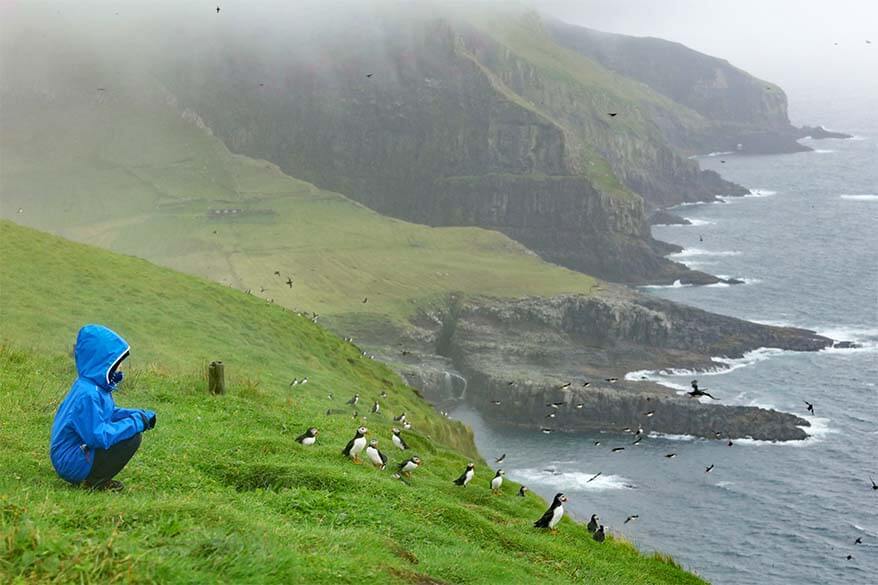
Faroe Islands Itinerary Suggestions
Below you can find some suggested Faroe Islands itineraries for shorter trips, from 3 days up to a week. Read on!
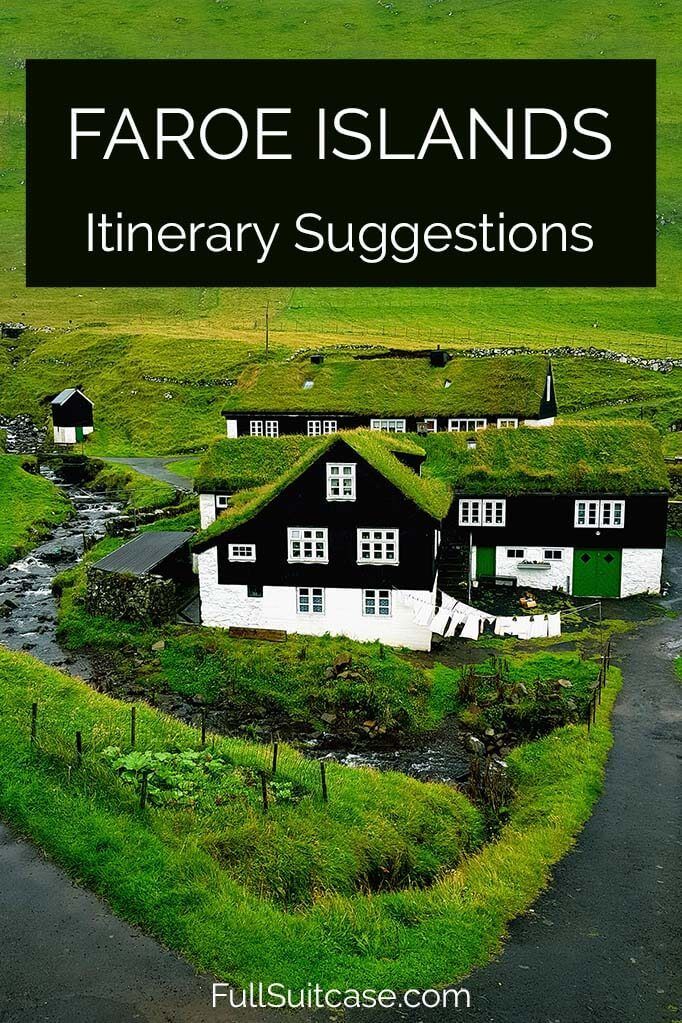
3 Days in the Faroe Islands
- Day 1: Torshavn, Kirkjubour, Saksun, and Tjornuvik.
- Day 2: Boat tour to Vestmanna or Hestur island and Trælanípa hike on Vagar island OR Kalsoy island and Gjogv.
- Day 3: Mykines island. Visit Mulafossur waterfall in the evening.
4 Days in the Faroe Islands
- Day 1: Torshavn, Kirkjubour, Saksun and Tjornuvik.
- Day 2: Kalsoy Island and Gjogv.
- Day 3: Boat tour to Vestmanna or Hestur island and Trælanípa hike on Vagar island.
- Day 4: Mykines island. Visit Mulafossur waterfall in the evening.
Faroe Islands 5 Days Itinerary
- Day 2: Northern islands. Villingardalsfjall hike on Vidoy. Klaksvik.
- Day 3: Kalsoy island and scenic roads on Eysturoy island.
- Day 4: Gjogv, boat tour to Vestmanna or Hestur island and Trælanípa hike on Vagar island.
- Day 5: Mykines island. Visit Mulafossur waterfall in the evening.
TIP: If you have 4-7 days in the Faroe Islands and don’t want to worry about planning the best itinerary, driving, or ferry schedules, consider a multi-day tours package . All you have to do is book a hotel in Torshavn and the local guides will pick you up every morning and drop you off back at your hotel every evening. It’s the most relaxing way to see the best of the Faroe Islands for those who rather take it easy and let someone else do the planning.
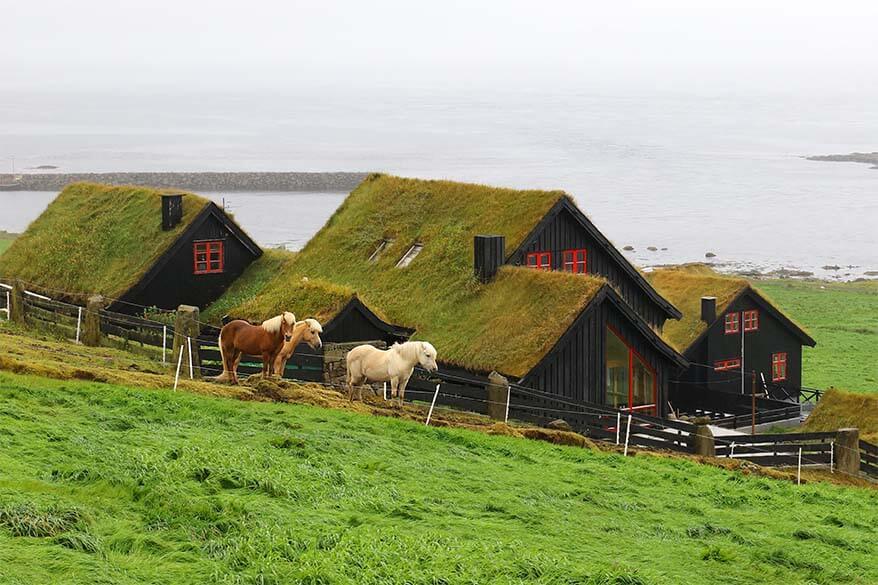
6 Days in the Faroe Islands
- Day 2: Nolsoy Island. Maybe horse riding in Torshavn.
- Day 3: Northern islands. Villingardalsfjall hike on Vidoy. Klaksvik.
- Day 4: Kalsoy Island and scenic roads on Eysturoy Island.
- Day 5: Gjogv, boat tour to Vestmanna or Hestur island and Trælanípa hike on Vagar island.
- Day 6: Mykines island. Visit Mulafossur Waterfall in the evening.
TIP: If you have at least 6 days in the Faroe Islands and don’t want to worry about planning the best itinerary for your trip, consider this 6-day small group Faroe Islands tour package . They pick you up from your hotel in Torshavn every day and take you to a different part of the Faroe Islands each day. It’s a great way to see the best of the Faroe Islands without planning or worries.
One Week in the Faroe Islands
- Day 3: Day trip to one of the other islands, e.g. Suduroy if the ferry schedule allows it.
- Day 4: Northern islands. Villingardalsfjall hike on Vidoy. Klaksvik.
- Day 5: Kalsoy Island and scenic roads on Eysturoy Island.
- Day 6: Gjogv, boat tour to Vestmanna or Hestur island, and Trælanípa hike on Vagar island.
- Day 7: Mykines island. Visit Mulafossur Waterfall in the evening.
Compare Hotels & Short-Term Rentals in the Faroe Islands
Using the map below, you can compare hotels and short-term rental accommodations in the Faroe Islands . You can zoom in and out for various islands.
Simply insert your travel dates and group size, and you’ll see the best deals for your stay. Check it out!
So, this is our Faroe Islands itinerary and suggestions for a shorter vacation. I realize that planning a self-drive trip to the Faroe Islands can look really overwhelming at first, so if you have any questions, please also check our practical guide to the Faroe Islands .
If you still don’t find an answer, don’t hesitate to leave a reply below and I’ll try to help.
READ ALSO: Faroe Islands Hotels & Tips for Where to Stay
If you found this post helpful, don’t forget to bookmark it and share it with your friends. Are you on Pinterest? Pin this image!
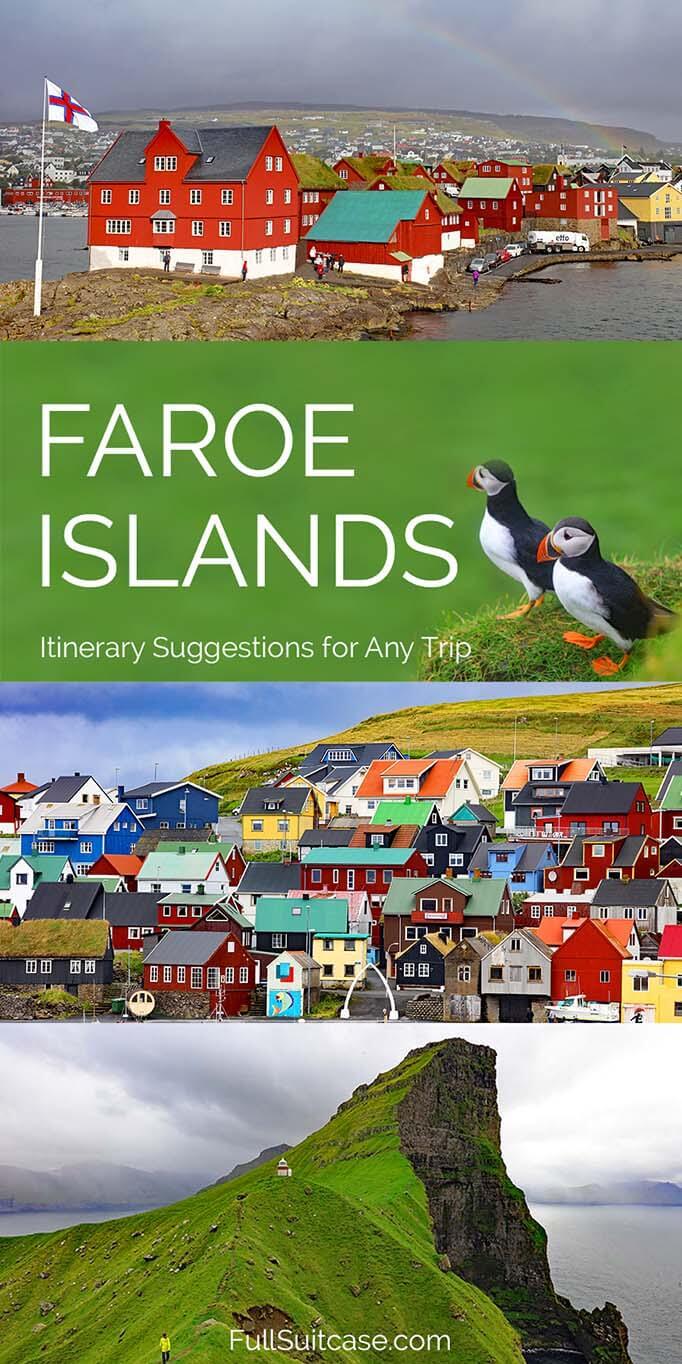
This site uses Akismet to reduce spam. Learn how your comment data is processed .
Thursday 16th of May 2024
Hi, Thanks so much for the detailed blog, very helpful! we are planning to stay in the Faroe Islands for 6 days, of which 2 travel days, so only 4 full days. do you recommend staying in the same place each night (and if yes; where?) or would it be best to change locations every night?
Kind regards, Isabelle
Hi Isabelle, staying in Torshavn is probably best for such a short trip. If you are booking for this summer you may not even have many other options anymore. For more information please read this guide: where to stay in Faroe Islands.
Saturday 20th of May 2023
Hi there! Just passing through to thank you for all the content! Just finished my trip to the Faroe and your posts helped a lot :)
Monday 22nd of May 2023
Glad to hear that, Leticia. Happy travels!
Thursday 29th of September 2022
Thanks for the detailed info! From what you wrote, Sundory Island seems to have more scenic landscape and beautiful view than Nolsoy Island. But on your 6 day itinerary it doesn't have Sundory Island but Nolsoy Island. I am a little confused. We are more into wild landscape than colorful house. Would you please advise? Thanks.
Second, those ferries would run even in raining days and bad weather?
Saturday 1st of October 2022
Hi Camille, Suðuroy island is indeed very beautiful. However, if you look at the map, you'll quickly realize that it's much trickier to get there than e.g. to Nolsoy island which is just next to Torshavn. Depending on the boat schedule, you may need to plan 2 days for Suðuroy and also spend a night there. If you can get a very early ferry there and a late one to get back, it could be done in a day too - it all depends on the ferries and on what you want to see/do. Also, there is not that much accommodation available and if you don't bring your car with you, it's tricky to get around and actually see much. So it requires more planning and more time. And that's the main reason why I wouldn't recommend it if you have less than a week in the Faroe Islands. As for the ferries, it depends on the ferry and on the weather. The biggest ferries usually have no problem unless it's some exceptionally bad storm, whereas smaller ones (like the one to Mykines) could get canceled if the seas are very rough. But definitely not just because of some rain. Hope this helps.
Monday 25th of April 2022
Hi Jurga, your blog on Faroe islands is so detailed and comprehenisve with all the site maps of various places of interest. I don't think I need to read any other Faroe islands guides after seeing your blog. Every thing I need to know can be found right here. By the way, I'll be making the trip with the wife this August, the same time you were there I think. We are a retired couple in our sixties (me 67 and the wife 62) so we don't plan on doing too many hikes. Right now, I don't have any question for you just yet as I'm still going through the blog and will re-read some more time. We plan to spend 5-6 days at Faroe islands but could extend if necessary. Our intenerary will be based on your writing. Thank you very much for the information.
Tuesday 26th of April 2022
Thanks for your kind feedback, Kittiwat. Good luck with the planning and have a great time in the Faroe Islands!
Joanna Mendoza
Thursday 24th of March 2022
Hi!I'm so glad to have come across your blog! I wanted to ask how we go from Torshavn to Nolsoy?This is our itinerary for June and would like to know if this is okay. 1- arrival, Kirkjubour 2- Mykines Day trip 3- Nolsoy Day trip 4- Saksun, Tjornuvik, Gjogv
Thank you. Joanna
Hi Joanna, yes, sure, your itinerary looks good. For Nolsoy, you just take a ferry from Torshavn harbor. It's very simple to get to Nolsoy - you get the ticket on the spot, and it takes just about 30min. Just keep an eye on the ferry schedule so that you don't have to wait too long. You don't need a car on that island; lots of walking. Have a great trip!

The Ultimate 10 Day Faroe Islands Itinerary – With Map
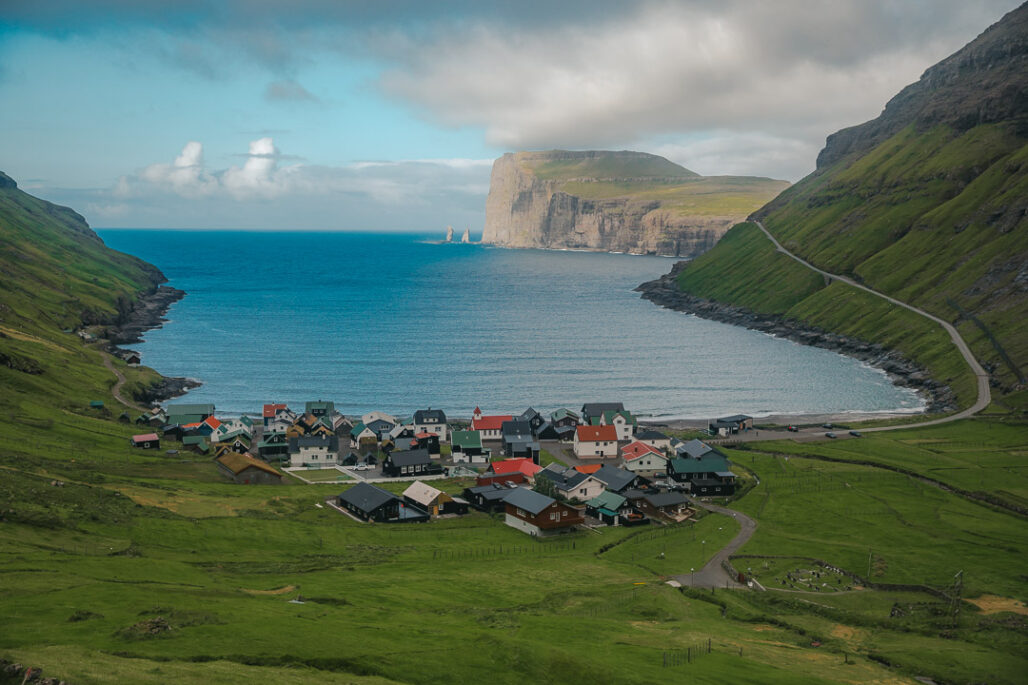
Home > Faroe Islands
Are you planning to visit the Faroe Islands and don’t know where to start planning for your Faroe Islands itinerary? I get it – there are 18 islands, countless beautiful locations and so many tunnels it’s hard to plan a good itinerary on your own. This is why I did all the research for you and comprised it all in the ultimate itinerary for the Faroe Islands!
Faroe Islands itinerary
The Faroe Islands is the perfect destination for nature lovers, hiking enthusiasts, photographers and those on a hunt for unique and unexplored destinations. The Faroe Islands are an autonomous territory of the Kingdom of Denmark and home to just over 53,000 inhabitants, but you’ll definitely meet more sheep than people when you visit the Faroe Islands, which makes sense since the country itself has actually been named after sheep (old Norse Færeyjar, which literally means Sheep Islands) and could very well be called The Sheep Islands.
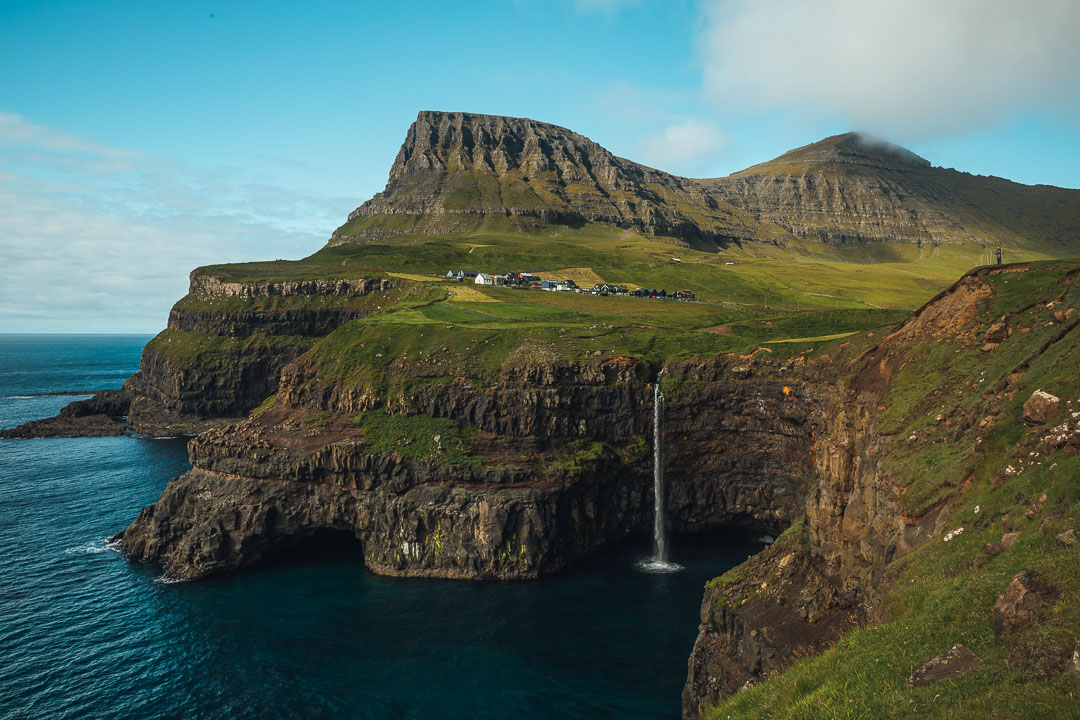
Day 1 – Vagár Island: Arrival and visit Gásadalur
Get a sim card.
After you arrive at the airport, head to the information desk to buy a SIM card. We always buy a local SIM when we travel because we love having access to the map and all saved points of interest. It just makes travel easier if you don’t have to rely on WiFi while you visit Faroe Islands and do your Faroe Islands travel itinerary.
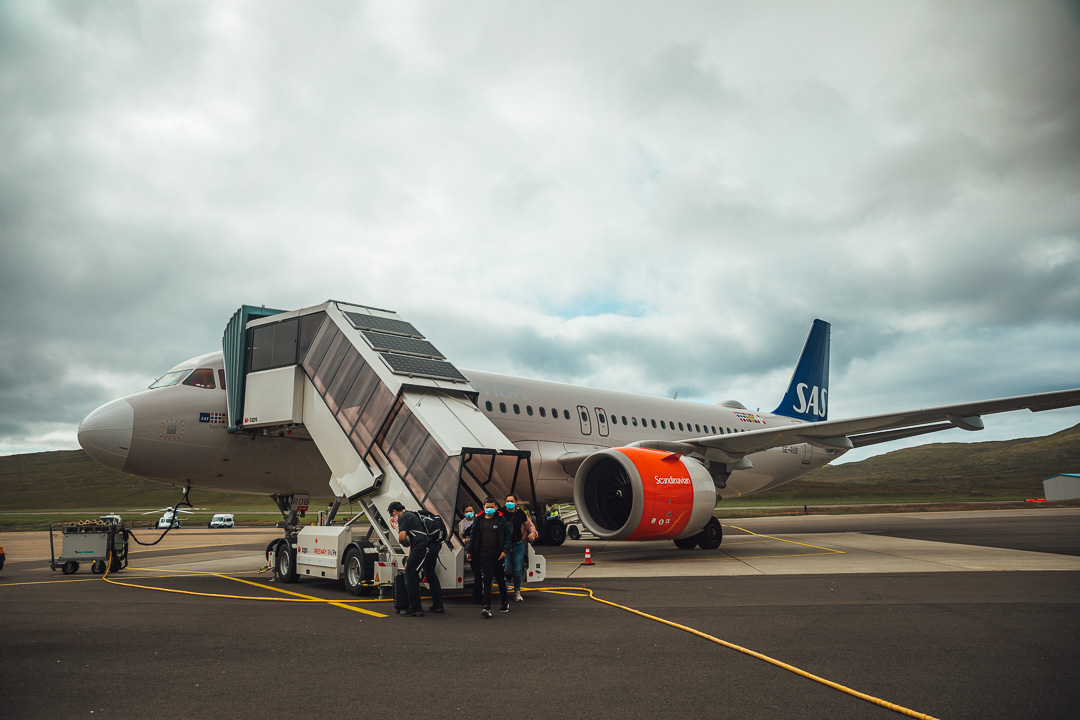
We bought 12GB and it cost us around 230 DKK ($34). You could just opt for a basic one for 100 DKK ($15) though. We usually pop the SIM in Mike’s phone (he has a double slot) and then he shares the hotspot with me. This way we don’t have to buy two SIM cards and can have more data for less.
Car rental in the Faroe Islands
Car rental prices are crazy in the Faroe Islands, there’s no secret about that. We had no idea what awaits us when we booked the (rather cheap) plane tickets, so we were definitely in for a surprise!
Since we also decided to visit the Faroe Islands two weeks before arriving, this also meant a lot of cheaper rental cars were already booked up, which left us with the most expensive choices.
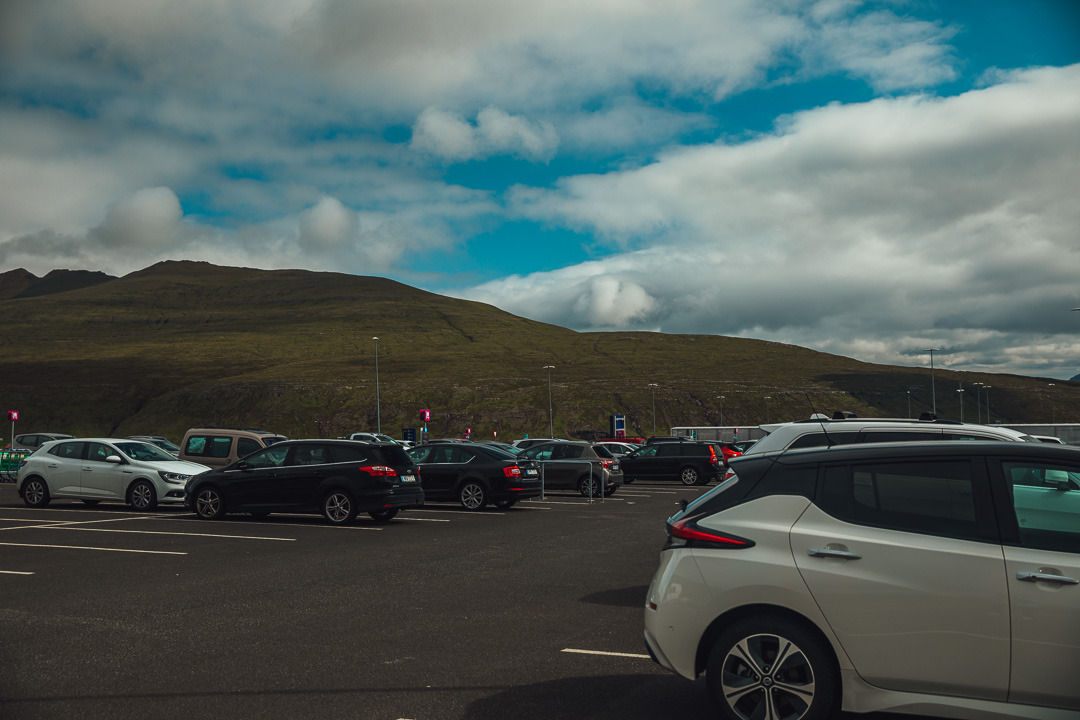
So my best tip is to create your Faroe Islands itinerary and book a car rental early ! As soon as you book your flights, get the car. You will need it every day and I do not recommend you travel around the Faroe Islands without a car. We scoured the internet for a rental place that’s not on Google maps yet since all the bigger websites had prices as high as 1400 DKK ($2000) for 10 days. We finally found a small rental and got an older car for 5000 DKK ($730) for 10 days. The rental price was probably higher than what the car is worth, but we wanted to save money instead of getting a luxury car.
If you’re out early with the booking, you can also check out this car rental page and find a rental for as little as 645 DKK a day.
Drive to Gásadalur – Your base in Vágar
The drive from the Vágar Airport to Gasadalur is only 20 minutes, but do make sure you get something to eat before you head there. There’s a supermarket in Sørvágur, but if you happen to arrive on a Sunday when everything is closed, then head to the gas station and get something to eat there.
We got groceries for breakfast, simple lunch to take hiking and something to cook on the evenings when we are in the Airbnb. There are not a lot of restaurants in Vágar, especially if you’re not so keen on seafood.
In Gásadalur we stayed in one of the very few Airbnb’s in this village and this was our base for two nights while exploring the island Vágar.
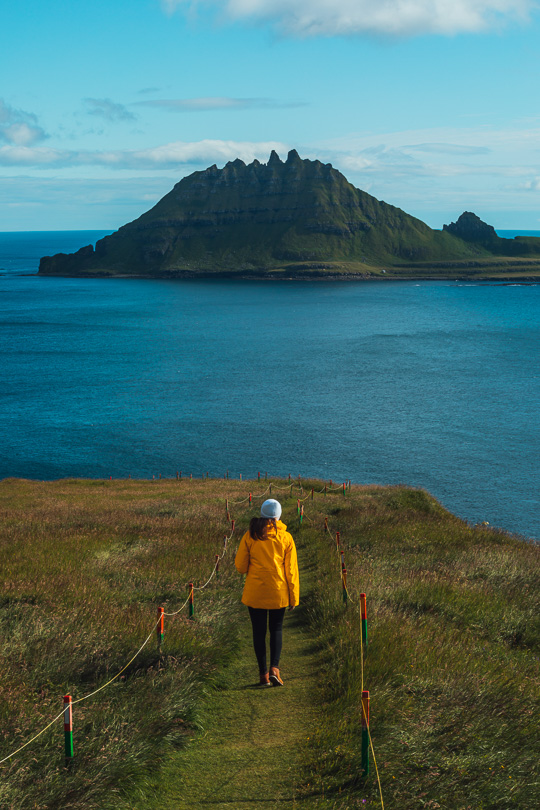
On the first day of this Faroe Islands itinerary, you will stay right next to the famous Mulafossur Waterfall. You can easily photograph it when you arrive, but also during sunset or sunrise. For more tips on what to do in Gásadalur visit this article . Spoiler alert: you can even spot puffins here during summer!
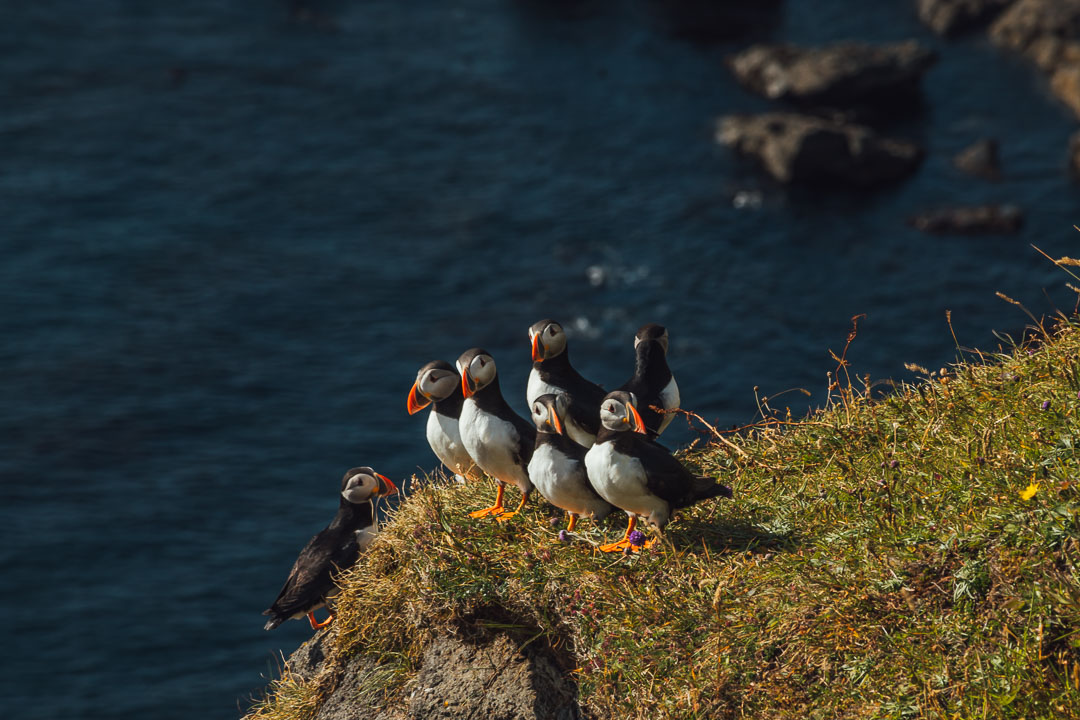
Day 2 – Bøur Village, Trælanípan Lake, Sandavagur Village, Trøllkonufingur and The Nix
After breakfast in your accommodation, you’ll start your journey bright and early and head to Bøur Village. This is just a simple photography stop on your Faroe Islands itinerary, so you’ll need a max of 30 minutes here. Don’t forget to stop by The View cottages as well, the views from there are spectacular!
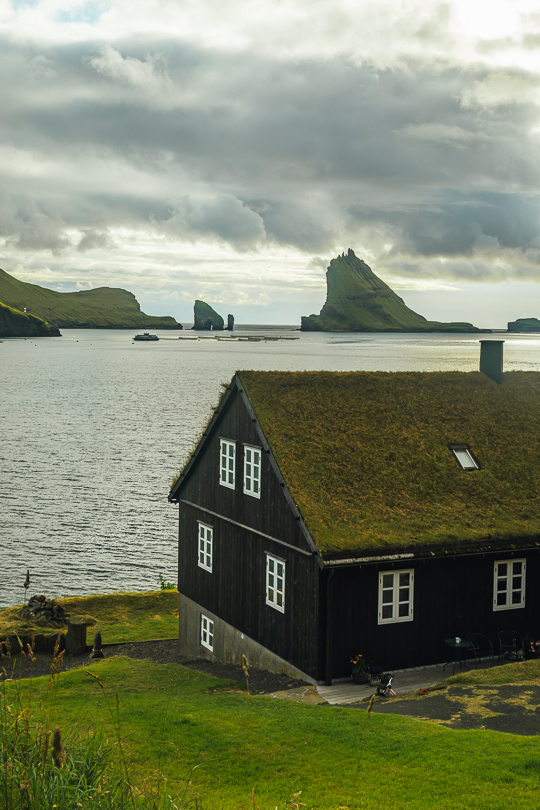
As you walk through and photograph the beautiful views, make sure you are respectful of people’s privacy here and not photograph into the windows.
After the short stop at Bøur village, head towardsTrælanípan for a hike to one of the most beautiful views on this entire Faroe Islands itinerary!
Parking is free, but the entrance for the hike is 200 DKK per person since 2019. The hike to Trælanípan is very easy and even suitable for children so you can’t skip this on your Faroe Islands itinerary! The path is quite flat up until the last bit where there is some uphill. Once you reach the top you will be able to see the lake above the ocean. For best photos bring a wide-angle camera. We also had some coffee with us and had a little fika on the top.
You will need, together with photos, approximately 2,5 hours for the trip to Trælanípan.
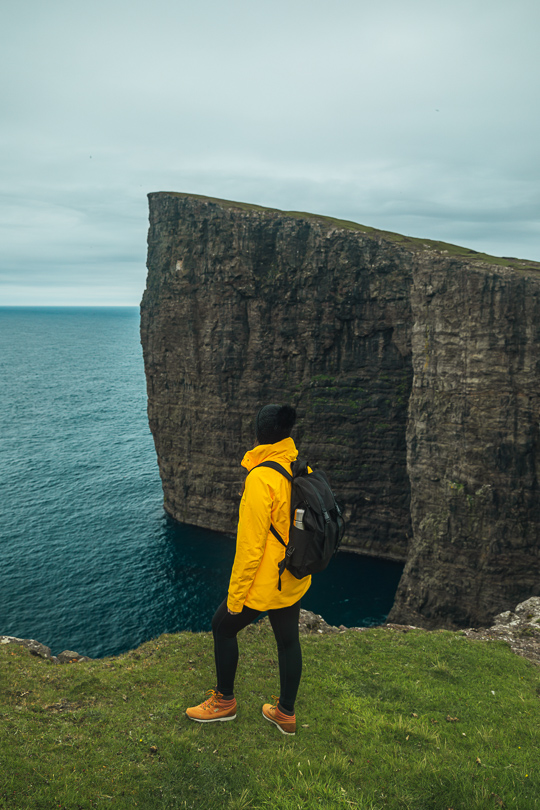
After you are done here, make the drive towards Sandavagur to see the Faroese church. From here, continue the 5-minute drive towards Trøllkonufingur. Once you park your car, there is a short and easy walk towards the viewpoint of Trøllkonufingur.
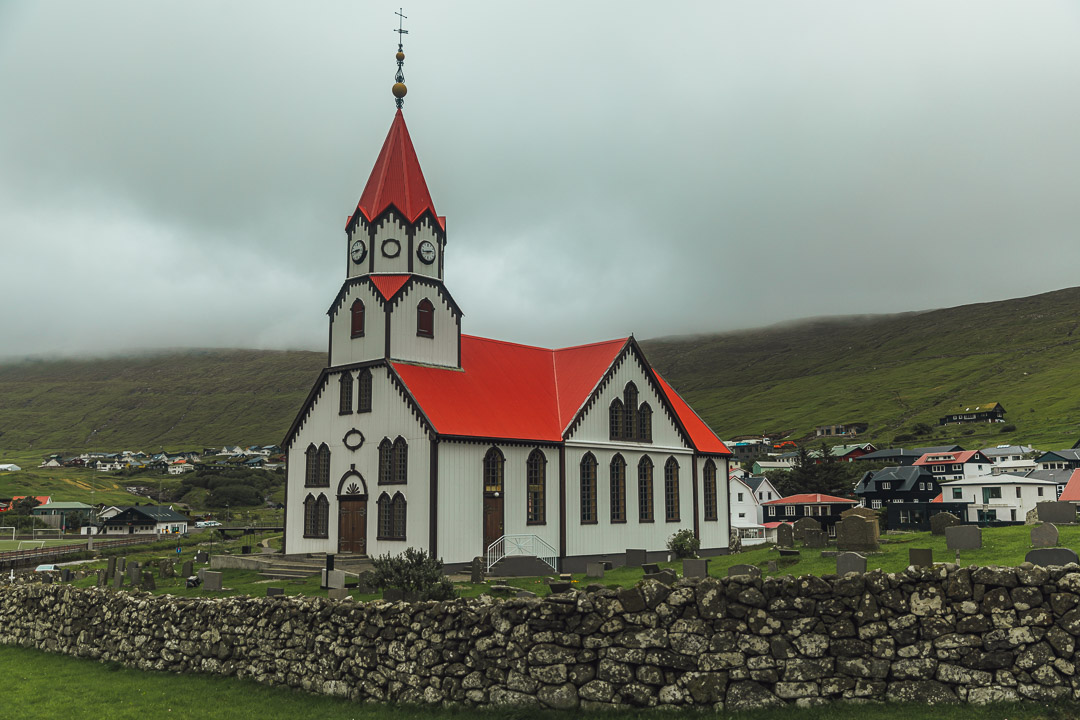
Now that you’ve seen all these beautiful places, drive back to your accommodation in Gásadalur and visit The Nix statue on the way. It’s a wire statue of a horse, peeking out of the lake.
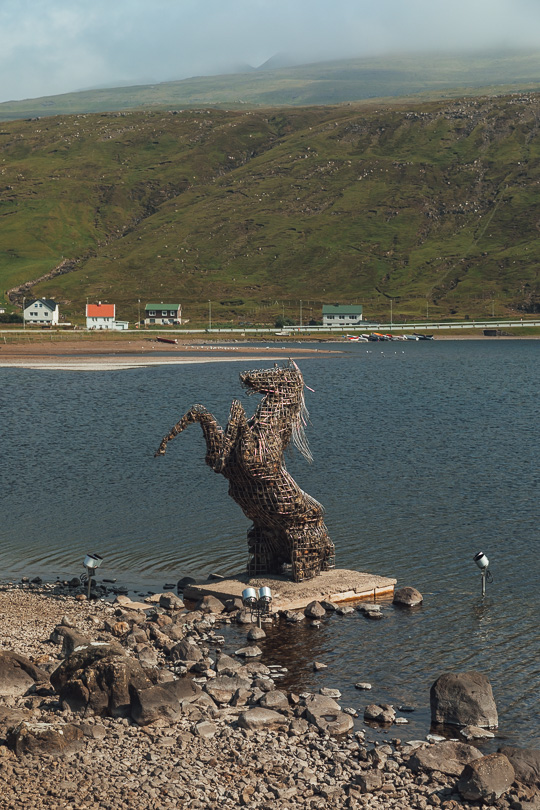
The second day of this Faroe Islands itinerary starts off quite easy, but with plenty of scenic views – hope you enjoyed it!
Day 3 – Hike to Drangarnir or Dunnesdrangar, head to Torshavn on Streymoy Island
Drangarnir hike.
Today you can choose based on your activity levels (and availability). A hike to Drangarnir was something we weren’t able to do since we weren’t there on the right day, but I really hope we can visit again and go there! The hike there is on private land so the guide is the landowner, you can be fined if you walk here without permission. You can book the hike for Wednesday, Saturday or Sunday here .
The hike to Drangarnir is very difficult and quite expensive, at $75 per person for 5-6 hours. If you want to take the easier trip there, then you could also book a boat trip there, which will take you a lot less time (and effort).
Dunnesdrangar hike
If you’re not up to the Drangarnir challenge, then something even more beautiful awaits on Vágar island – Dunnesdrangar ! This hidden gem is now becoming more recognized and lands on many people’s Faroe Islands itinerary. You now have to book a hike in advance and you can do it right here . The hike here is easy, guided and takes about 3 hours both ways.
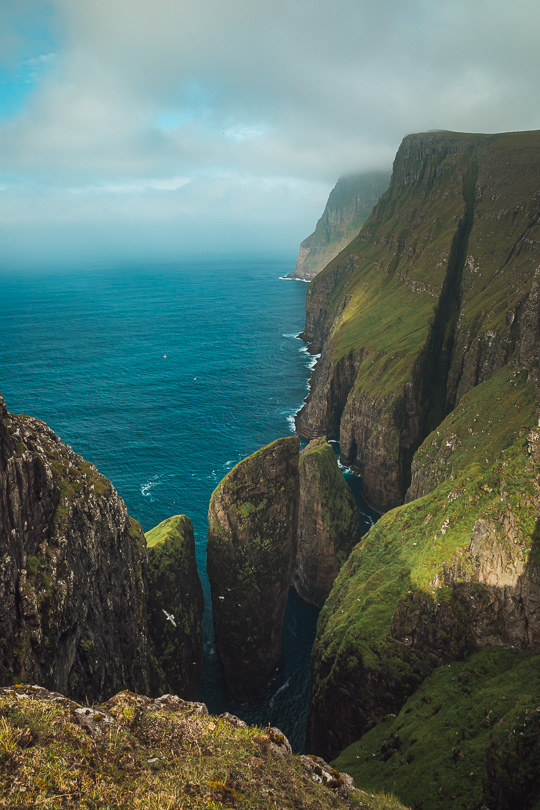
Dunnesdrangar was my ultimate favorite thing to do on this Faroe Islands itinerary. It was absolutely beautiful and we were the only ones there (together with a new friend Cat who we met in the parking lot).
After you are done with either option, head to Tórshavn. The journey to Tórshavn from Vágar takes about 45 minutes and you will be driving through a tunnel. This Faroe Islands itinerary is planned so you’ll only need to drive through each tunnel once (there and back). This tunnel fee is 100 DKK and you can pay it online here .
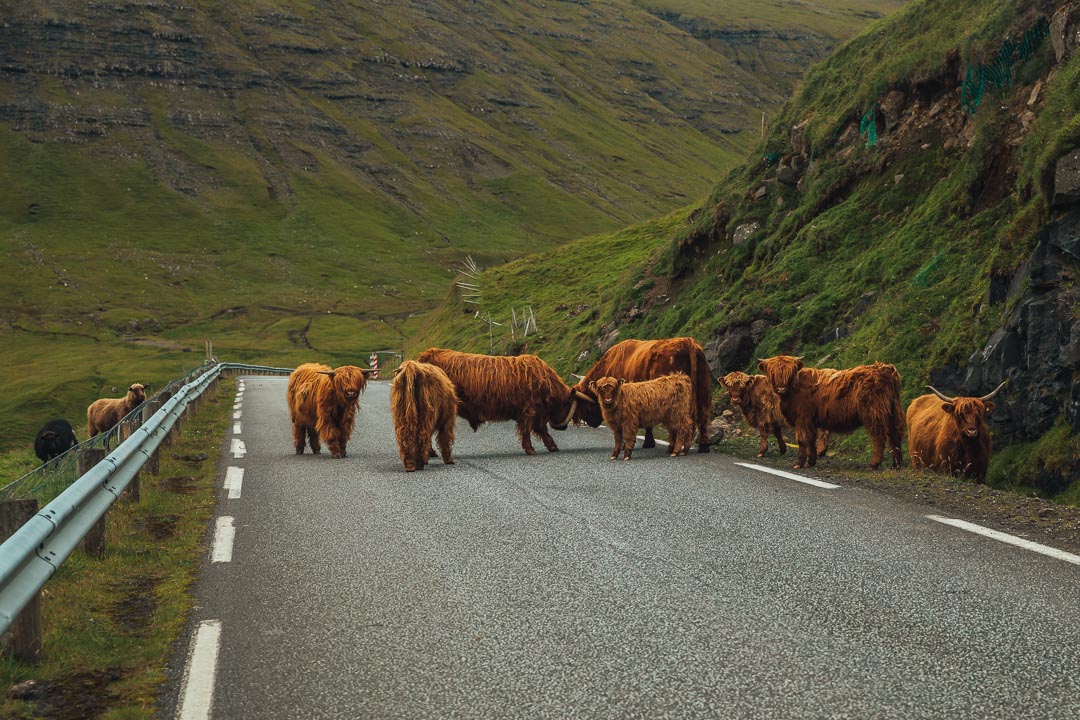
Tórshavn
Book a place close to the marina in Tórshavn, this way you can park at the big parking lot which is free most of the time. Head to the supermarket for some groceries for the upcoming days and get ready for an adventure around the city.
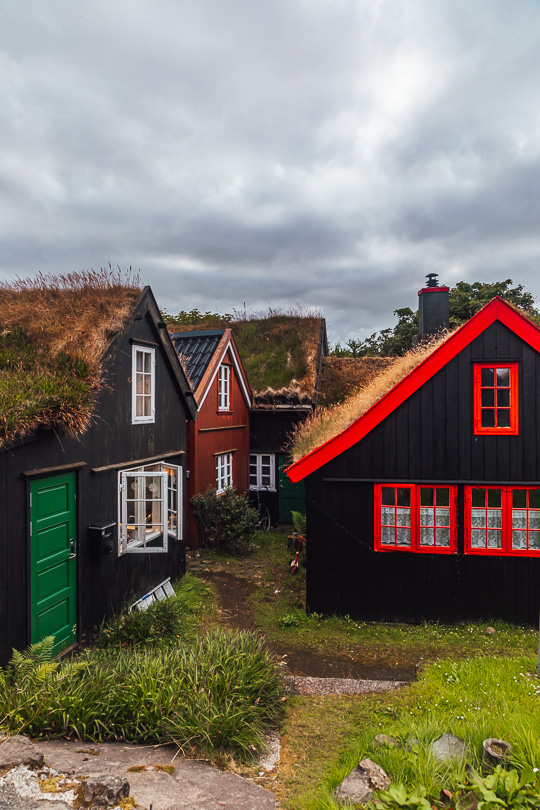
Stroll around the marina for a bit before heading out to a restaurant. This is the only place you can really eat out so if you are craving something this is where you can get it! See all my tips for restaurants and more things to do in Tórshavn here .
Day 4 – Streymoy Island: Saksun to Tjornuvik hike
Have a hearty breakfast today because the hike you have coming up today is tough! Begin your day early and drive up to Saksun to hike to Tjornuvik . You can park your car here and try and hitch a ride back once you make it to the other side (what we did). There is no convenient public transport to take you back to your car after the 4-5 hour hike.
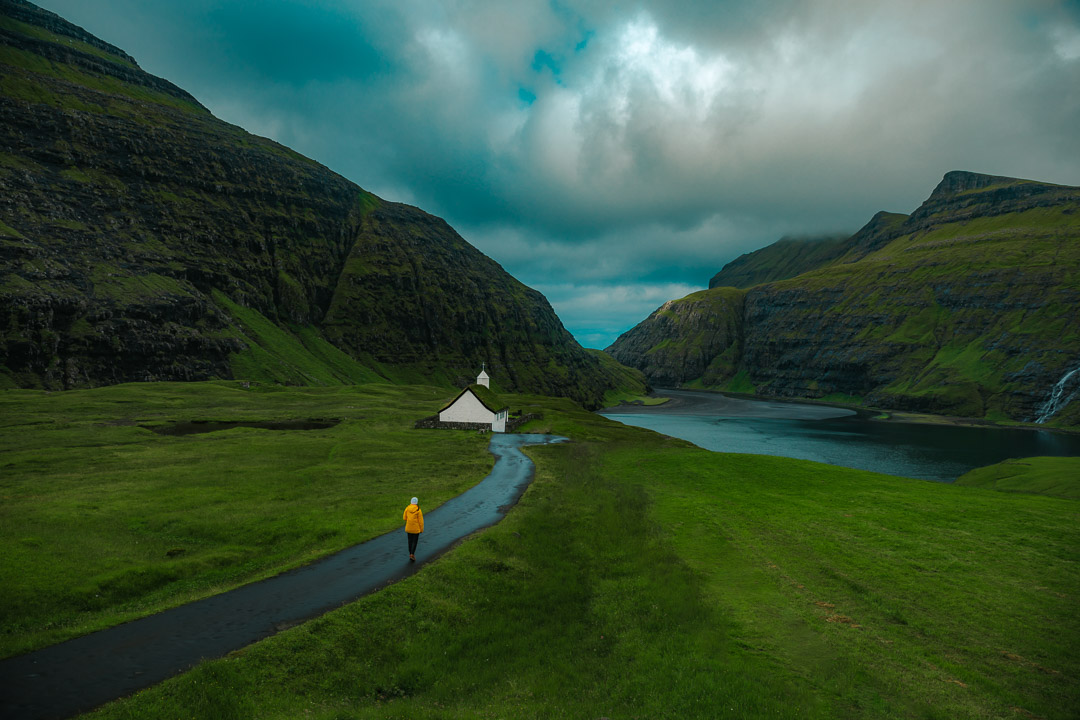
If you are not much of a hiker, then I have an even better suggestion for you (what I wish we did): go to Saksun and take pictures of this stunning village from the bottom. It really is not better from the top and in my opinion, this hike is not worth the trouble.
Then hop into your car and drive to Tjornuvik. There you will want to go higher up for that amazing viewpoint of the village. The hike up here is difficult, but it’s worth the trip! Then head back down, hop in your car and you’re done! The path in between the villages is super foggy, there’s not much to see and unless you’re really into hiking it’s not worth it. Thank me in the comments 😉
After you’re done with both, look at some villages you pass. There are plenty of beautiful spots on the way back to Tórshavn.
Day 5 – Day trip to Sandoy island
If you’re keen on exploring some not-so-touristy islands in the Faroe Islands, then make sure you plan a day trip to Sandoy. It’s easily reachable with a ferry from Gamlaraett to Skopun.
Book the ferry here , with a car spot for 160DKK for the car with driver +40 DKK for each passenger in the car. The ferry ride takes about 30 minutes and I recommend you take one in the morning at 8 am, see the schedule here .
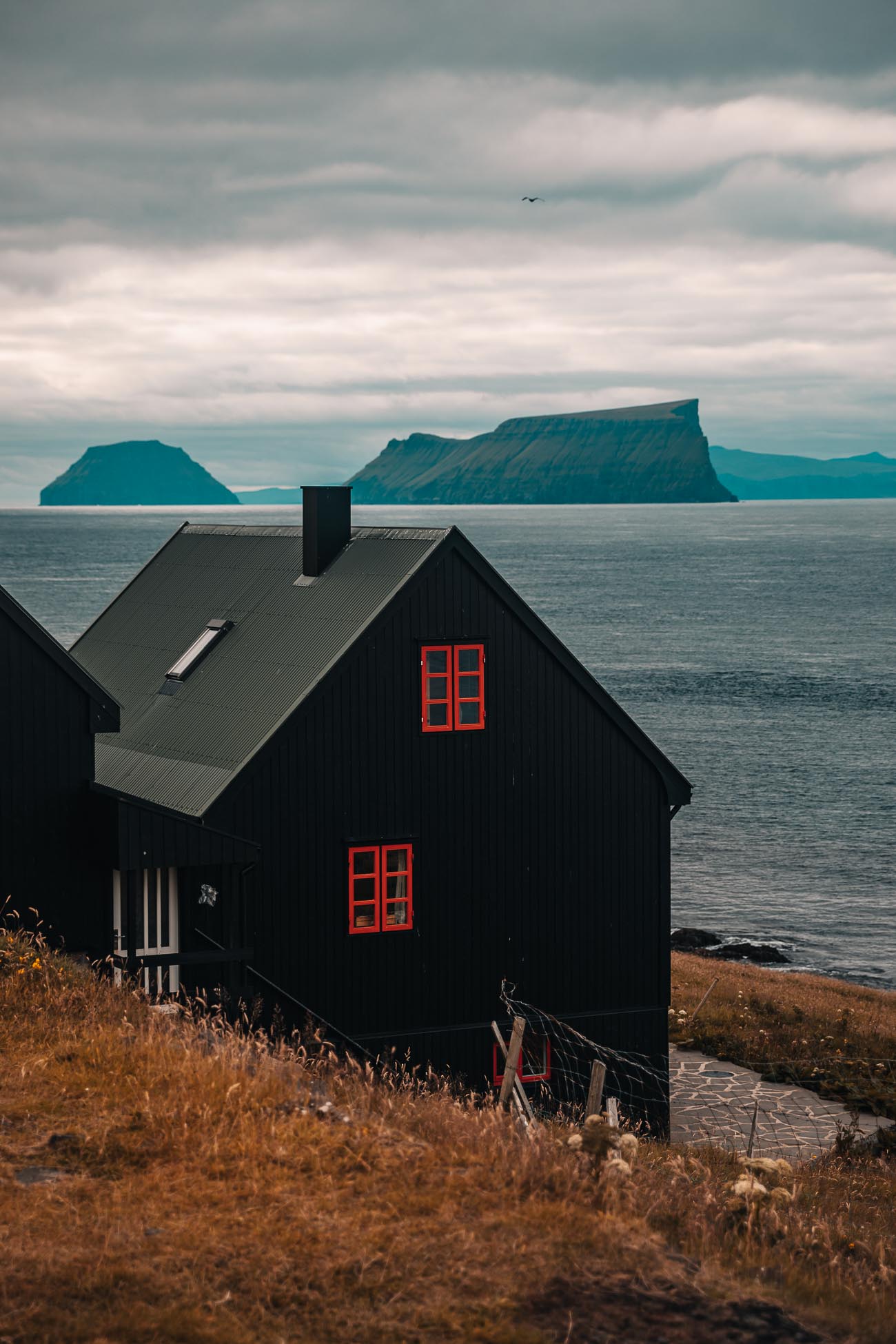
I wrote a detailed guide to Sandoy and the best things to do there in this article . Since Sandoy is not so big, you only need about 6 hours there, which means you can head back when it’s still light outside. If you manage, then visit Kirkjubour Village – it’s very charming! If you don’t manage today, then you can also do it the day after.
Day 6 – Kirkjubøur Village, head to Eysturoy Island and hike from Oyndarfjørður to Elduvik
If you didn’t manage to visit the charming Kirkjubøur Village yesterday, then head there this morning after breakfast. This village is Streymoy’s most southern village and also the Faroes’ most important historical site. Here you will see a church, charming houses and ruins of the Magnus Cathedral from around 1300. It was one of my favorites on this Faroe Islands itinerary.
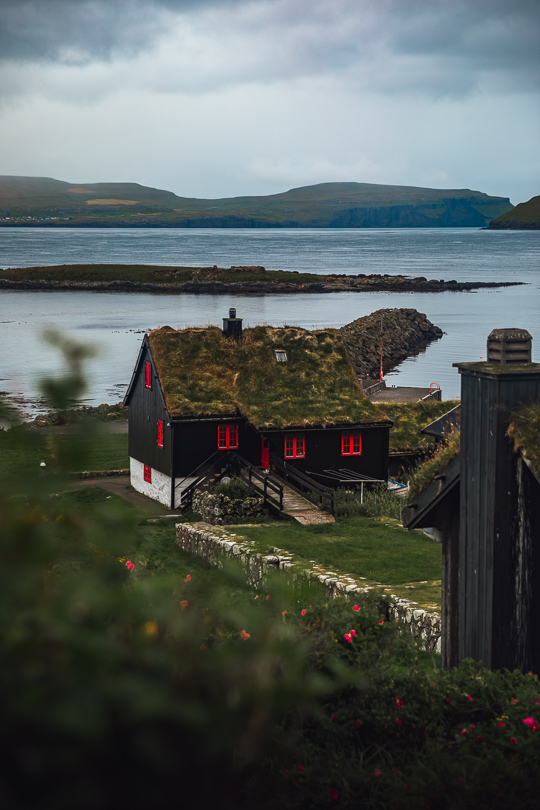
After that drive towards the town called Gøtugjógv for checking into your new accommodation. You could pick another location on this island, we chose here because of its central location. Head to the supermarket which is located here and get some food for your meals.
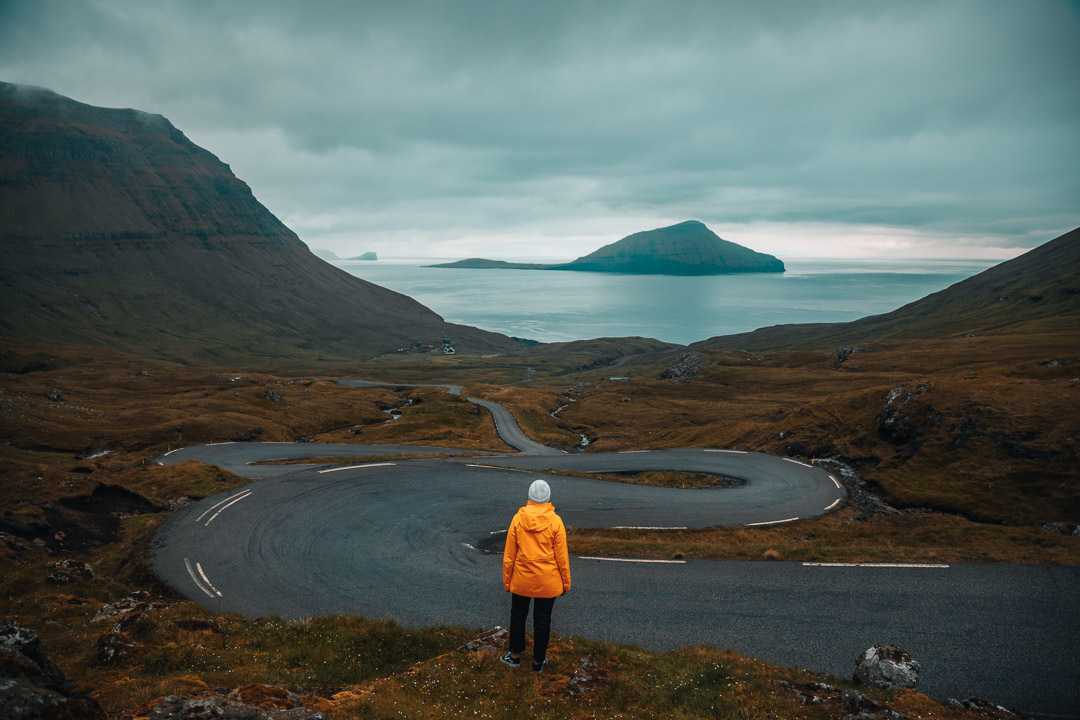
Since the hike from Oyndarfjørður isn’t tough or long, you can easily do this before the day ends as well. On this hike, you will some beautiful views of the villages and the neighboring islands.
There is a pretty cool tunnel with a roundabout between Streymoy and Eysturoy and it costs 200 DKK (both ways) to cross it. Make sure you take the right turn towards the right side of Eysturoy.
TIP: In case you only have a week to visit Faroe Islands and aren’t too keen on making plans and transport yourself, here is a 6-day organized summer tour you could also take!
Day 7 – Eysturoy Island: Hike to Slættaratindur, see Risin og Kellingin, Eiði, and Gjógv village
Hike to slættaratindur.
After breakfast, get ready for hiking to the tallest peak in the whole Faroe Islands, and Denmark! The path up might be steep and requires some stamina, but it is by no means difficult.
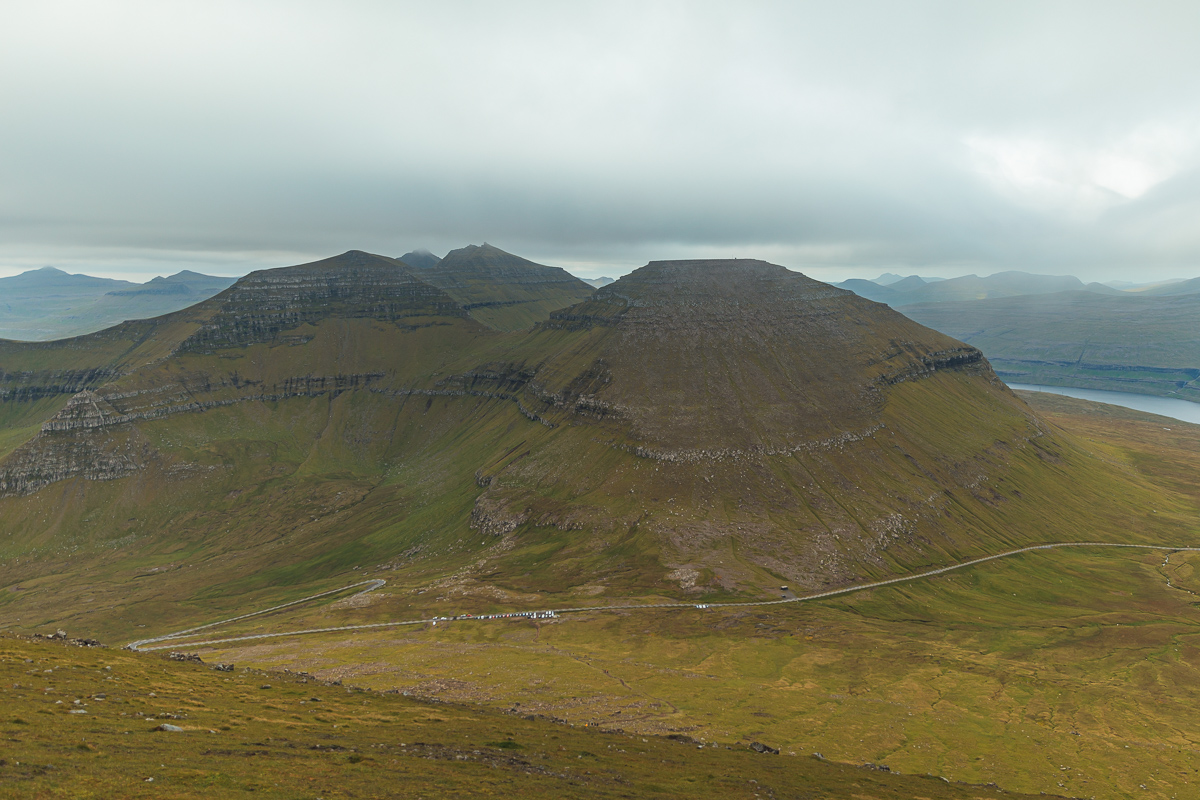
The peak is at 880 meters and you should have a wind jacket (very windy and foggy at the top) and proper shoes here, especially if the weather turns sour. The hike to Slættaratindur will take about 2 to 2,5 hours and you’ll have plenty of time to see the rest of the beautiful places on this island.
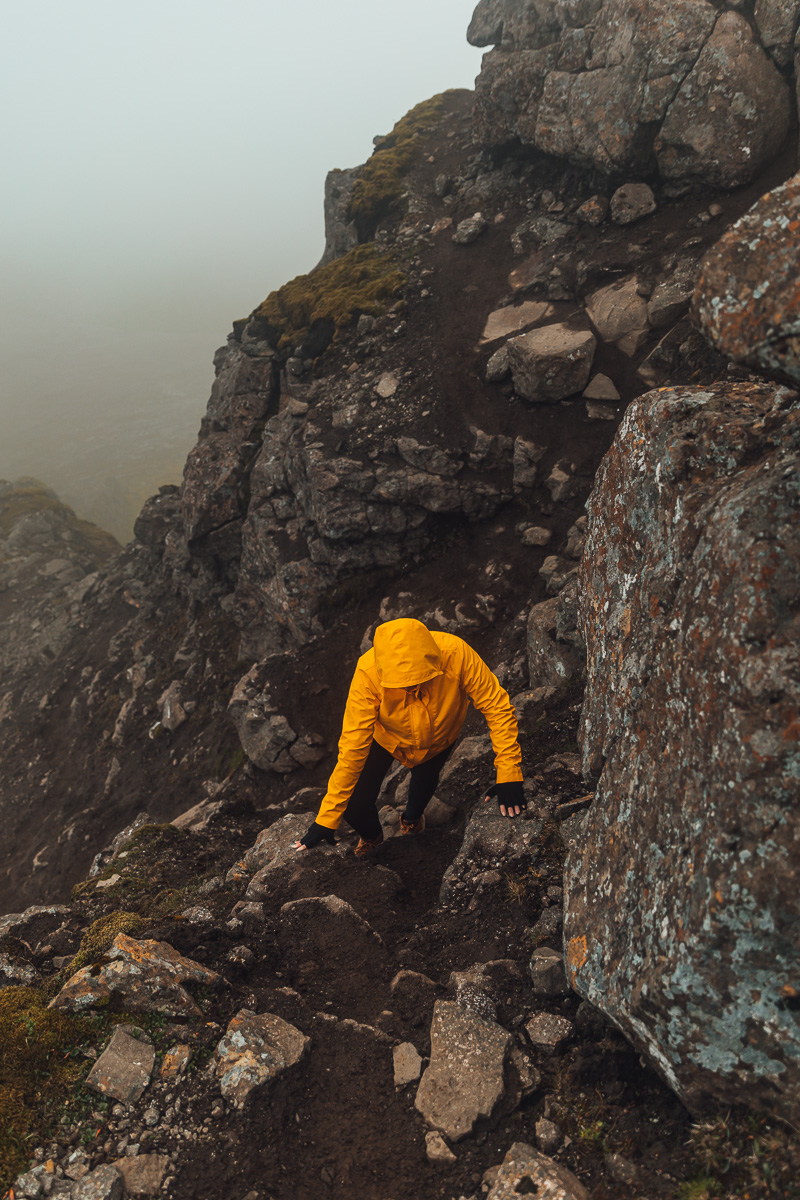
View of Risin of Kellingin
This is a short stop and you’ll see the large parking lot and the view of these two sea stacks on the way to Eiði. The name Risin og Kellingin means The Giant and the Witch and is related to an old legend.
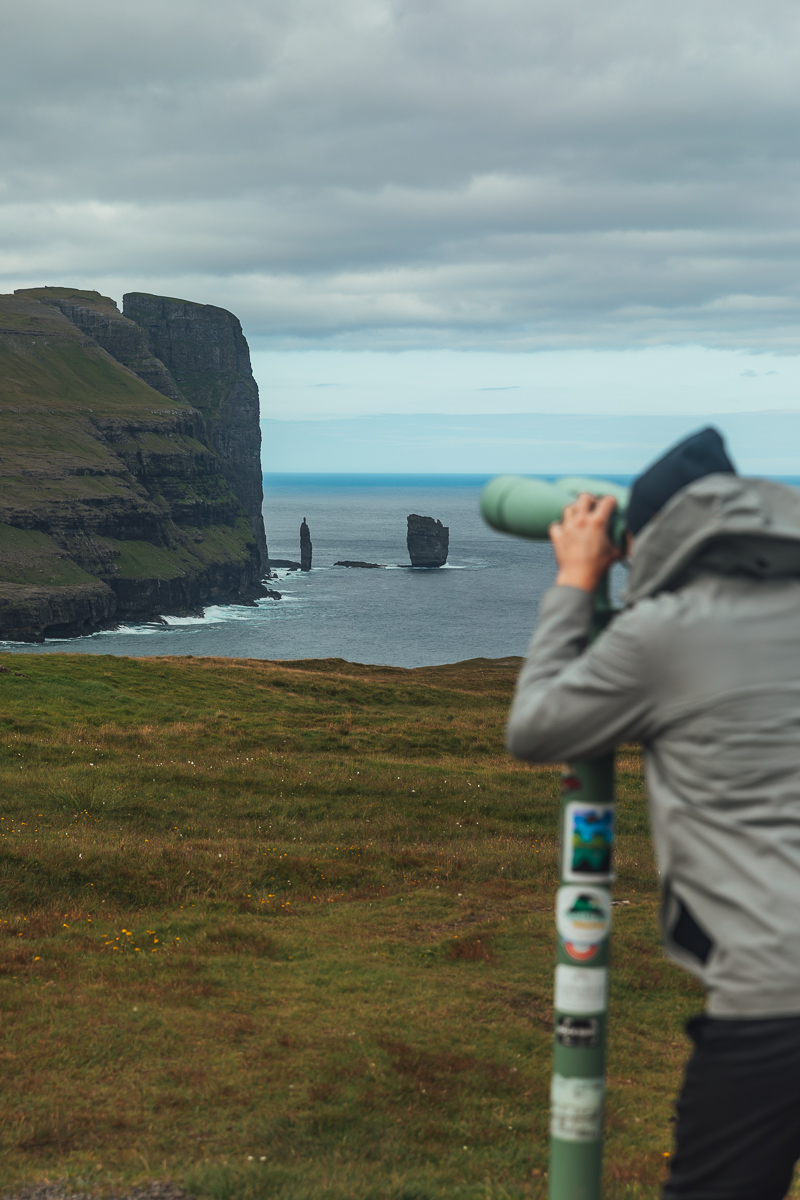
Eiði and Gjógv village
Drive past Eiði village and take in the charming Faroese views.
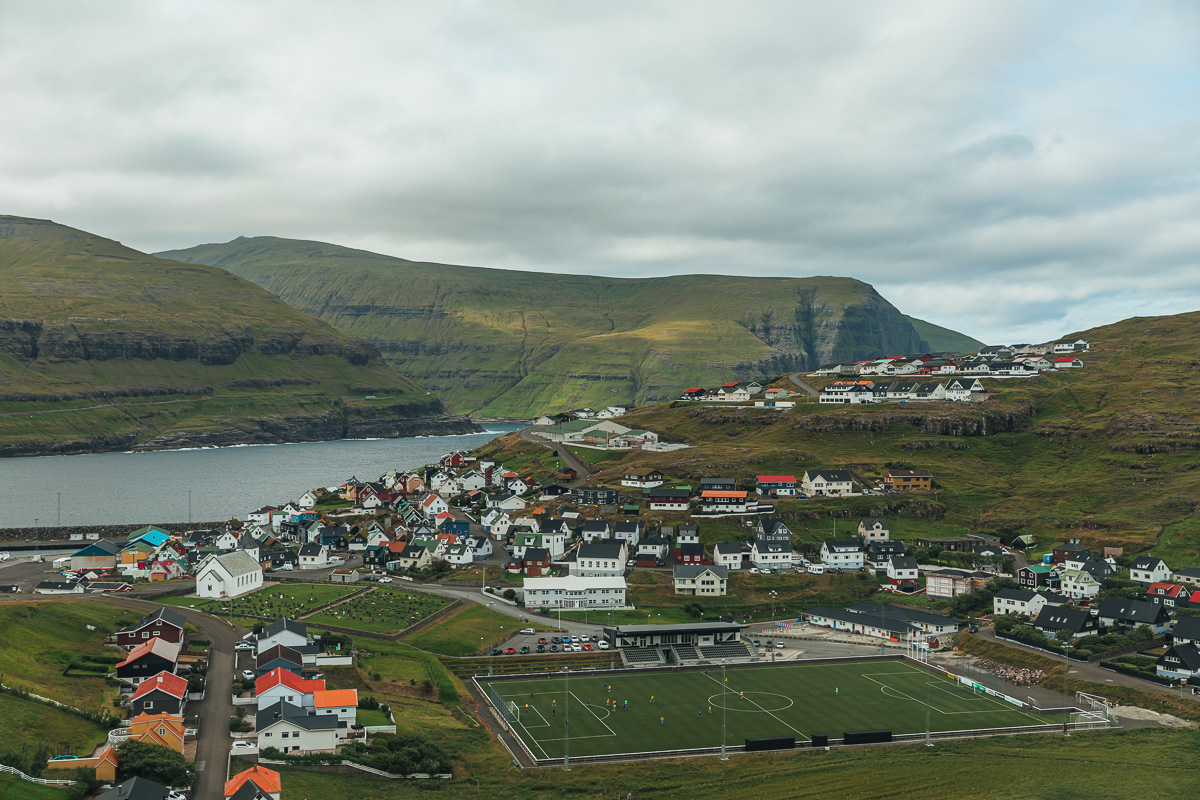
After that make your way to Gjógv village and stroll, take photos and enjoy a cup of coffee. If you’re visiting at the right time of the year (summer), you’ll even see puffins here! Hard to choose which are the prettiest villages on this Faroe Islands itinerary, right?
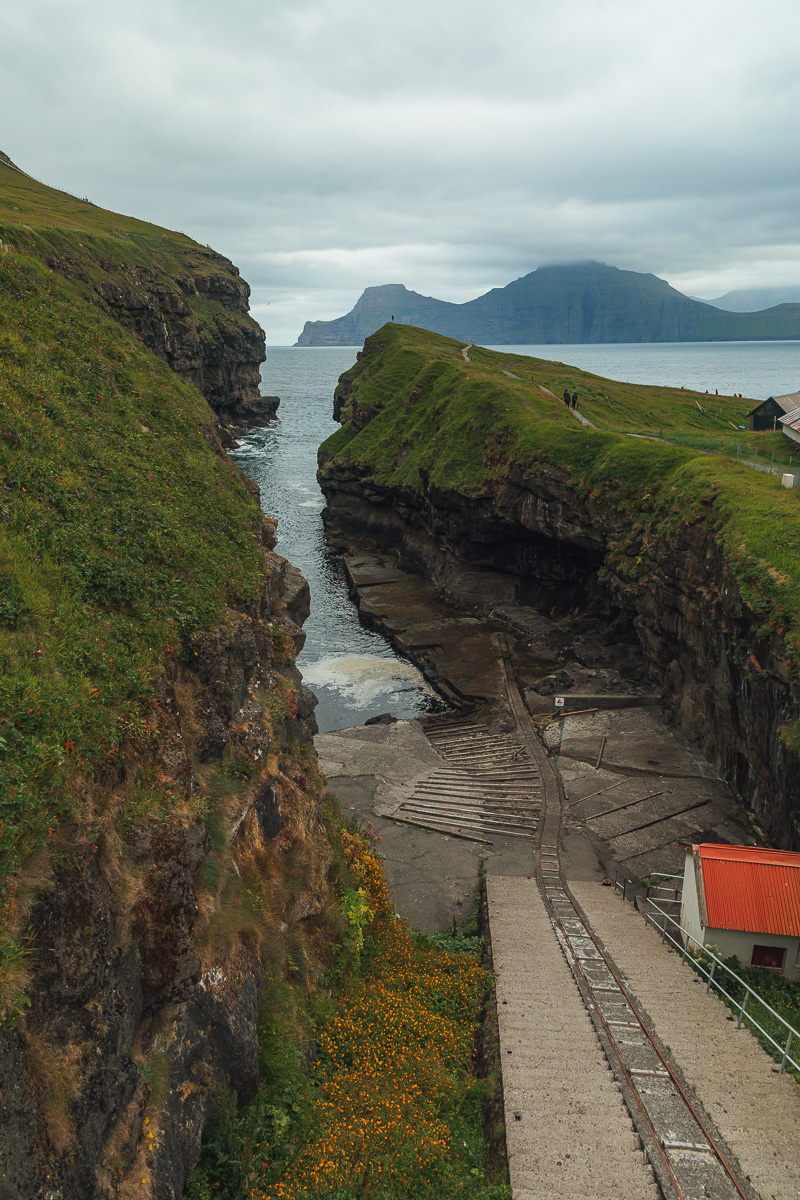
Day 8 – Visit Klaksvík, Viðareiði, then head to Hvannasund on Vidoy Island
Today you are checking out and driving towards Vidoy island. You will drive through the last paid tunnel here, this one costs 100 DKK both ways. But that doesn’t mean that’s the end of tunnels – quite the opposite! This part of the Faroe Islands is packed with tunnels and many of them are one-way, pitch-dark and a little bit scary if you ask me. But they’re wide enough and easy to drive through – I just wouldn’t walk there!
Make a stop at Klaksvík for some amazing views of the city hugged by hills, get some groceries (since this is the second biggest city in the Faroe Islands), see Viðareið and then head off to your next accommodation for a relaxing night in.
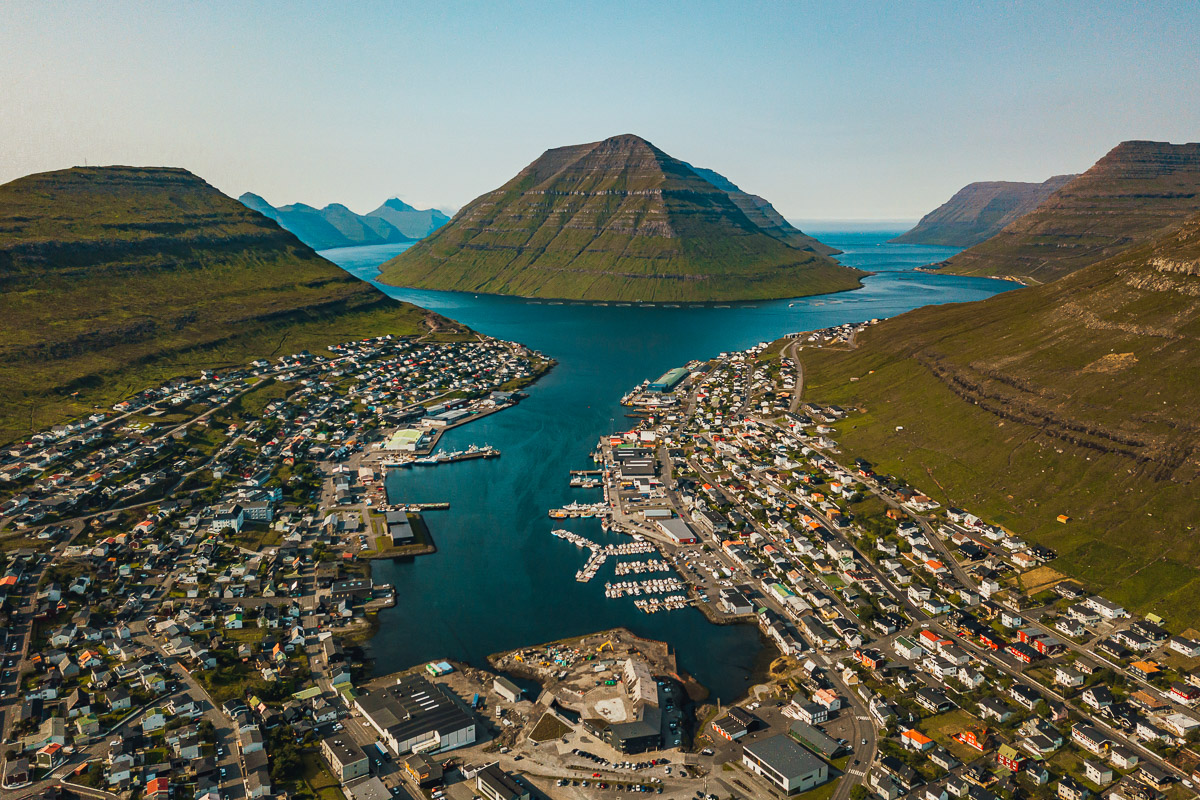
We booked a tiny cabin in Hvannasund and it was just perfect. You’ll be staying your last two nights here, while you explore all the things left on this part of the Faroe Islands itinerary.
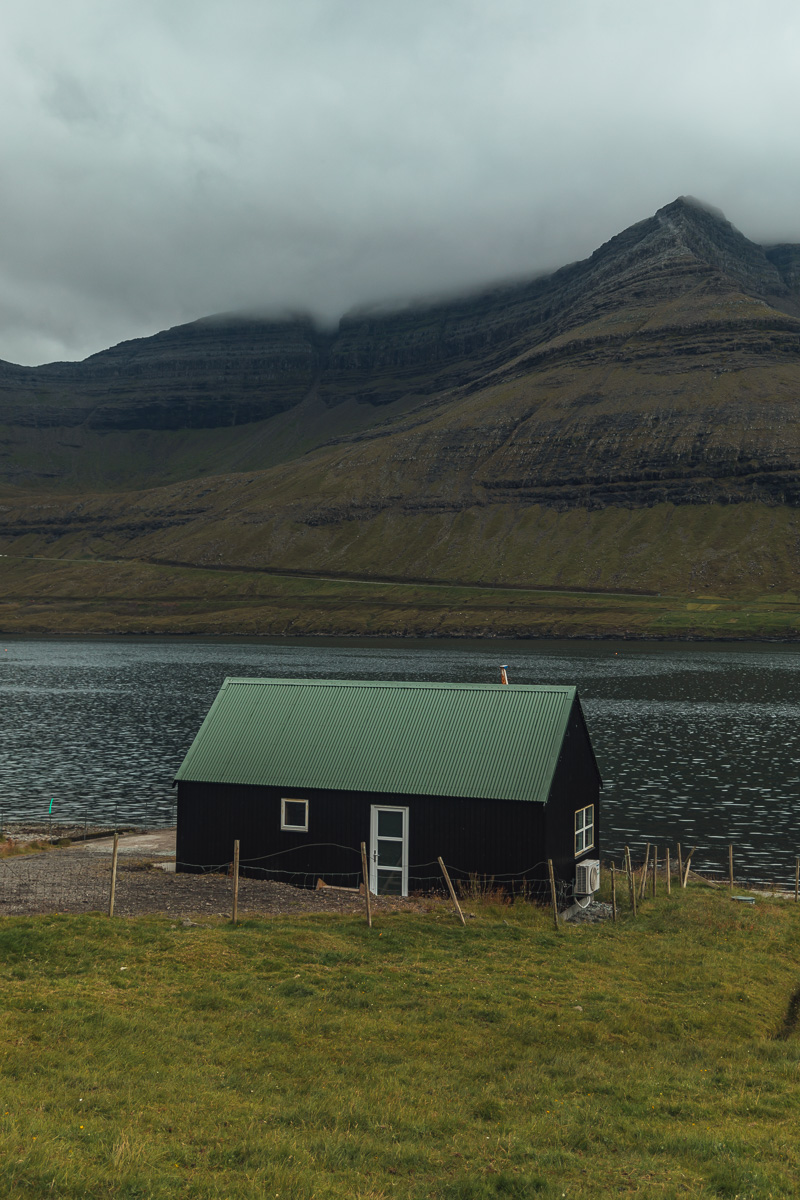
Day 9 – Day trip to Kalsoy Island: Mikladalur, Kóppakonan, Kallur lighthouse
Start bright and early at 6 am and head to the ferry spot in Klaksvík that will take you all the way to the beautiful Kalsoy island. Make sure you are there early to secure a spot on the ferry since the space is very limited.
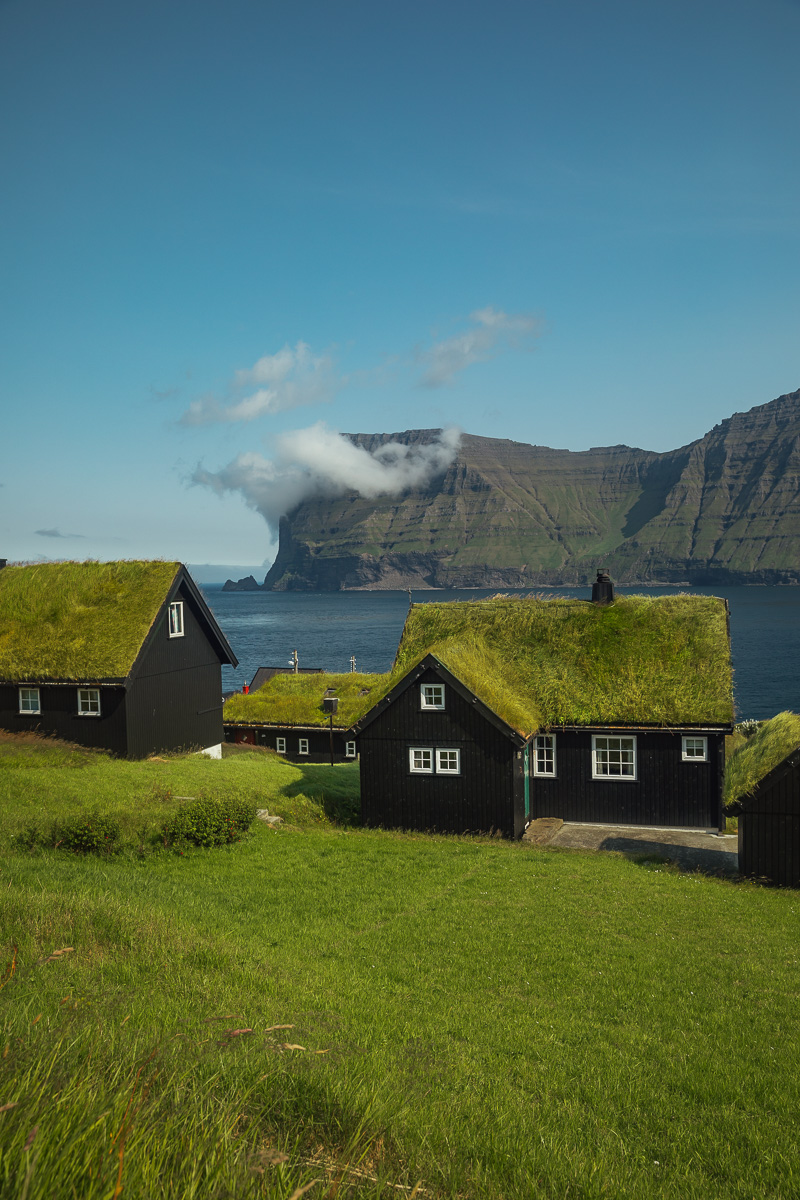
Kalsoy is most famous for the Kallur lighthouse hike and I was convinced it would be a tough hike – in reality, it wasn’t at all! The only place that scared me was walking across the steep path to see the lighthouse from the other side. Once you are done with the hike, slowly head back towards the ferry terminal and visit Mikladalur, Kóppakonan and take in all the sights on your last full day here!
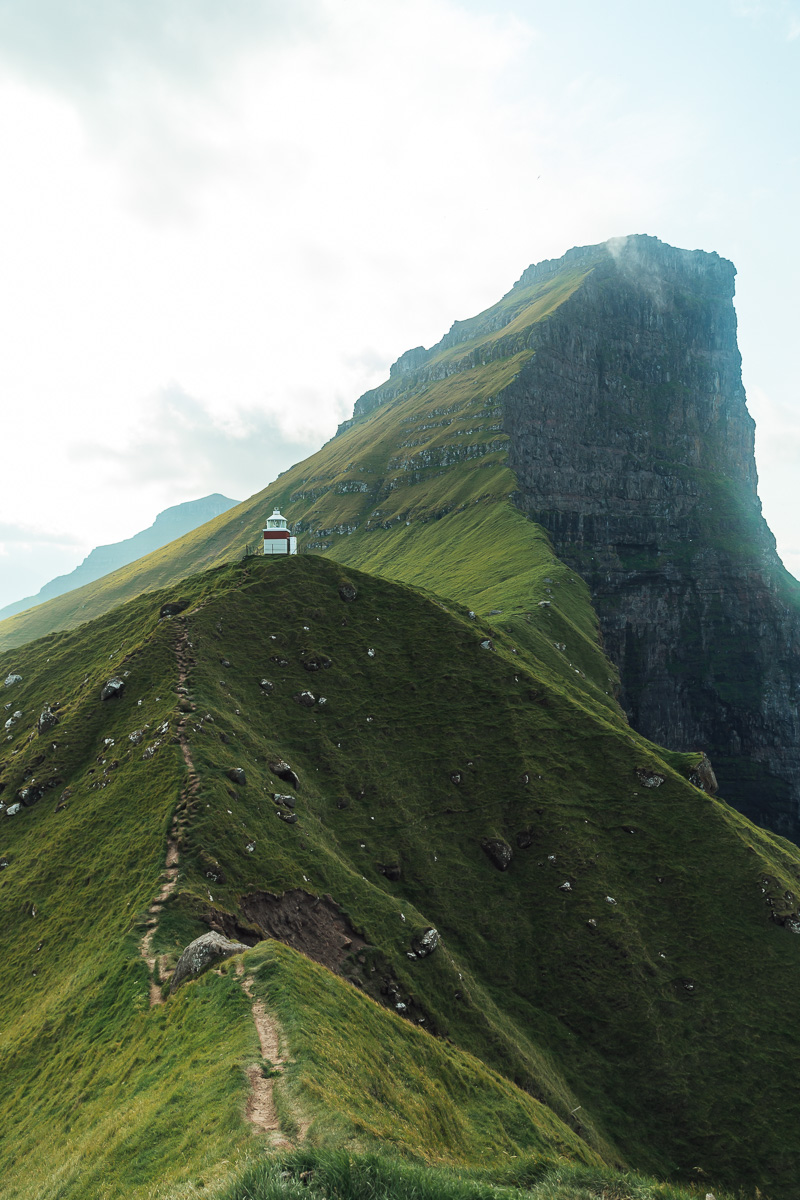
Bear in mind that Kalsoy is also packed with tunnels, though all of them are free.
Day 10 – Head to the airport
Your last day of this Faroe Islands itinerary has arrived and you are off to the airport. You will make your way back through quite a few tunnels now, but none of them you will have to pay extra for. The fees are always charged only once, so in total (with this itinerary), you’ll be spending a max of 400 DKK for the three big tunnels.
Park your car at the airport for the rental company to pick up and you’re off!
Mykines – Optional
I know, it says optional when Mykines tends to be such a must-do on so many other guides. But quite frankly, the only reason we were interested in going there was to see the puffins.
What no guide tells you (and I got this information straight from the Faroe Islands tourism office) is that puffins can be seen in many places in the Faroe Islands. Albeit, not quite as many as you can see on Mykines, but in our case, the extra fees and complications around going there simply weren’t worth the hassle.
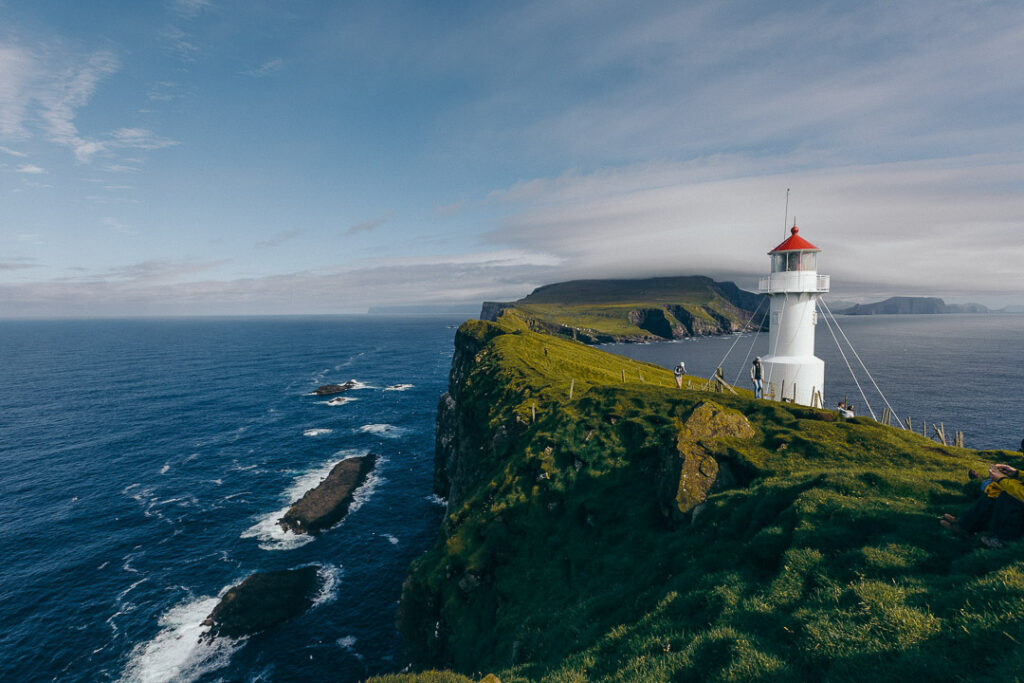
If you however really want to go, then you must read all the things you must know before you book your trip to Mykines.
I hope you enjoyed this Faroe Islands itinerary and if you have any questions, just ask in the comments below!
Faroe Islands Itinerary – Questions
How many days do you need on the Faroe Islands?
I found that the ideal time to spend in the Faroe Islands is 10 days. You could shorten your visit and visit fewer islands, but I would highly recommend to spend at least 7 days there. If you are short on time and only have a long weekend, then I suggest you spend 4 days on Vagar island. There’s so many beautiful spots there! I would say 3 days in Faroe Islands is too little though, unless you only want to see a handful of easy to reach spots.
Is Faroe island expensive?
The Faroe Islands are expensive and this is coming from someone who lives in Scandinavia. Car rentals are the highest expense we had, but they have some pretty steep hiking fees here too. I highly suggest you at least book your car well in advance because the longer you wait, the less cheaper options will be available.
Is it worth going to Faroe Islands?
It is 100% worth going to the Faroe Islands. It’s a beautiful place and I can’t wait to go back one day!
Save this post for later
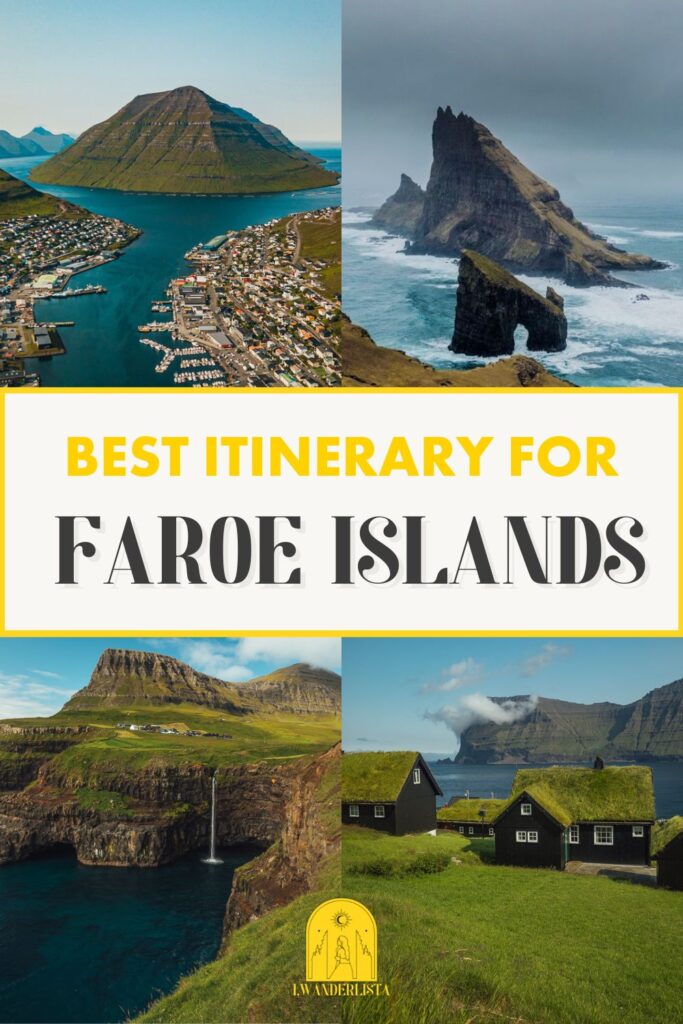
Related posts
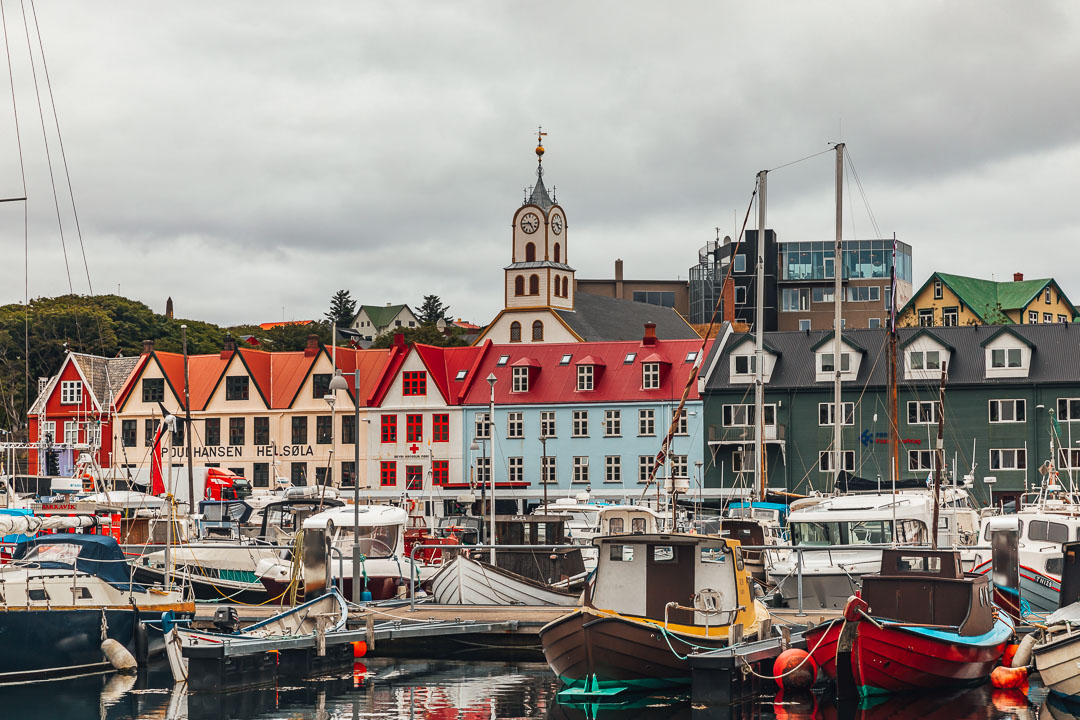
Read all articles about
Faroe Islands
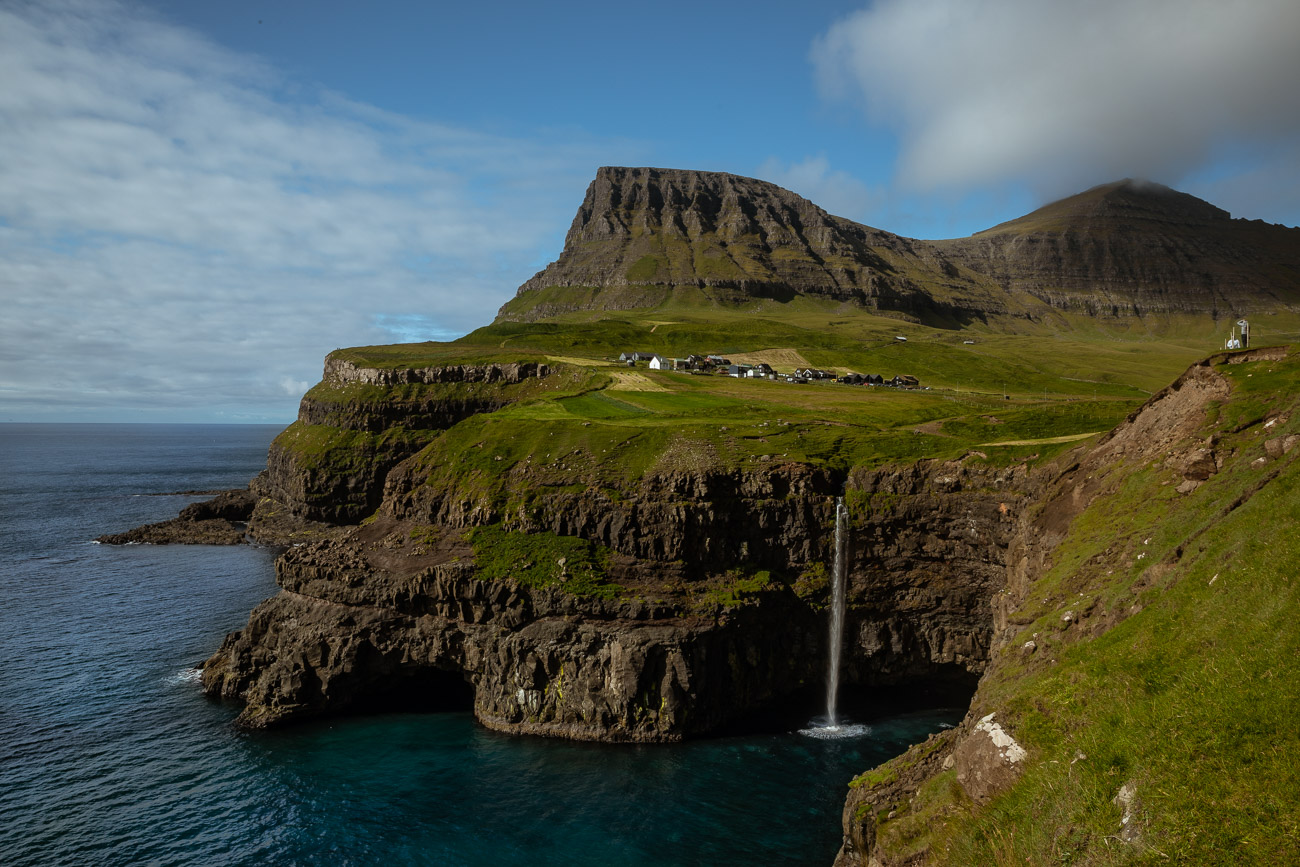
- Vacation Packages
- Attractions
- Explore Faroe Islands
Best 2024 Vacation Packages in Faroe Islands
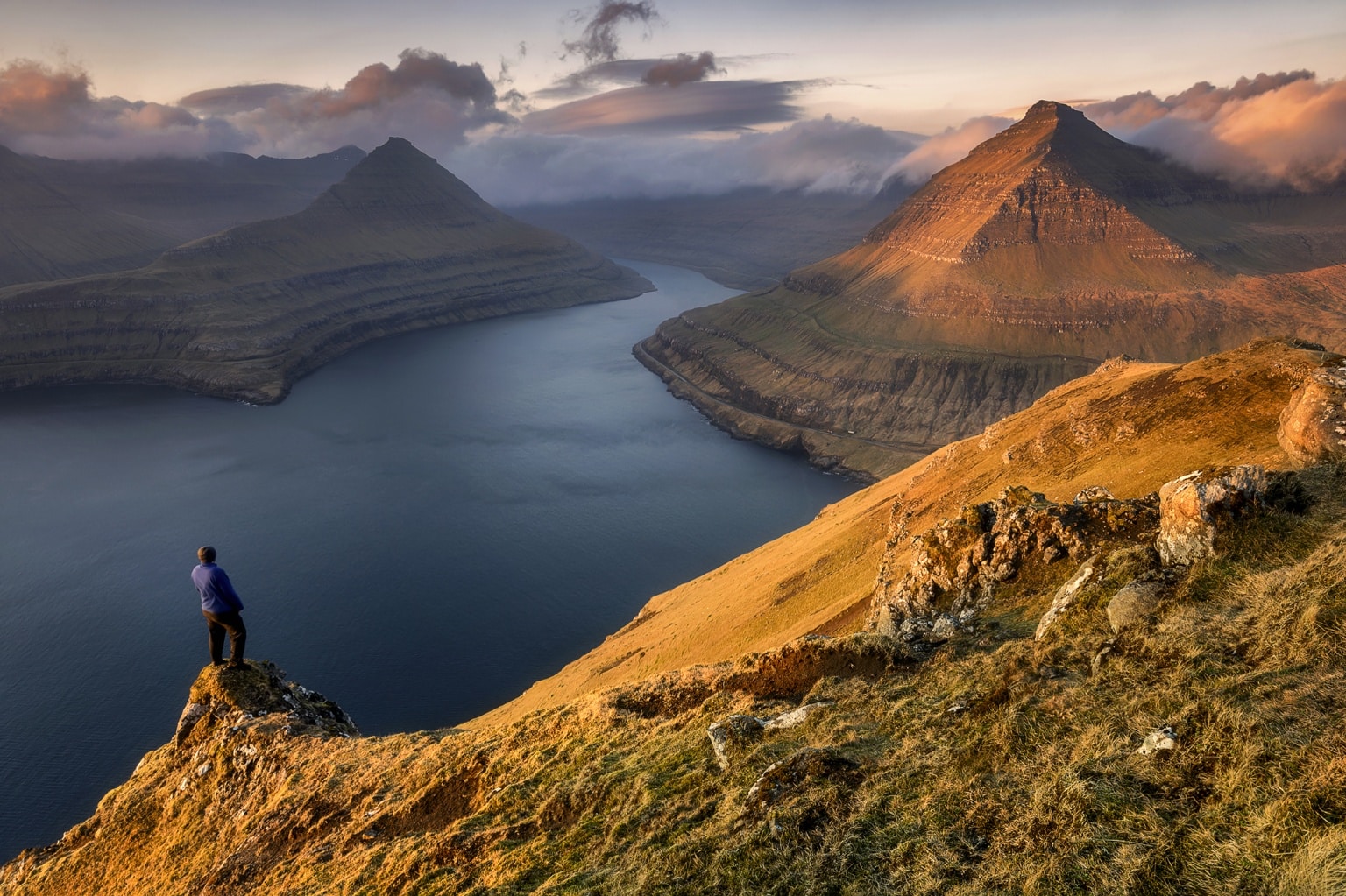
Find the best 2024 vacation packages in the Faroe Islands. Have your route, transfers, accommodation and tours all planned for you in advance. Add extra tours and activities to your itinerary.
Showing all 23 results

Classic 6 Day Summer Package of the Faroe Islands
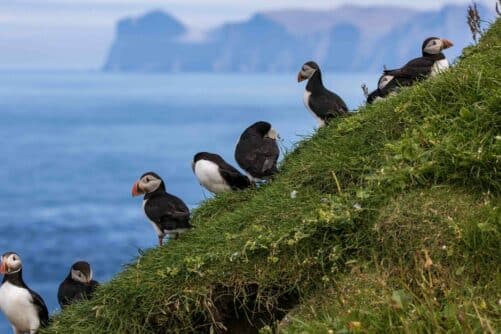
Striking 8 Day Summer Package of the Faroe Islands with Top Attractions
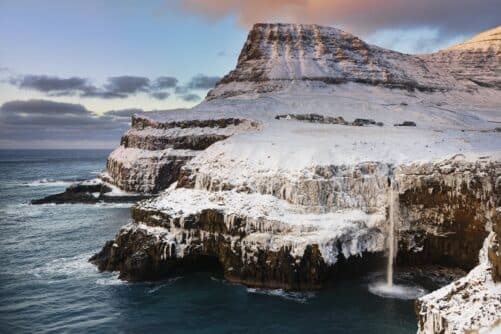
5 Day Winter Package | Tour the Faroe Islands
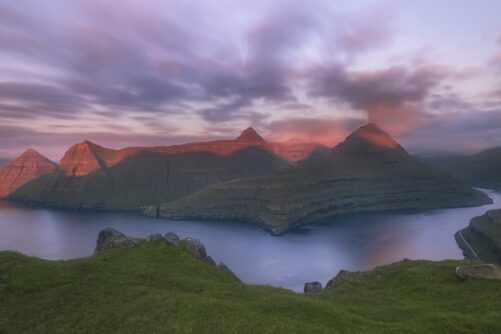
Unforgettable 7 Day Summer Package of Faroe Islands
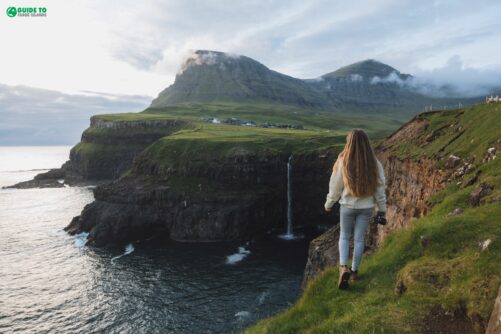
Incredible 3 Day Faroe Islands Highlights Package
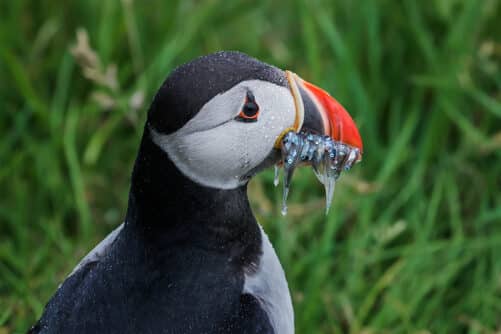
Unbelievable 5 Day Summer Vacation Package of the Faroe Islands
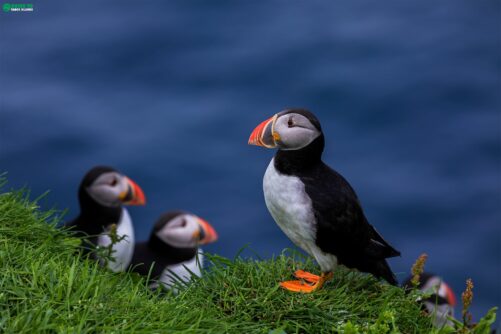
Refreshing 7 Day Summer Package of the Faroe Islands

Unforgettable 10 Day Self Drive Tour of Faroe Islands with Top Attractions

Classic 8 Day Faroe Islands Hiking Package
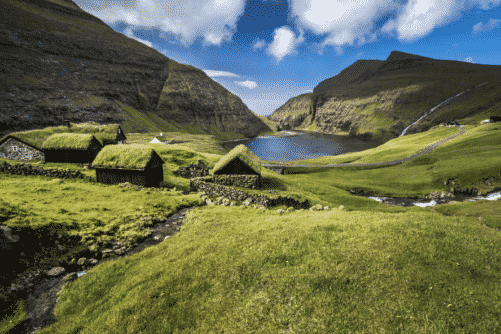
Epic 8 Day Summer Self Drive Tour of Faroe Islands

Scenic 5 Day Self Drive Tour of Faroe Islands
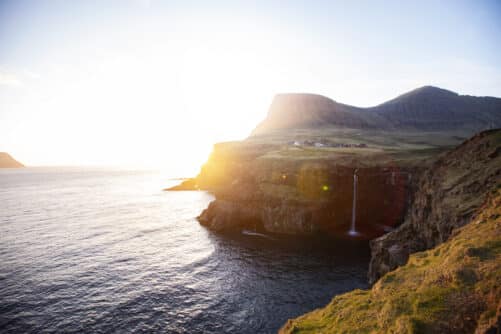
The 4 day Photography tour | Faroe Islands highlights
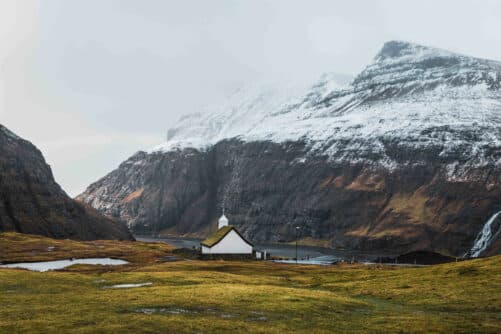
4 Day Winter Package | Best of Faroe Islands
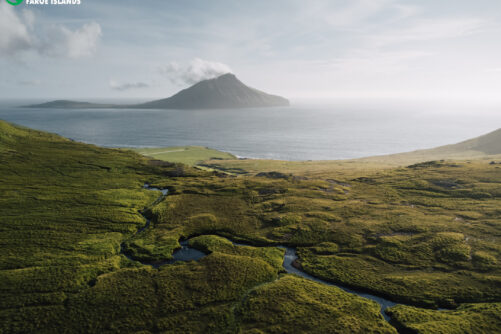
Essential 7 Day Faroe Islands Self-Drive Package

Amazing 6 Day Self Drive Tour of Faroe Islands

Breathtaking 6 Day Winter Getaway to the Faroe Islands

The 5 day Photography tour | Faroe Islands highlights

Secluded 8 Day Winter Package of the Faroe Islands
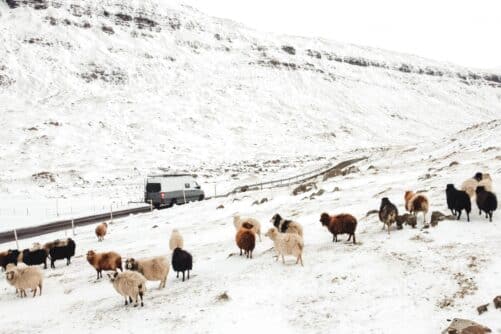
Tranquil 4 Day Winter Trip of the Main Faroe Islands
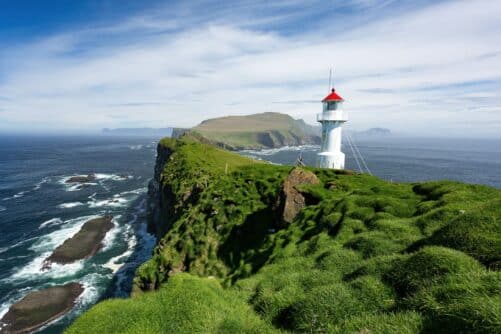
3 Day Summer Self-Drive | Sea Cliffs & Uncrowded Villages
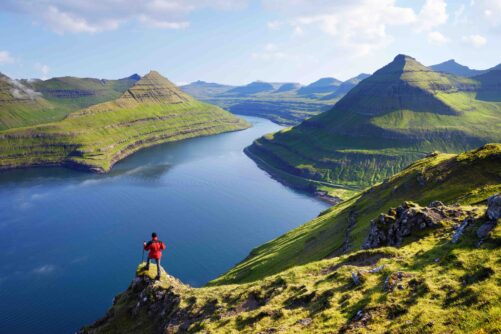
Adventurous 6 Day Summit Hiking of Faroe Islands
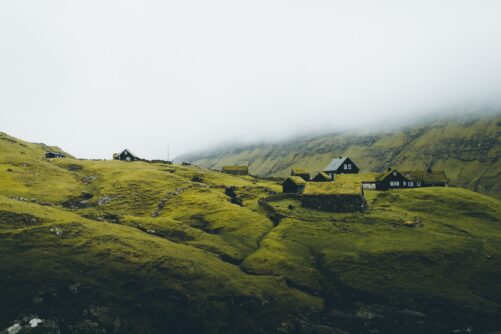
Breathtaking 6 Day Guided Summer Package of Faroe Islands

4 Day Summer Self Drive Tour | Top Attractions

- Private Escorted
- All Inclusive
- Corporate Travel

- PLAN YOUR TRIP
Faroe Islands Tours: Bespoke Itineraries with Local Faroese Guides
See the Faroe Islands the right way - through a fully-customized, uniquely-personalized itinerary. No predetermined Faroe Islands tours where you’re stuck seeing and experiencing the same things that everyone else does (and with most tours, you’re also experiencing those things with strangers).
Our Faroe Island Tours Are Loved By People Just Like You
When traveling to the Faroe Islands we would definitely recommend choosing REMÓT travel to experience this unspoiled and untamed Island group. Very unique and individual service with a 24/7 ‘hotline’ with our guide Rasmus who was extremely friendly, professional and knowledgeable. Thanks to Rasmus we saw the islands from land, sea and air! If you are a foodie, don’t leave before eating at Koks!
Amazing that REMÓT Travel has launched in the Faroe Islands! High-quality experiences, inclusive of the locals, and a way to authentically discover the place, an amazing new option for travelers and an important addition to the Faroese hospitality space, as a whole.
During our trip to the Faroe Islands, we could not have been in better hands than with Remote Travel. We did such a variety of activities (as per our requests and Romote travel suggestions) and were so pleased with all of them. Our guides (all Faroese) were terrific responding to any extra requests we had and our accommodation was the best the Faroes has to offer. We loved the Faroe Islands and found the Faroese people an absolute joy to be with.
REMOT Travel has a very special place in our hearts: REMOT planned, organised and executed our trip to the Faroe Islands in the autumn of 2021 and did so to absolute perfection. We stayed in lovely cottages, explored and wandered the countryside and hills, dined at the Michelin-star KOKS restaurant, sailed the fjords and just genuinely loved the trip, the hosts and guides as well as the Faroe people. Would highly recommend anyone planning that special trip for you and your special one(s) to call on the REMOT team.
Let Us Book Your Unique Faroe Islands Tour Experience
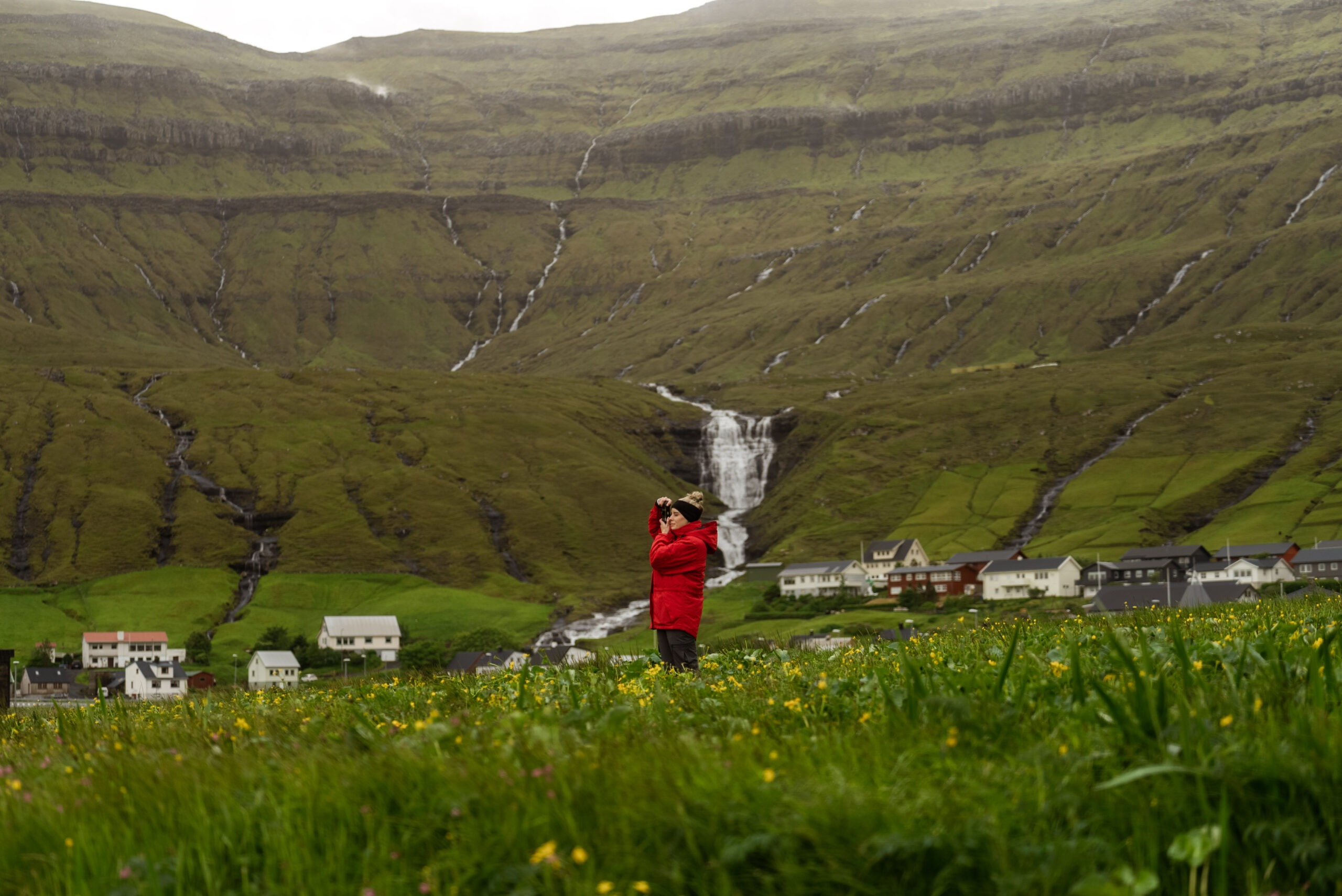
REMÓT TRAVEL is a travel agency in the Faroe Islands .
We’re run by local Faroese people and help our clients have the most unique experiences possible, connecting them with interesting local people along the way.
But our Faroe Island Tours go beyond the ordinary.
- You love cooking and want to have a private chef come to your accommodations and teach you how to cook fish the Faroese way? We can arrange it.
- You enjoy seeing remote villages and getting intimate, one-of-a-kind tours of farms, fisheries, or local trades? We can add that to your tour.
- You’re a private pilot and want help arranging and coordinating a charter for a small plane that you can fly around the islands? We have connections and can make the process simple.
Every person is unique. Therefore, every tour of the Faroe Islands should also be unique.
No Stuffy, Boring, and Disconnected Group Tours
Most other tours, the remót travel tours, 5 reasons to book your faroes islands tour with us.
Our concept is built around remoteness, hence the name REMÓT. We want to enable travelers to discover the remote corners of our planet - fittingly starting with the Faroe Islands. This Remoteness is also reflected in our REMÓT Retreat accommodations, pearls that combine the sense of escape with Faroese authenticity.

Centred around locals
Our REMÓT Journeys are designed and centered around the locals, whether having dinner with the local farmer, fishing with the local fisherman, or going hiking with a local guide. We always provide REMÓT travelers with the opportunity to truly get a strong feel for the local environment, discovering local cultures, traditions, and nuances. We believe this is what makes for the most immersive and insightful travel experiences.
Sustainable approach to travel
The Faroese have lived alone and isolated on the Faroe Islands for over a millennia. Hence, we are still getting used to the new reality of becoming a more active and visible player on the world map - and this is also true for Faroese tourism. We believe that the best way to evolve Faroese tourism is through incremental steps, inviting locals to participate in every step of the way. Hence, at REMÓT, we have ensured to invite truly local players - from farmers to fishers to nature enthusiasts - to participate in our REMÓT Experiences. This way, locals are provided with an opportunity to participate in the growing tourism and actively define the conversations surrounding this segment. This, we believe, is the most sustainable approach to tourism in the Faroe Islands.
Faroese born
We are Faroese born. The founders are Faroese, the company is Faroese, and all affiliates are Faroese. This is one of our core strengths in allowing our travelers to gain insights about the Faroese culture and explore local treasures. In a country of only 50,000 people, relationships carry weight in the Faroe Islands. By being local, we are best positioned to nurture these relationships and unlock genuinely local experiences.
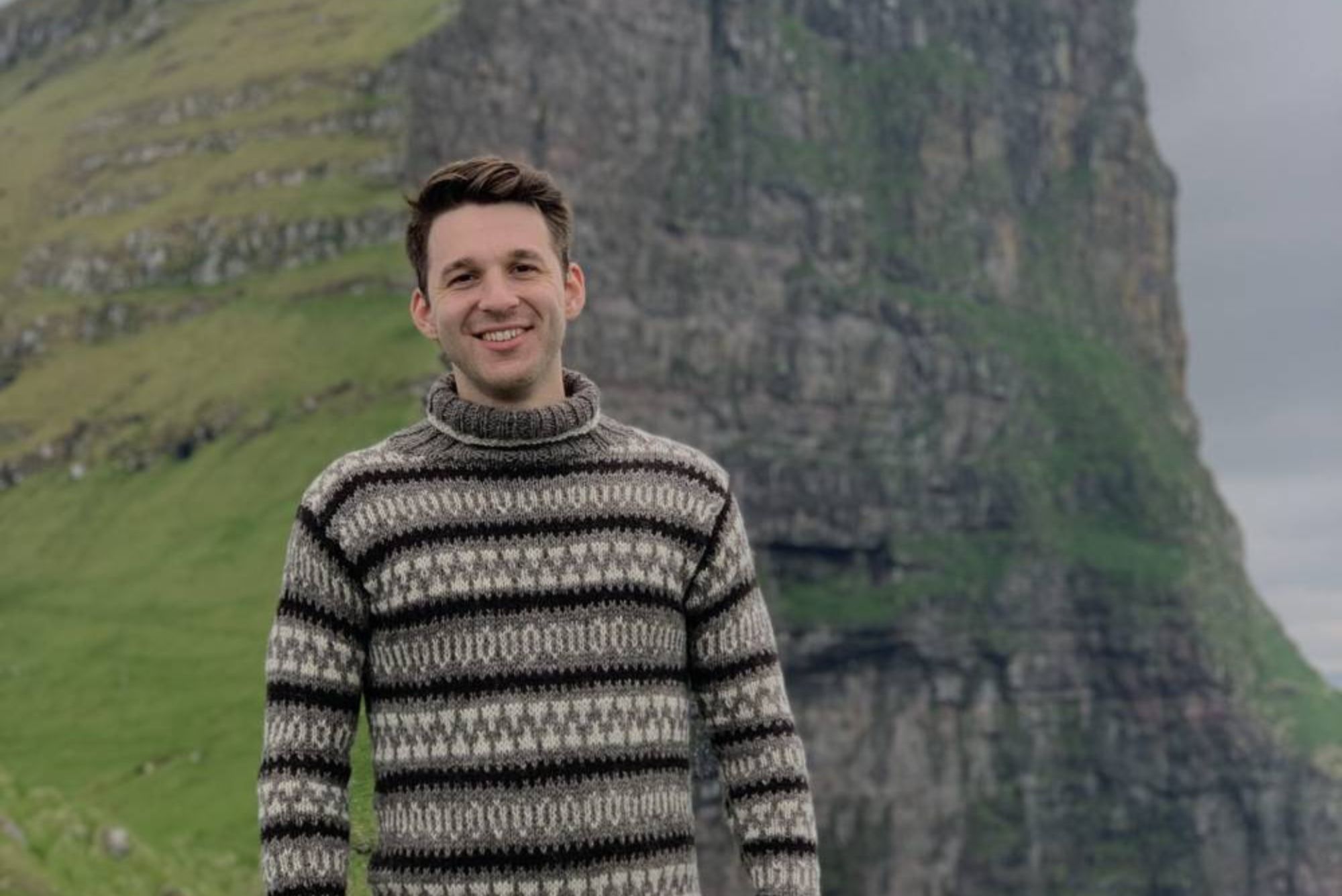
The most unique accommodations
Accommodation options are central to our travel experiences. We provide REMÓT Travelers with two accommodation options: Cottage Retreat and Hotel Relief. In both cases, the accommodations have been carefully viewed and selected. Cottage Retreat offers hand-vetted remote accommodations around the Faroe Islands, situated in slow-moving and charming villages.
Hotel Relief offers best-in-class hotel accommodations with trusted partners, showcasing Faroese luxury and comfort from its best side.
Read 5 more reasons why you should book your Faroe Islands Tour With REMÓT TRAVEL
Types of faroe islands tours.
- Private Escorted Tours
- 100% private and always escorted by a Faroese guide
- Perfect for celebrities or publicly known figures looking for a true escape
Holiday All-Inclusive Packages
- Every aspect of your itinerary is thought through: transportation, accommodation, food, experiences and more
- Perfect for couples and families looking for pre-booked experiences
- Adventure Tours
- Explore the Faroe Islands with adrenaline-filled adventures
- We have access to Faroese athletes & adrenaline junkies to create one-of-a-kind tours that you won’t find elsewhere
- Helicopter Tours
- See the archipelago from above, capturing different angles that you won’t see from the ground
- Luxurious helicopter tours can be paired with other private transportation
- Hiking Tours
- Climb cliffside peaks and rugged terrain that makes the Faroes mystically magnificent
- Every tour is bespoke for different levels of hikers
FAQs about REMÓT TRAVEL’s Tours of the Faroe Islands
What makes your faroe islands tours different from others.
Our tours are 100% bespoke with itineraries designed just for you. No pre-set number of days or activities. No traveling with other strangers. We ensure that your experience is unlike any other.
How far in advance do we need to book our tour of the Faroe Islands?
Most of the time, we can book your tour of the Faroe Islands within a few weeks. However, the best time to book is at least 2 months out from your excursion so we can ensure you get the exact accommodations, experiences, and dining.
Can your tours accommodate certain disabilities or restrictions?
We try to accommodate everybody for our customized tours. Please reach out and let us know about your unique situation and we will do everything possible to create an itinerary that provides an amazing tour of the Faroes.
REMÓT TRAVEL Vestara Bryggja 15, 100 Tórshavn Faroe Islands
Quick Links
- All Inclusive Holiday
- Faroe Island Luxury Hotels
- Luxury Wedding Faroe Islands
- Sustainability
- Terms & Conditions
- Privacy Policy
Connect With Us
Sign up to our newsletter, copyright © 2024. remót | all rights reserved.

Privacy Overview


Journey to Europe's Best-Kept Secret
Hiking the faroe islands.
From $5,295
Moderate to Strenuous
Call 1-800-368-2794 or contact us for any questions
The incredibly isolated Faroe Islands, halfway between Scotland and Iceland, are a breathtaking archipelago of soaring sea cliffs, cozy harbor villages, and famously shaggy sheep. We'll hike airy ridge trails above narrow fjords, along sea cliffs, above the ethereal hanging lake of Sørvágsvatn, and to Vidoy for incredible panoramas over the five northernmost Faroese islands. As we explore, we'll be welcomed into homes, watch traditional Faroese dancing (derived from medieval ring dances), and enjoy a round of beers at the islands' oldest brewery. The seafood here is hook-to-table fresh, and we'll savor meals in the company of knitters, chefs, and artists as we experience the genuine culture of the Faroes.

Arrive: Sørvágur, Faroe Islands
Depart: Sørvágur, Faroe Islands
- Discover the Faroes' stunning coastal hikes and rich seafaring heritage
- Sample Faroese cuisine, including superb fresh-caught fish
- Sip beer at the oldest brewery on the islands
- Meet artisans, dine with local families
- Enjoy welcoming hotels and guesthouses—some hikes start right from the front door!

Dates & Pricing
Pricing below is per person and based on double occupancy. The earlier you book, the more choice you’ll have. WT also has the most generous cancellation and transfer policies in the industry, we make it easy if you change your mind. Have a small group of your own? Take over an existing date or choose your own. You’ll have your own private guide–and the adventure–all to yourselves!
Payment & Cancel Schedule
$600 due at time of reservation 90 days prior to departure: Balance
Cancellation & Transfer Schedule
Up to 91 days prior to departure: No Charge! 61-90 days prior to departure: 25% of trip cost 46-60 days prior to departure: 50% of trip cost 45 days or less: 100% of trip cost
- Expert leadership of a Wilderness Travel Trip Leader and local guides
- Accommodations in hotels and guesthouses
- All meals included except 1 dinner as indicated in Detailed Itinerary
- A glass of wine or beer with dinner
- All ground transportation and baggage handling from meeting until departure
- All activities as indicated in Detailed Itinerary
Not Included
- Travel to and from the arrival and departure location as indicated in Detailed Itinerary
- Additional hotel nights outside the trip's scheduled dates
- Optional gratuities to Trip Leaders or staff
- Optional travel insurance
- Other expenses of a personal nature (some alcoholic beverages, laundry, etc.)
Accommodations
Scroll through our signature accommodations for this trip below. Although it is highly unlikely, we may make substitutions when necessary.
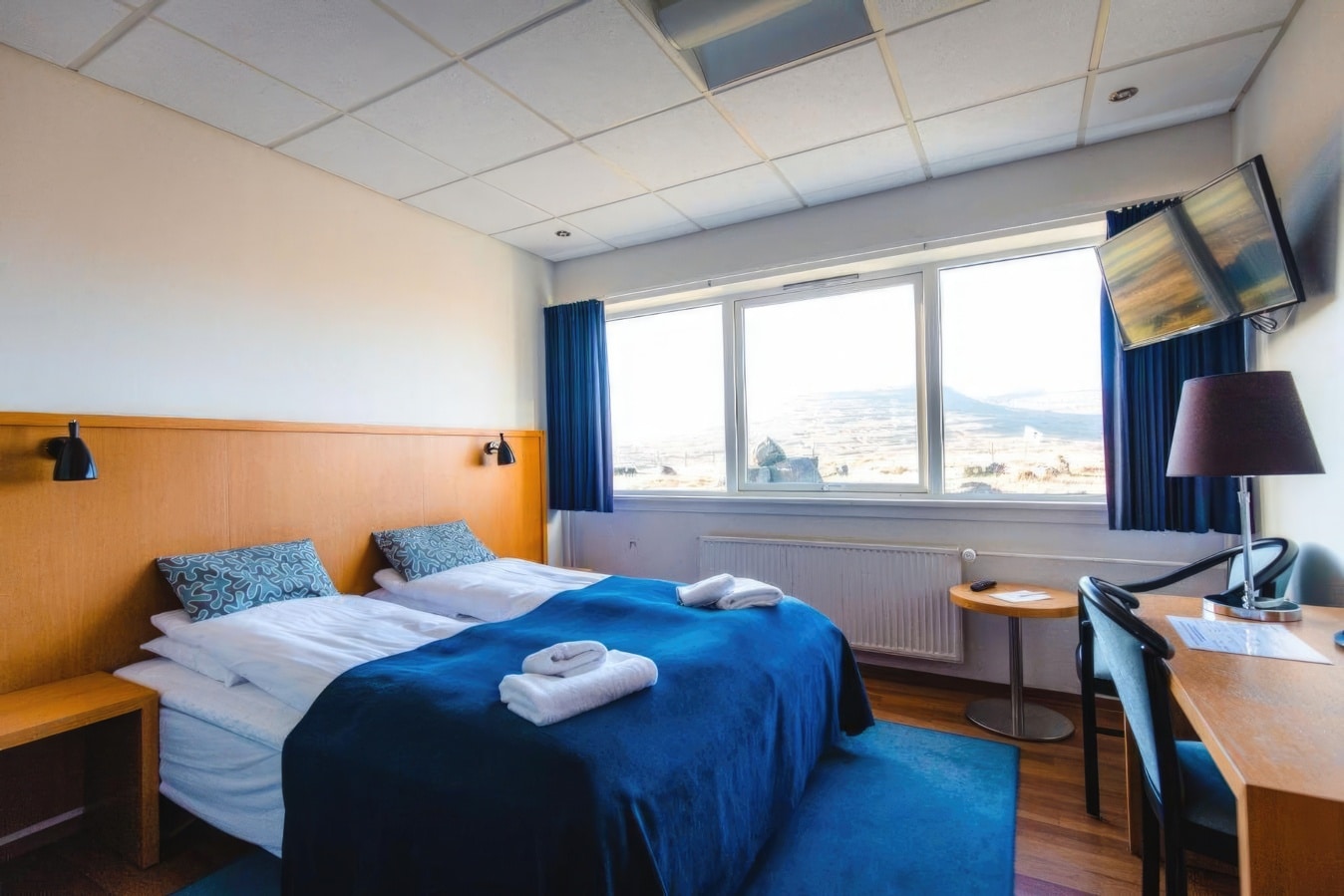
Hotel Vágar
Sørvágur, Faroe Islands, Denmark
Days 1-2 (2 nights)
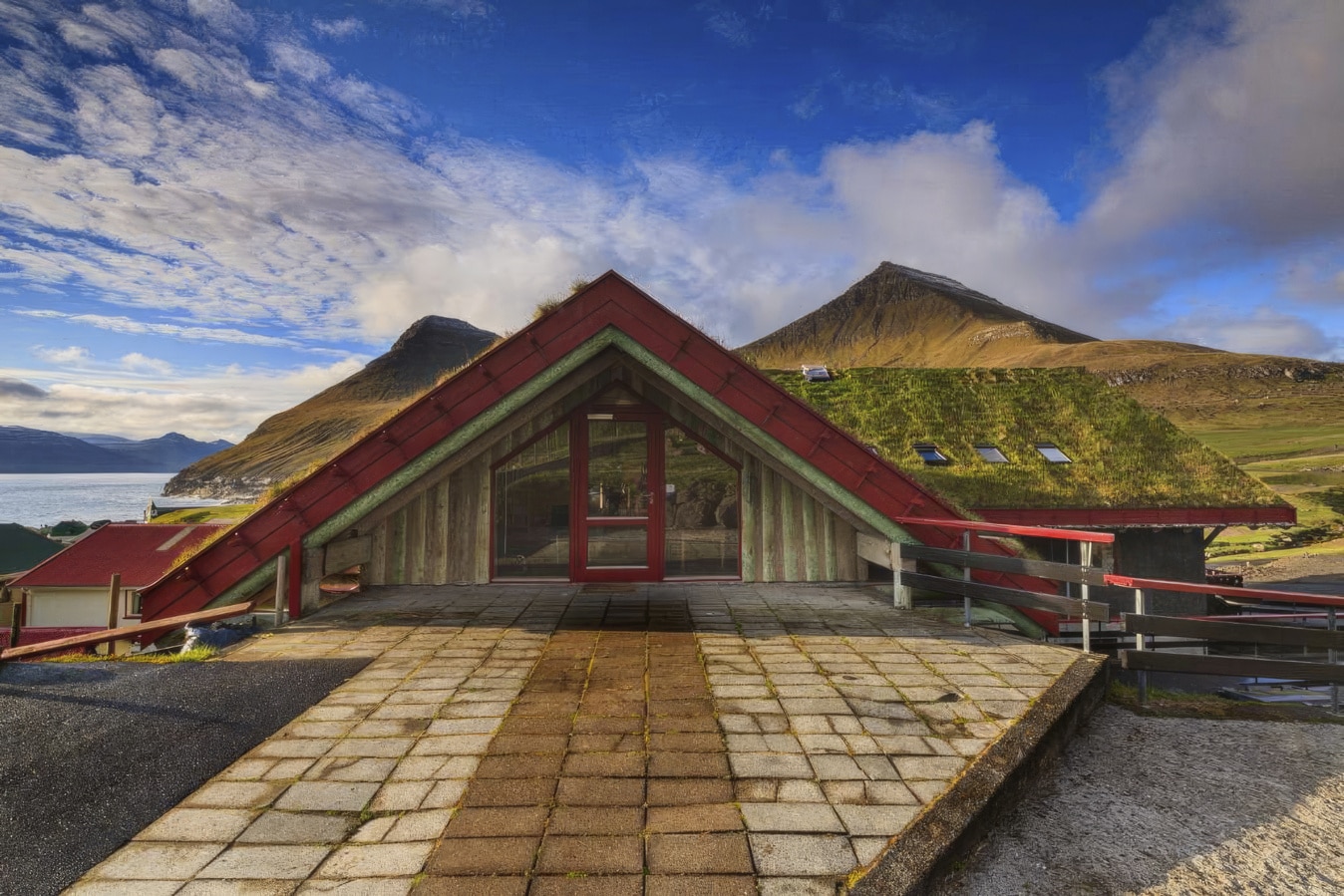
Gjáargarður Guesthouse
Gjógv, Faroe Islands, Denmark
Days 3-5 (3 nights)
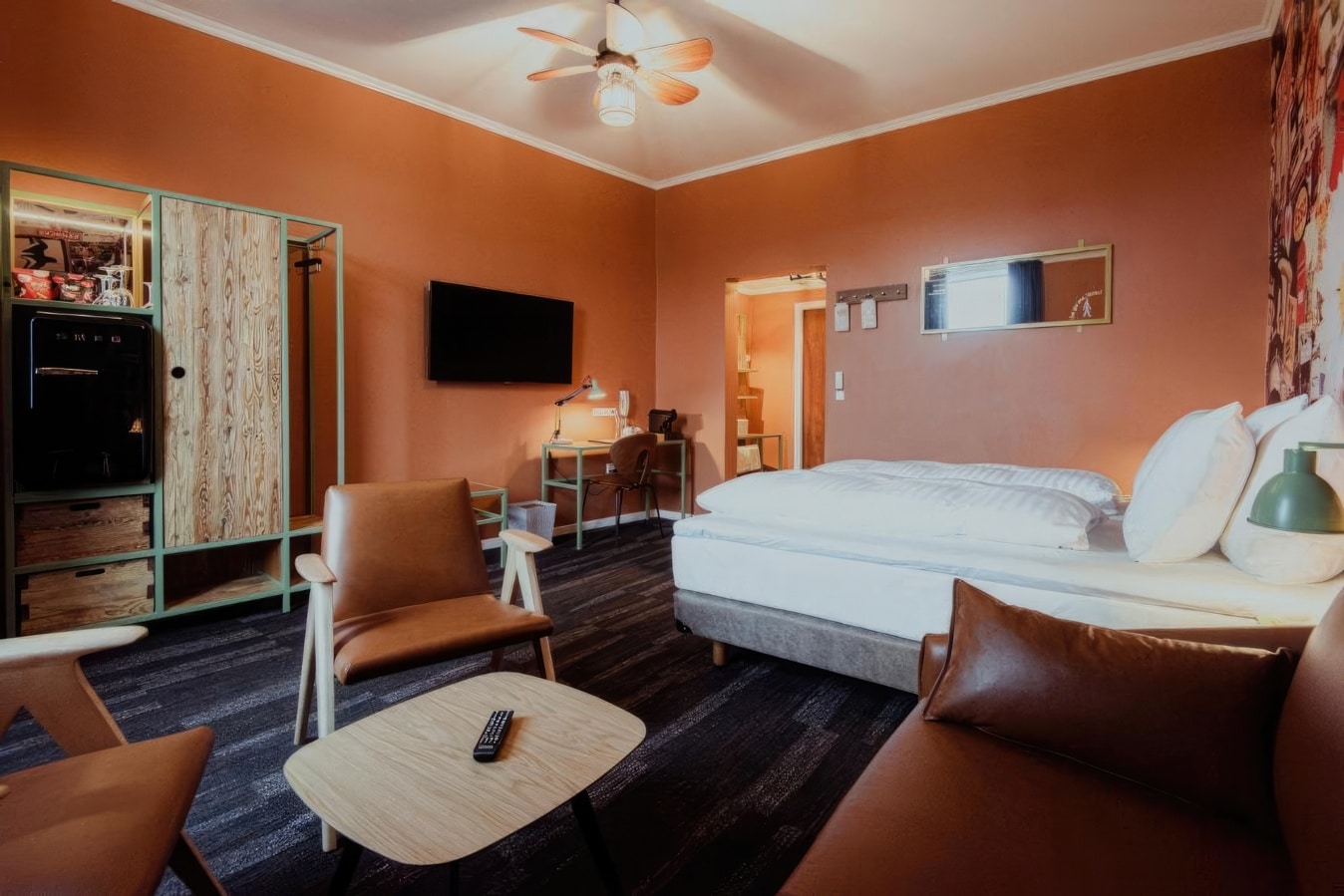
Hotel Hafnia
Tórshavn, Faroe Islands, Denmark
Days 6-7 (2 nights)
Alternate Accomodation: Hotel Brandan
Trip Leaders
Wilderness Travel Trip Leaders have a passion and a joy for creating an unforgettable journey. We are extremely proud of them and the incredible travel experiences they make possible. For more information, including client comments about them and which specific trips they will be leading, please click on their profiles below.
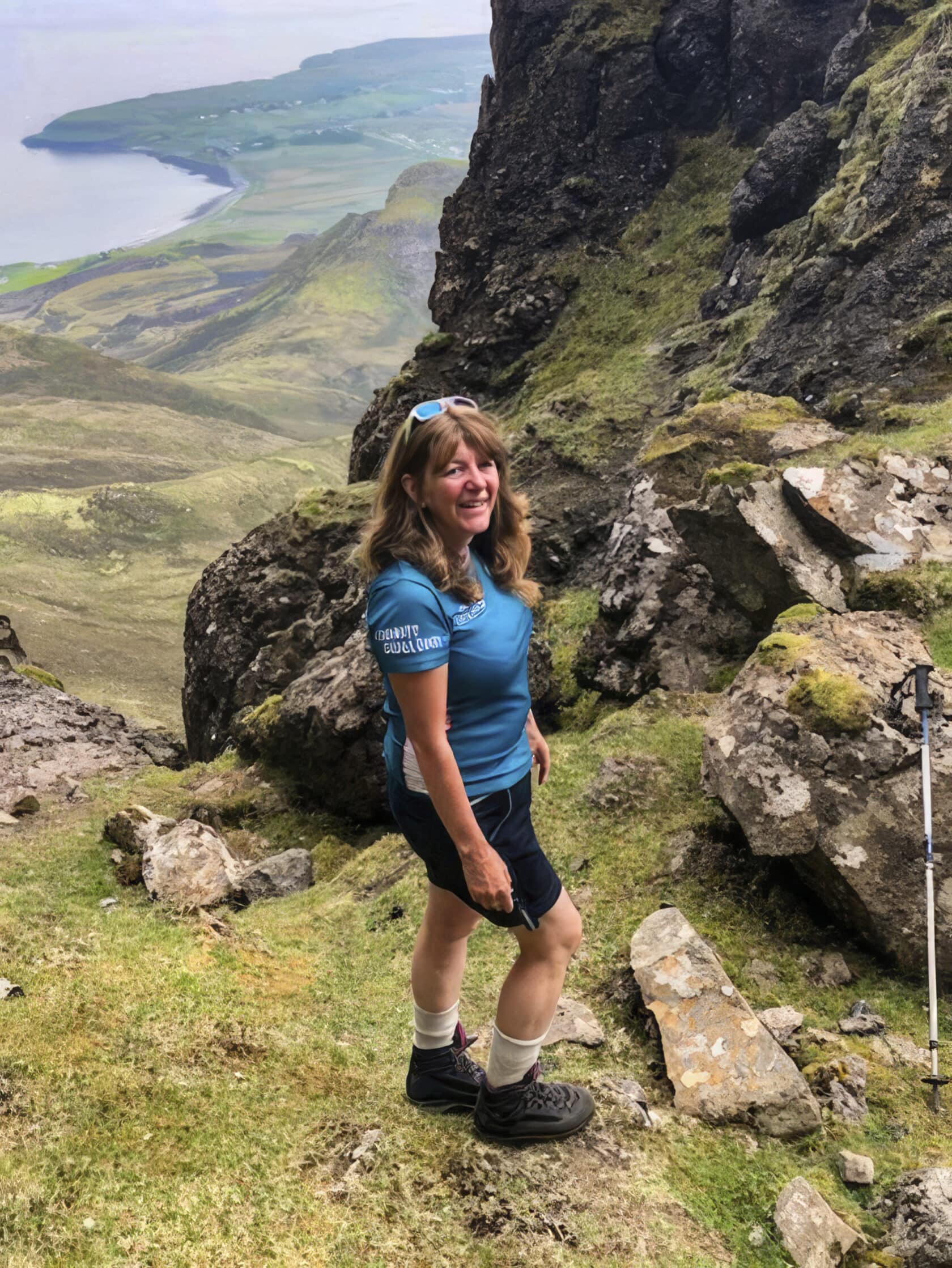
Angela Gillespie
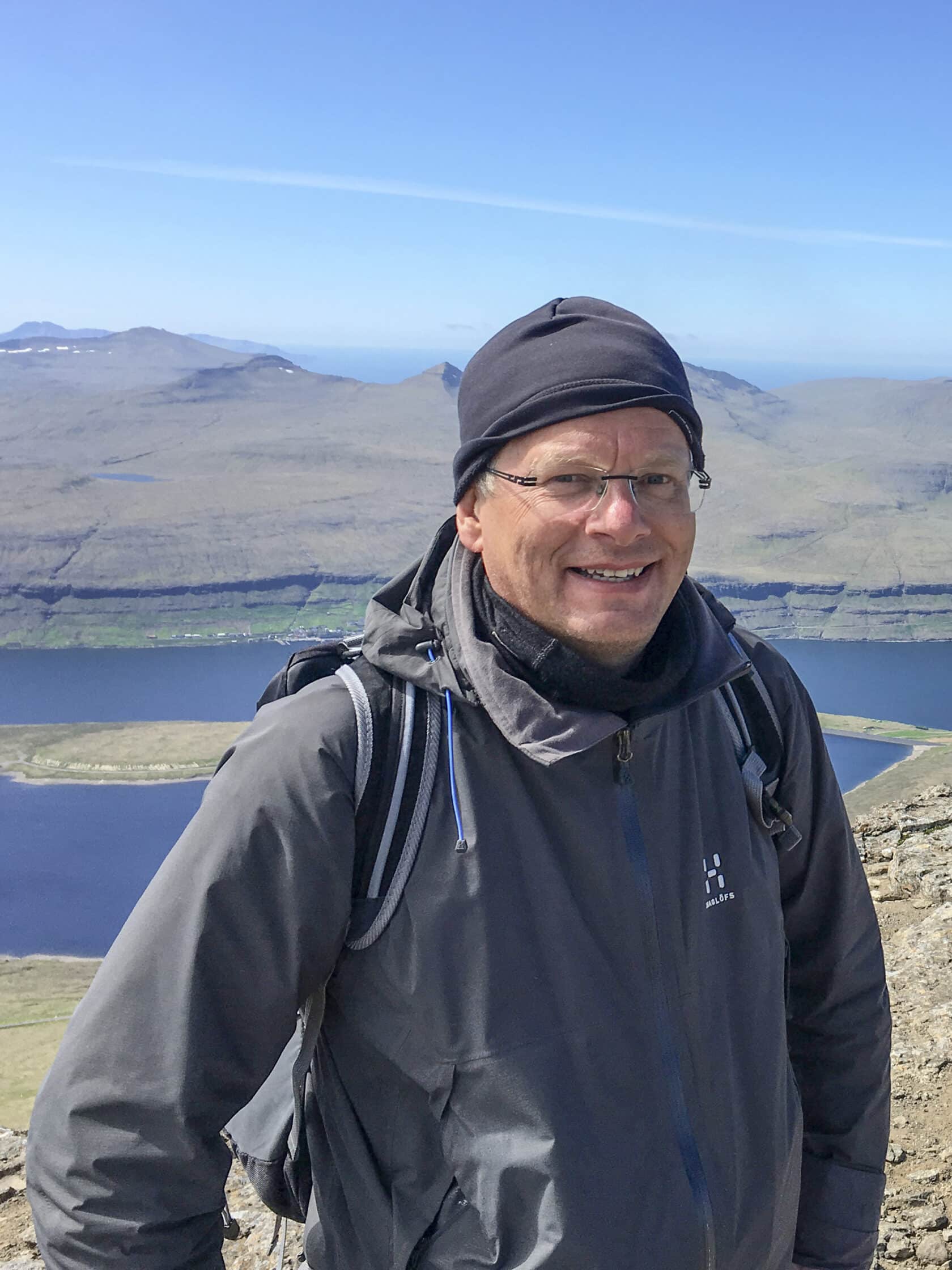
What the Trip is Like
- 1,000-1,200 feet gain/loss
- Day 6: 4.5 miles, 4 hours, and 1,700 feet gain/loss
Client Testimonials
"A fantastic hiking/cultural experience in a uniquely beautiful island group!"
Altamonte Springs, FL
"Skye's skill in identifying places and people ensured a wonderful balance of hiking, cultural experiences, and time in the homes of Faroese people. We had access to very unique places and met people who added their personal perspectives to life in the Faroes."
W Montrose, Ontario
"I've wanted to hike in the Faroe Islands for more than 20 years and was glad that Wilderness offered the trip. There was spectacular scenery, great accommodations, and a guide who cared about our experiences—in towns, beautiful churches, and the arts. We had two gatherings in private homes and the Faroese were so welcoming. I would highly recommend the trip to anyone."
Fort Myers, FL
"The hiking was excellent, but I really enjoyed the home visits also. It was a unique way to experience local culture."
Emporia, KS
"This trip was wonderful. The islands are stunning, with incredibly dramatic scenery and weather. The birds, especially the puffins and oystercatchers, were amazing. The hikes were lovely, not too strenuous and appropriate for the group traveling."
Saratoga Springs, NY
"One of the best trips I've been on. The Faroes are magnificent to behold, the hiking was fabulous, and the views were jaw dropping stupendous."
Larkspur, CA
"Loved the home visits with locals for tea, post-hike snacks, lunch and dinner. Unique experiences!"
Earlham, IA
"I enjoyed this trip so much that I almost cried when it was over. With our leader, there was NEVER a dull moment."
Vancouver, BC
"A well-designed itinerary with a wonderful mix of hiking and cultural experiences. The cultural interactions with local residents were one of the high points of the trip. The hikes were very scenic, historic, and enjoyable."
Seattle, WA
"This trip was a wonderful introduction to the beauty of the Faroe Islands and the culture and history of the Faroese. The people we met generously offered us their hospitality, culture, history, and personal stories."
"This trip exceeded my expectations—and I had fairly high expectations. Our guide and the itinerary design were excellent."
Sioux Falls, SD
"This was such a fabulous trip in such a beautiful country. I loved the exercise and I loved so many of the cultural events—visiting the artist, the brewery, the old farmhouses, the churches, Oliver's boat trip. It was just great."
Baltimore, MD
Other Trips You Might Like

Small Group Adventure
Hiking in Norway’s Fjord Country
From $7,195
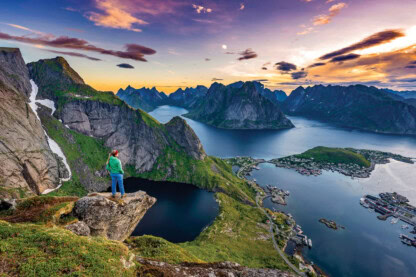
Hiking Norway’s Lofoten Islands and Beyond
From $6,995

Hiking the Fjords of Greenland and Iceland
Greenland, Iceland, Denmark
From $9,995
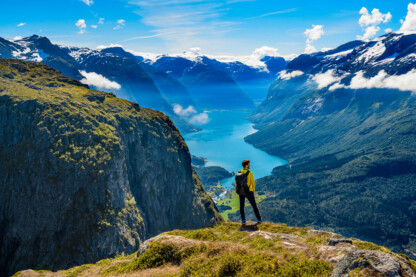
Norway: Hiking Alesund and the Sunnmore Alps
From $8,595
Book your trip today
Our Area Specialists know every detail about our tours. They will be happy to answer any questions and help you choose the journey that’s right for you. Contact us to learn more or book your trip today!
Submit the form below to download itinerary
Trip Download Itin
Trip Levels
With more than 200 different adventures to choose from, we want to help you find the trip that’s right for you. Our Trip Level system ranks each trip in two ways: a number rating from 1 to 6 according to the activity, and general travel rigors. 1 is the easiest and 6+ the most difficult—see descriptions below for explanations of each number. A plus (+) sign means the trip is a bit more strenuous than other trips of that level. The detailed explanation of each trip—below the bar with the number rating—is perhaps more important, specifying activities, altitudes, hiking, and travel conditions. The Detailed Itinerary, available by download or mail, gives further information. Our Area Managers can also answer questions and guide you to the trip that best suits your interests.
Level 1 – Easiest
Non-camping journeys, optional walks, little elevation gain or loss.
- Royal Rajasthan and Villages of India
- Small ship cruises
Level 2 – Easy to Moderate
Hotel nights and/or safari-style camping, hikes of two to four hours on some days. Other physical activities are sometimes included, such as optional sea kayaking.
- Our African safaris
- Costa Rica Wildlife
Level 3 – Moderate
Half- to full-day hikes (3-6 hours) over rolling countryside on most days, occasional steep trails. Many of our hotel-based walking tours are in this category, as are our snorkeling adventures.
- Tuscany & the Cinque Terre
- Argentina: Hikes and Estancias of Patagonia
- Palau Snorkeling & Sea Kayaking
- Some trips with minimal hiking but rugged travel conditions or long drives, such as Tribal Ghana, Togo & Benin, are Trip Level 3.
Level 4 – Moderate to Strenuous
Full-day hikes (4-6 hours), mountainous terrain, significant elevation gains and losses (hiking up or down as much as 3,000 feet) on many days. Altitudes no greater than about 10,000 feet.
- Ultimate Patagonia
- Hiking the Spanish Pyrenees
Level 5 – Strenuous
Full-day hikes (4-8 hours), mountainous, steep terrain (hiking up or down as much as 3,500 feet) on many days. Trips with hiking at average altitudes of 10,000 to 12,000 feet are in this category.
- Inca Trail to Machu Picchu
- Everest Lodge to Lodge
Level 6 – Very Strenuous
Full-day hikes (5-8 hours), mountainous, steep terrain (hiking up or down as much as 3,500 feet) on many days. Most hikes take place at altitudes above 10,000 feet, with some days ascending as high as 18,000 feet.
- Everest Base Camp
- Climb Kilimanjaro!
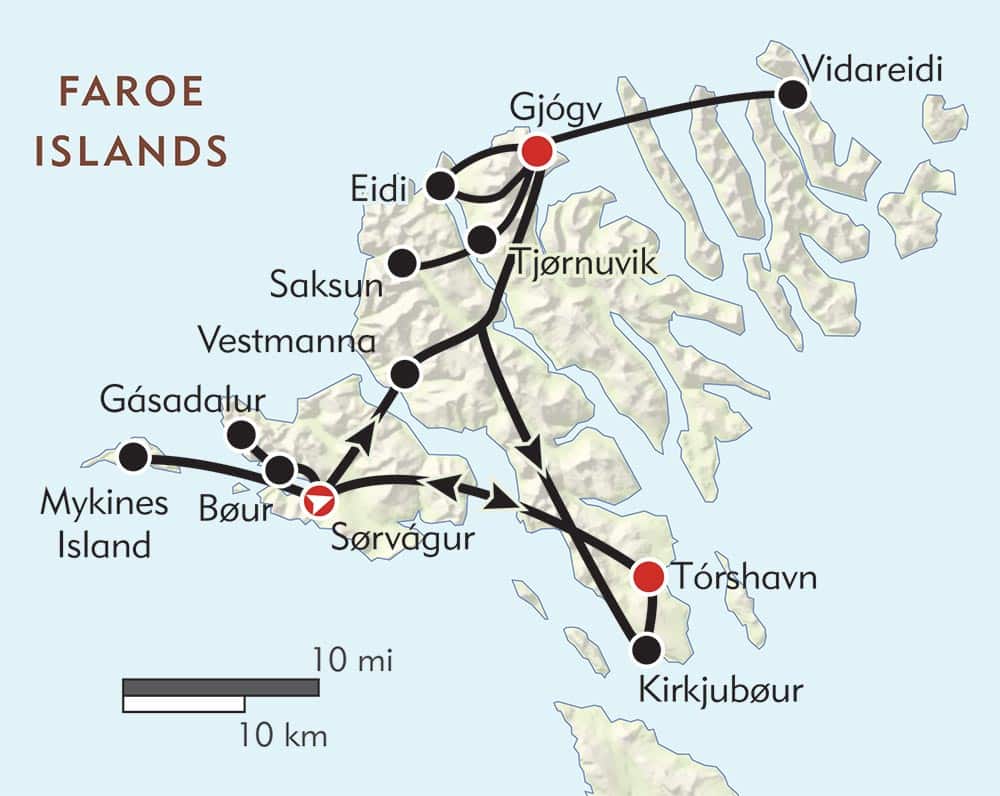

IMAGES
COMMENTS
There is a newer edition of this item: Faroe Islands (Bradt Travel Guide) $22.51. This title will be released on July 1, 2024. This new, thoroughly updated 5th edition of Bradt's Faroe Islands remains the only English-language guide to this isolated, unspoiled archipelago, home to Tórshavn, the world's smallest capital, and where there are ...
James Proctor first visited the Faroe Islands in 1992 on board the Smyril ferry sailing from Aberdeen and has been back and forth ever since. Accompanied half of the way by a pod of dolphins and buffeted by gale force winds and stormy seas during the rest of the journey, James's love affair with the North Atlantic got off to a flying start.
In "Faroe Islands Travel Guide 2023" we cordially invite you to take an unforgettable trip to the Faroe Islands, where the unadulterated splendor of nature and the depth of human culture meet. Through the pages of our book, explore this alluring archipelago and discover the magic for yourself.
Faroe Islands. The forgotten Faroes are just a short flight from the UK, yet they're way off the standard traveller's radar. Adrift in the frothing swells of the north Atlantic, this mysterious 18-piece jigsaw puzzle of islands is at once ancient and very modern. Multicoloured cottages and grass-roofed wooden churches add focus to the ...
The climate is heavily influenced by the surrounding ocean currents and prevailing winds. In general, the temperature rarely rises above 15°C (59°F) even in the spring and summer, and can drop down to around 5°C (41°F) in winter. It rains frequently throughout the year. Planning your trip to the Faroe Islands.
Faroe Islands travel guide. Holiday tips and expert advice from Tórshavn hotels and restaurants to birdwatching, transport, hiking, festivals and culture. Plus wildlife sites such as the Vestmanna bird cliffs (puffins!), Mykines, Akraberg, Suðuroy Cliffs, Kalsoy, Gjógv, Klaksvík, Nólsoy, G! Festival, sea kayaking, folk dancing, wool and sweaters.
Faroe Islands. Arguably best known for their dramatic appearance in the BBC shipping forecast, the Faroe Islands are still one of Europe's best-kept secrets. James Proctor, author of Faroe Islands: the Bradt Guide. Wild, wet and windy, these 18 volcanic islands, far out in the North Atlantic, are a different world - a realm of austere ...
Summer in the Faroe Islands, from June to August, is the most popular time to visit. With temperatures ranging from 10°C to 15°C (50°F to 59°F), this is the warmest season, and the days are long, often with nearly 24 hours of daylight. It's an ideal time for hiking, wildlife exploration, and outdoor activities.
The islands are characterized by Denmark's most dramatic scenery and an abundance of sheep - which, incidentally, outnumber humans and have fuelled the trade in Faroese woollen products since being worn by the cast in the iconic Danish TV series The Killing. Krone is the currency, and Danish and English are understood.
Return fare on a ferry to Suduroy island was 225 DKK (30 EUR) for a car and a driver. A 7-day unlimited ferry & bus pass costs 700 DKK (95 EUR). Buses within Torshavn are free of charge. Guided tours in the Faroe Islands aren't cheap, however, they usually include everything and allow you to see a lot in a short time.
Faroe Islands. $28.99. This title will be released on June 1, 2024. Voted the world's most appealing islands in a survey by National Geographic Traveller magazine, the Faroe Islands are situated between Scotland and Iceland. They are wild, wet and windy, and remain one of the few places in the world where life moves at a sedate pace.
An experienced travel writer specialising in the Nordic countries, he has written Bradt's Faroes, Lapland and West Sweden guidebooks and co-written other travel guides to Iceland, Reykjavik, Sweden and Finland. He now lives in North Yorkshire where he presents a daily show on his local radio station. 51 illustrations, 14 maps. $26.95. 18 %. OFF.
Your complete travel guide to Faroe Islands. Find the best tours in Faroe Islands. Best price guaranteed. Easy and instant booking! ... Top things to do in Faroe Islands. Book your complete trip with the best companies only. Adventure Tours (133) Best 2024 Vacation Packages in Faroe Islands (23) Boat Tours (31)
Here's my complete Faroe Islands travel guide and itinerary with details on the best places to explore, eat and sleep in 4 days. In the depths of the Atlantic Ocean, tiny islands with jagged peaks and vertiginous cliff faces jut out from the sea, piercing into the sky like giant daggers. Sea stacks, craggy bird cliffs and black sandy beaches ...
Scenic trails for hikers. One of the many special features of the Faroe Islands is that you don't have to go far to experience magnificent nature, with dramatic cliffs, rolling green hills, and hidden waterfalls close by, every trail offers stunning scenery and a sense of solitude. Look around you. Take a few steps. Take a deep breath and listen.
Many people travel to the Faroe Islands for just a few days, but we wanted to explore the main islands to the fullest, and so we spent 9 full days in the Faroe Islands 11 including travel days. ... You have to book it in advance, as people in the Faroe Islands don't seem to like last-minute bookings, even if the tours aren't full. You'll ...
You will need it every day and I do not recommend you travel around the Faroe Islands without a car. We scoured the internet for a rental place that's not on Google maps yet since all the bigger websites had prices as high as 1400 DKK ($2000) for 10 days. We finally found a small rental and got an older car for 5000 DKK ($730) for 10 days.
Faroe Islands (Bradt Travel Guide. Faroe Islands) $28.99. This title will be released on June 1, 2024. Still the only English-language guide to the Faroe Islands, covering everything from succulent fish suppers to remote hideaways, the Bradt guide is the definitive source of information for visitors wishing to discover the 18 islands of this ...
4 Day Summer Self Drive Tour | Top Attractions. From 1 327 USD. Filters. Book your dream vacation in the Faroe Islands with these vacation packages. Explore luxury & budget travel options. 100% adventure, 0% stress. Book now!
See the Faroe Islands the right way - through a fully-customized, uniquely-personalized itinerary. No predetermined Faroe Islands tours where you're stuck seeing and experiencing the same things that everyone else does (and with most tours, you're also experiencing those things with strangers). Book Now.
The incredibly isolated Faroe Islands, halfway between Scotland and Iceland, are a breathtaking archipelago of soaring sea cliffs, cozy harbor villages, and famously shaggy sheep. We'll hike airy ridge trails above narrow fjords, along sea cliffs, above the ethereal hanging lake of Sørvágsvatn, and to Vidoy for incredible panoramas over the five northernmost Faroese islands.
Experience the awe-inspiring landscapes and captivating culture of the Faroe Islands with the comprehensive and informative FAROE ISLANDS TRAVEL GUIDE 2023. Packed with insider knowledge and must-visit locations, this invaluable resource ensures your trip becomes an unforgettable adventure.
Travel. A 'Vacation' Spent Building Trails in the Windswept Faroe Islands? Thousands Want In. Every year, thousands of people apply to volunteer in the sparsely populated, often foggy Faroe ...
If your wanderlust craves a destination that's both enchanting and uncharted, then "Ethan Grayson's Faroe Islands Travel Guide" is your passport to an extraordinary adventure. WHAT'S INCLUDED IN THE BOOK: Historical Gems: Venture beyond the beaten path to discover tucked-away treasures like the mystical Tórshavn and the Mykines.